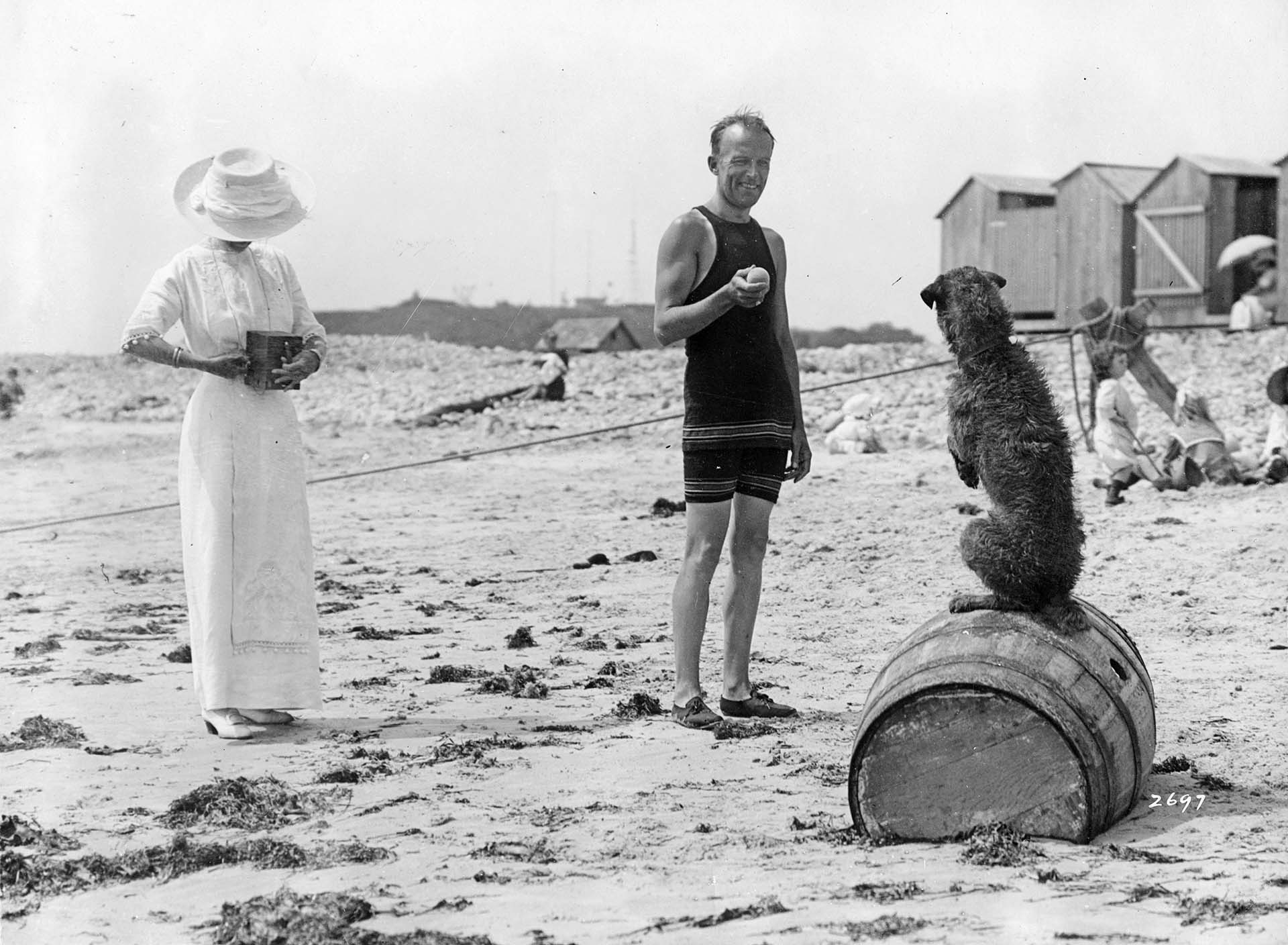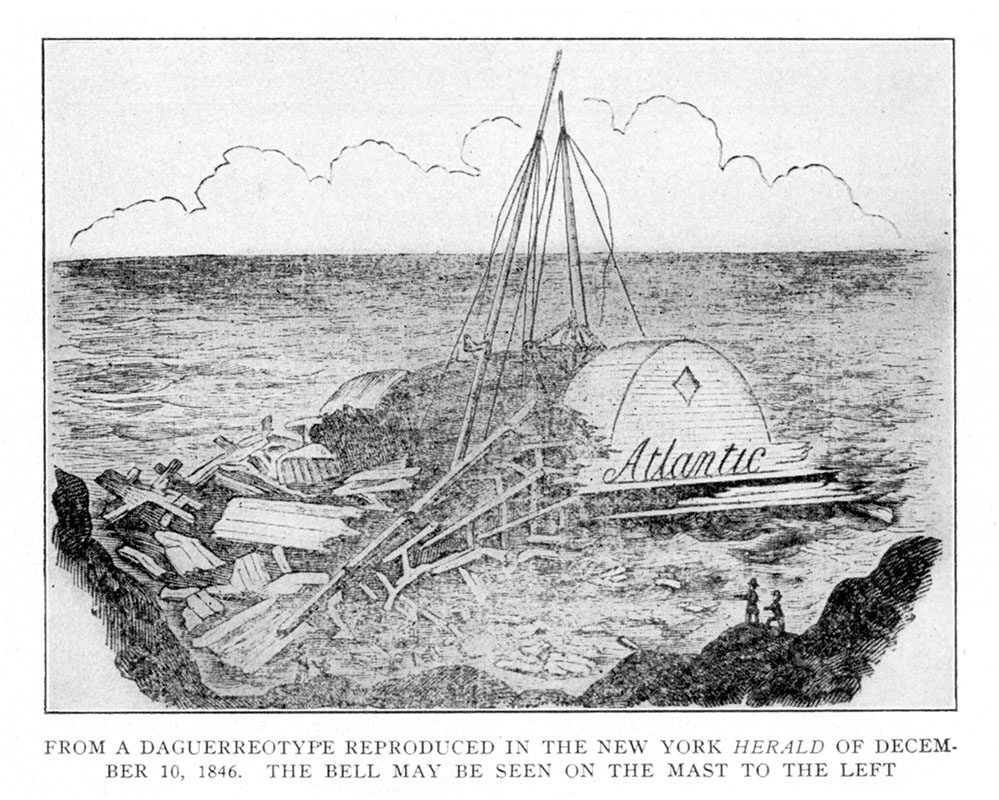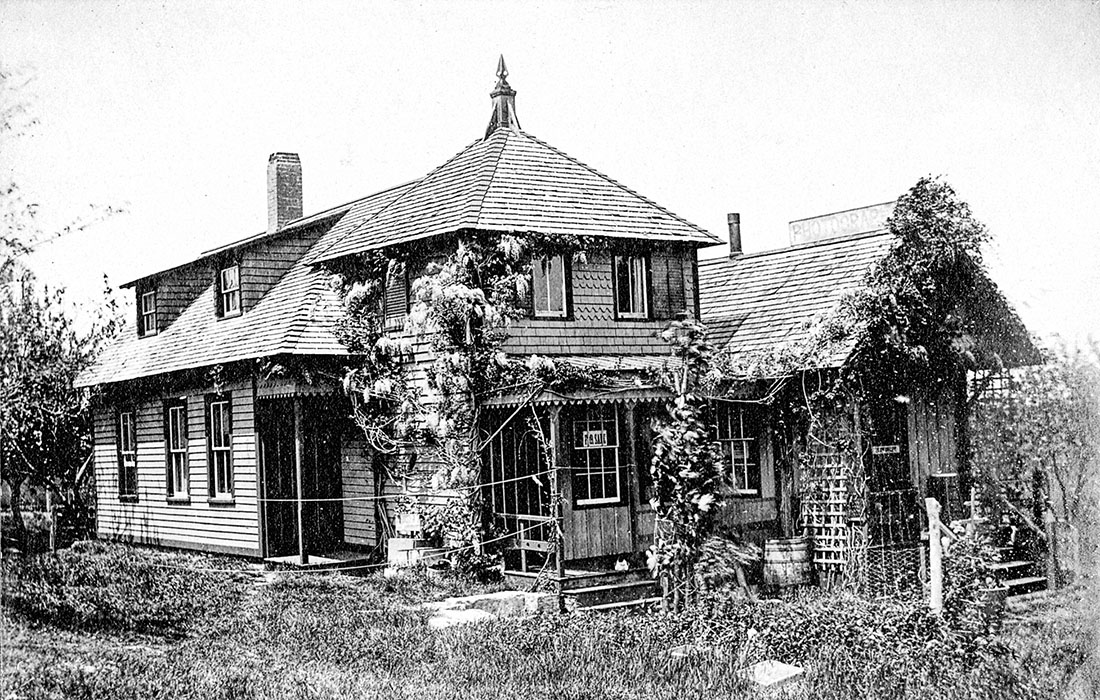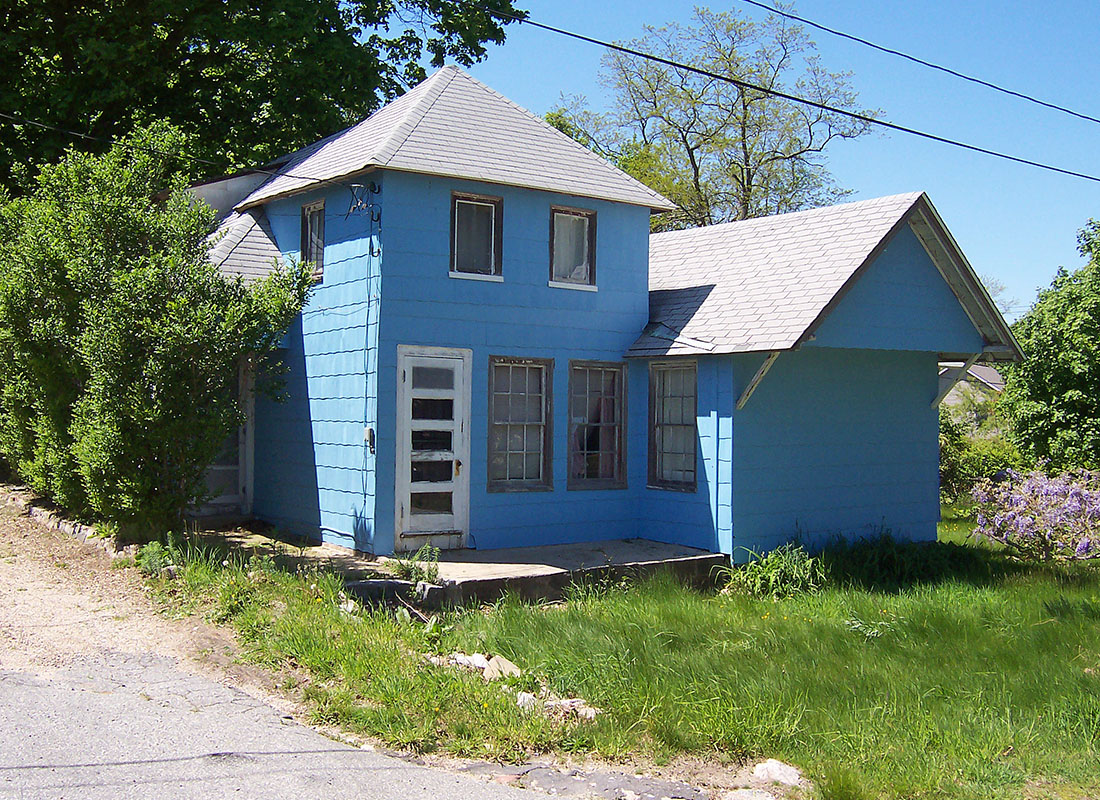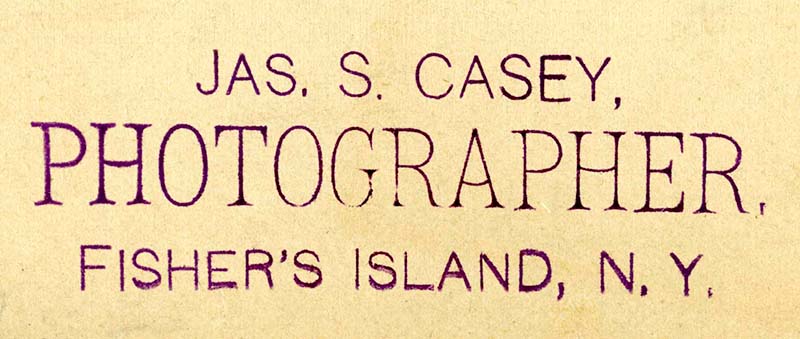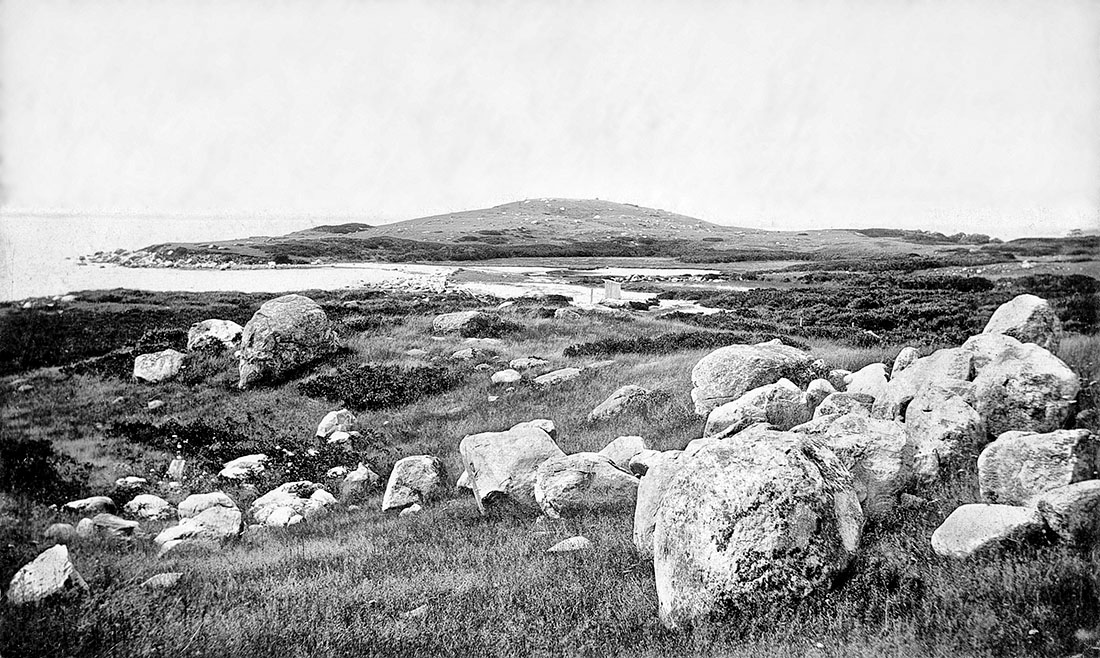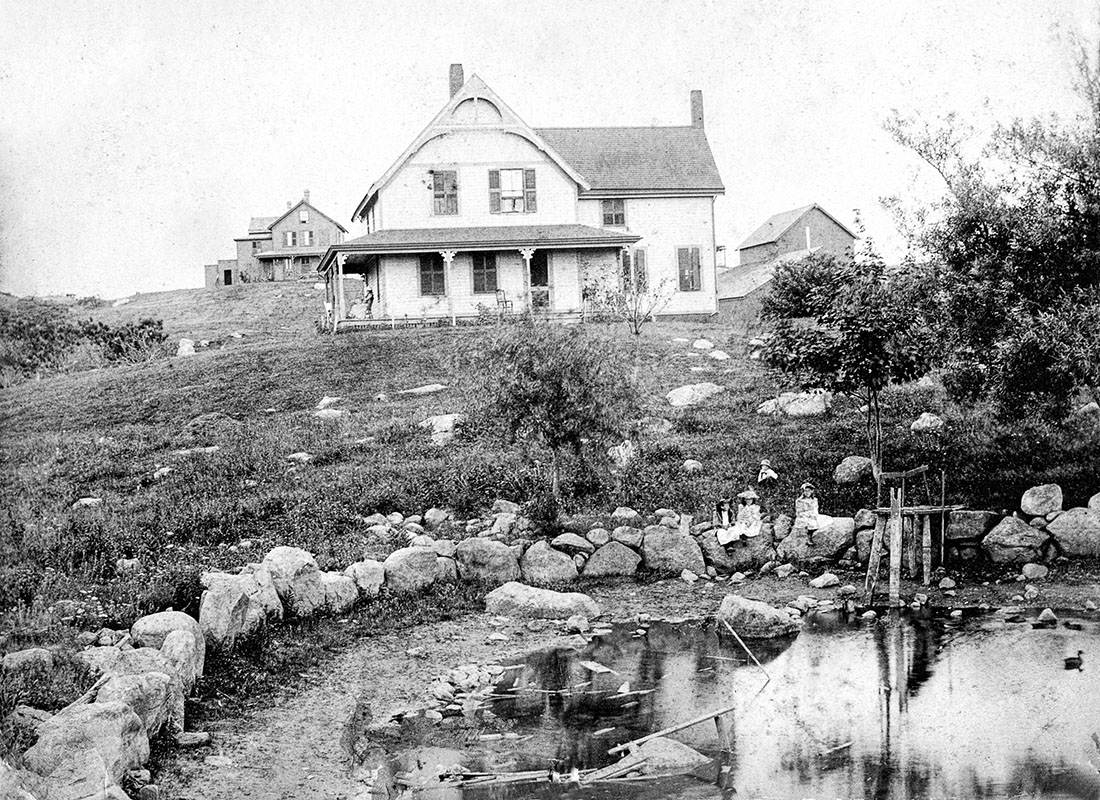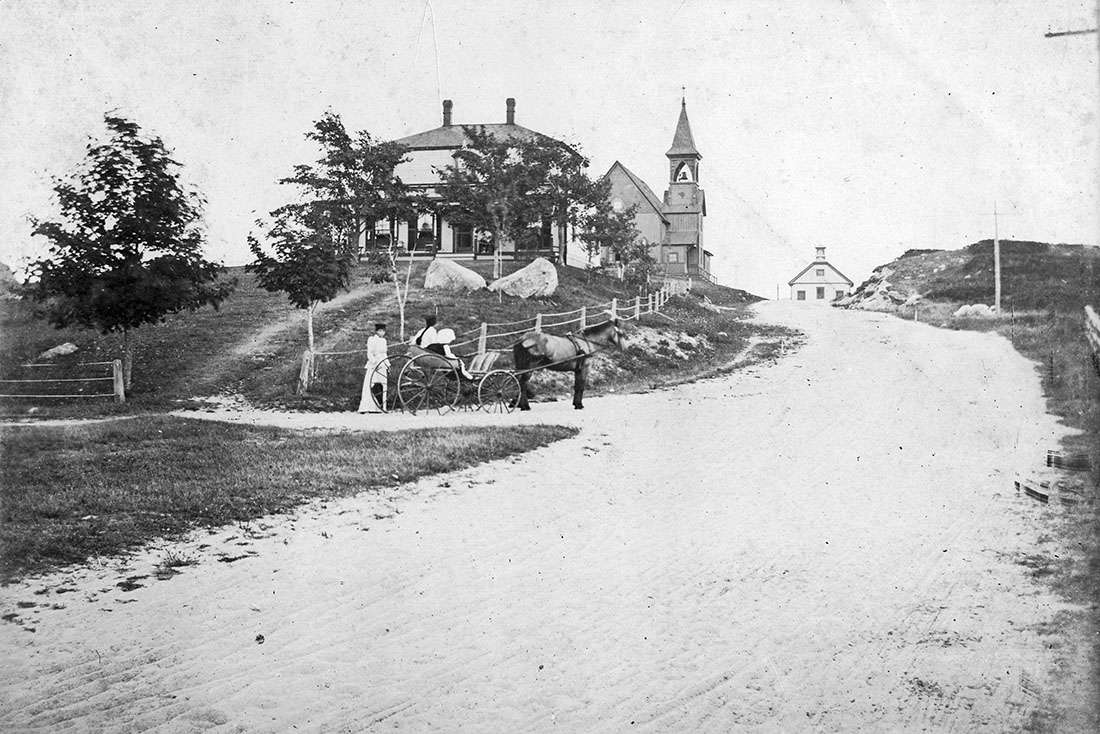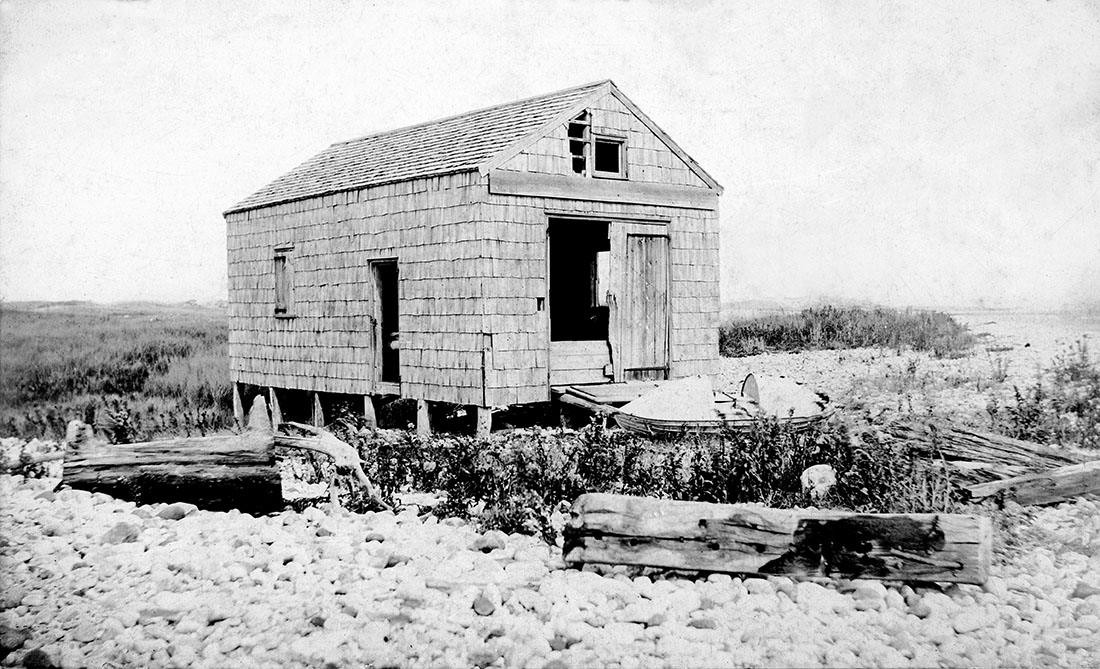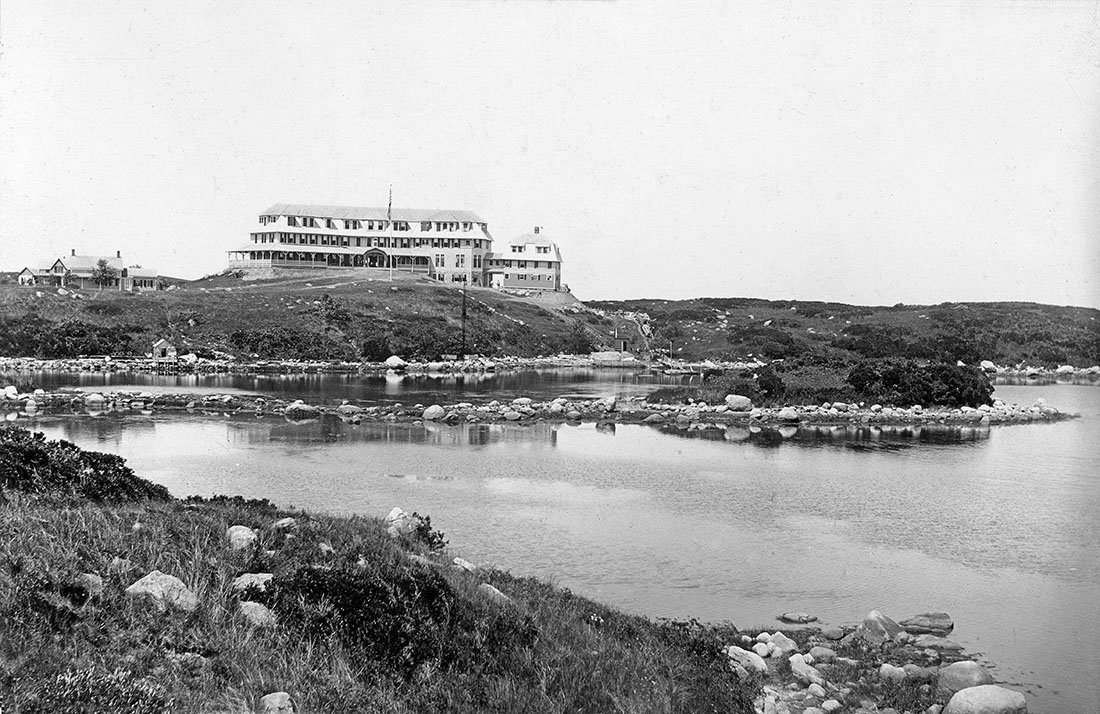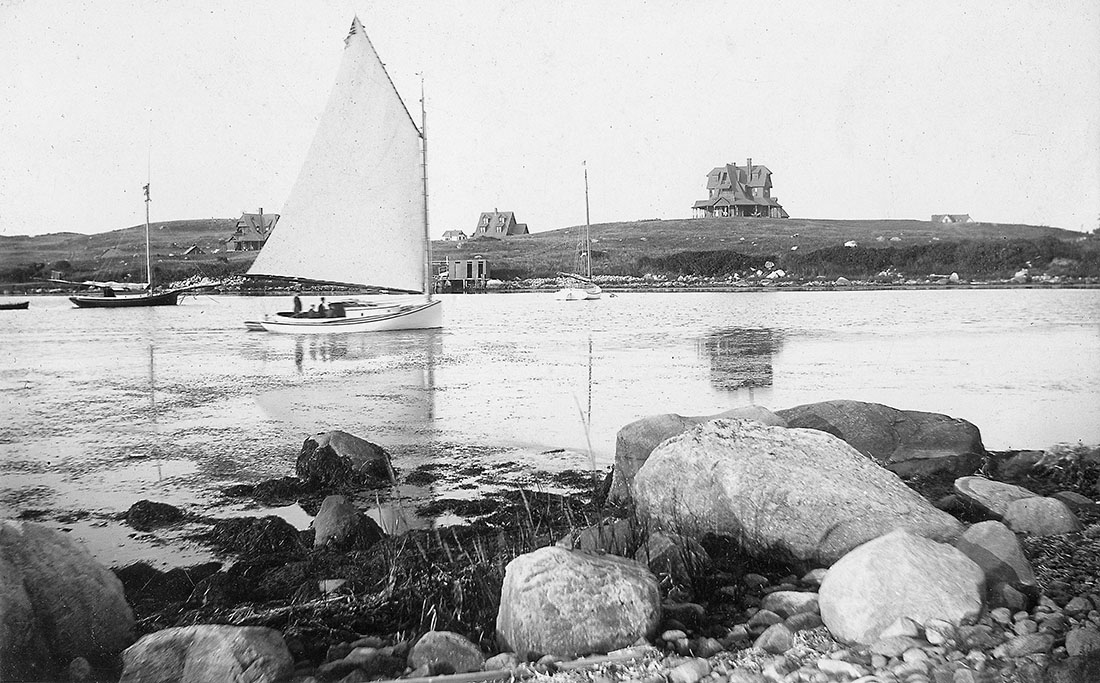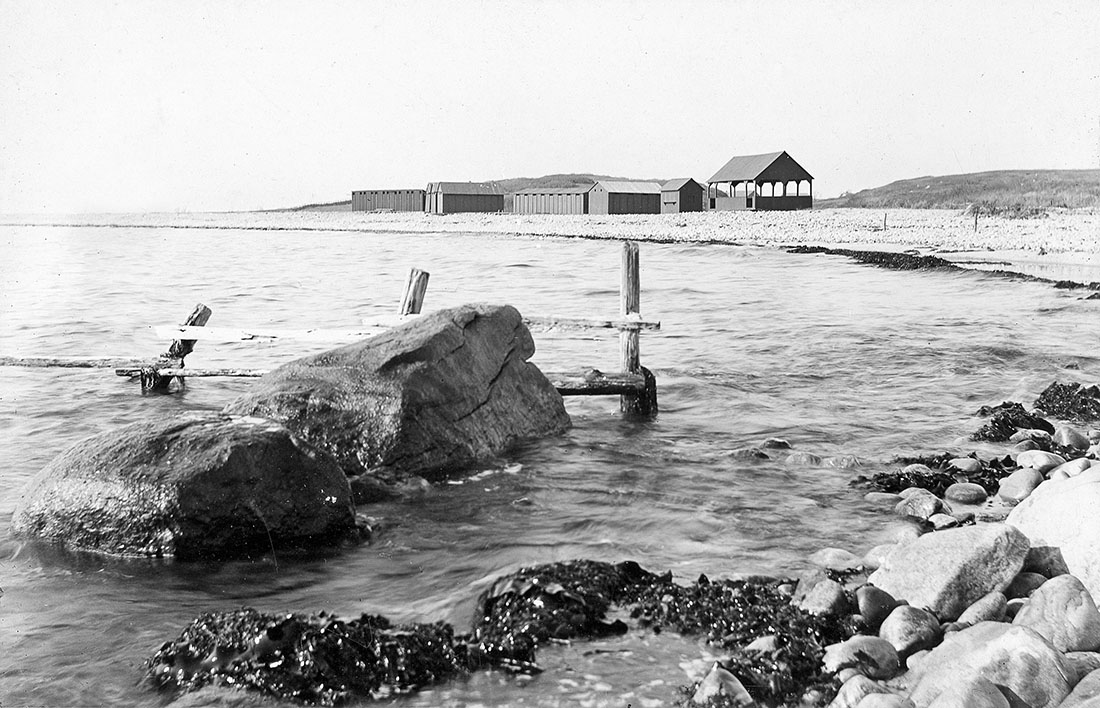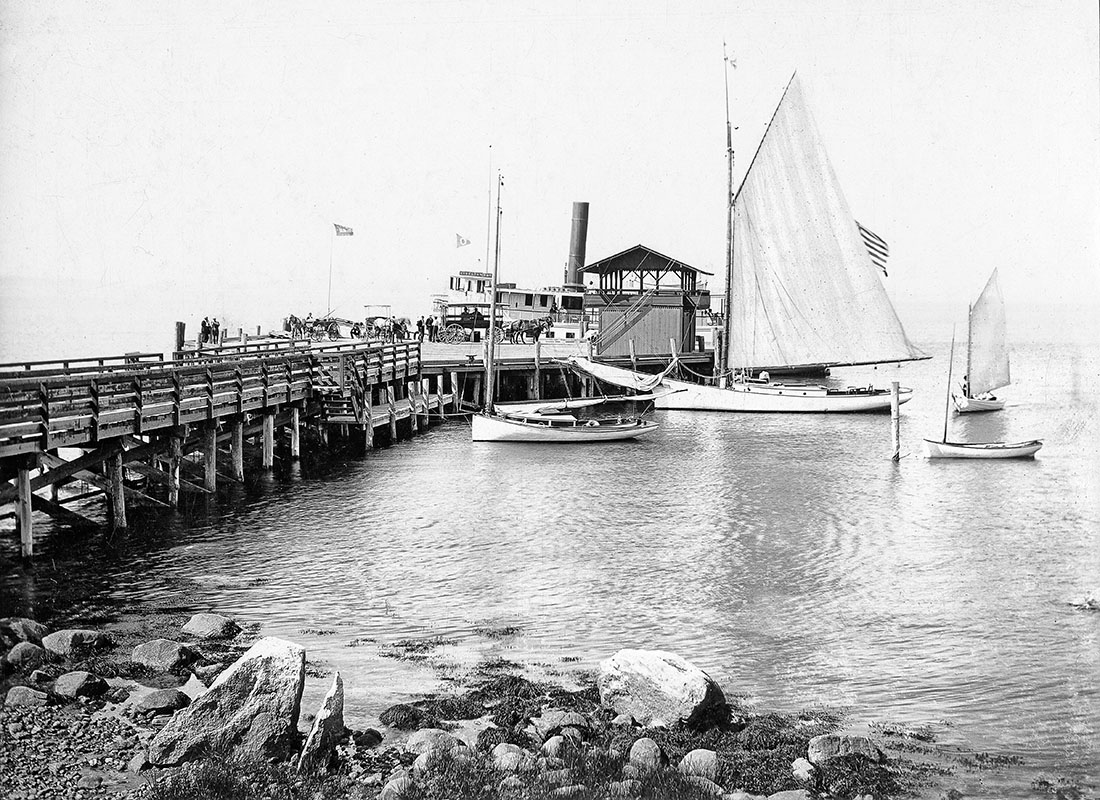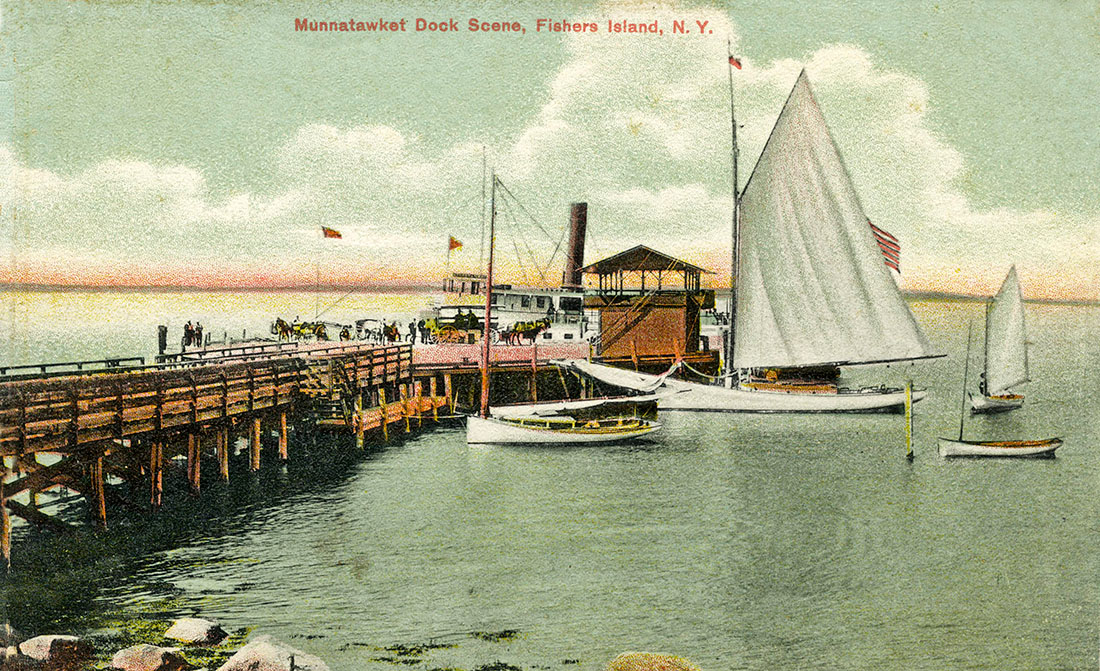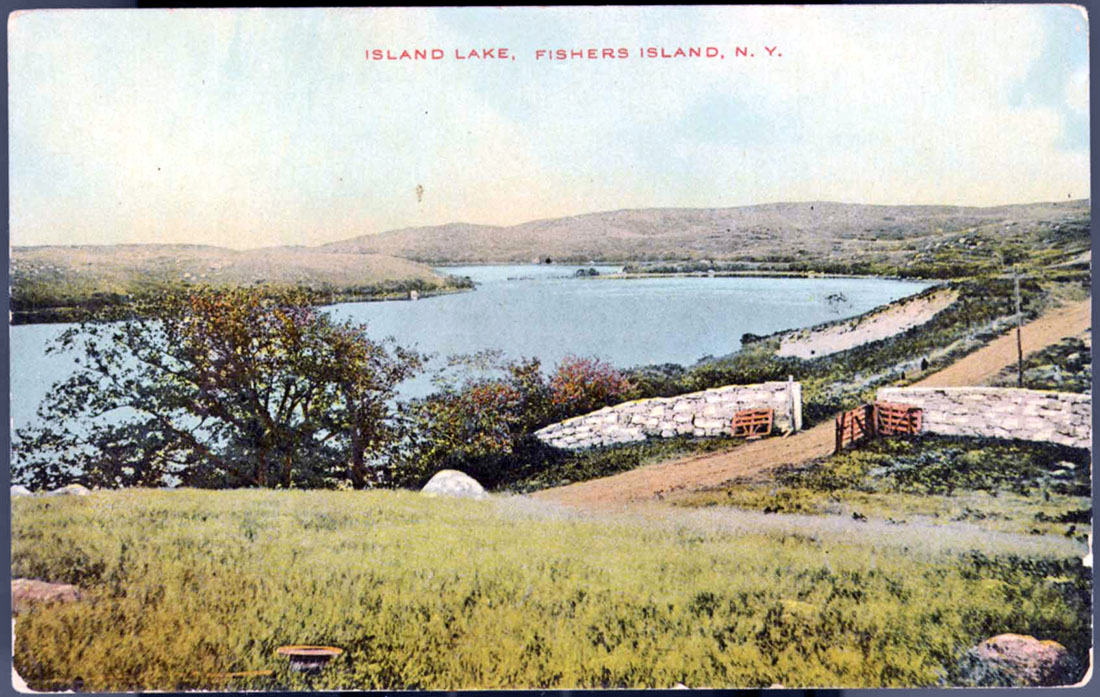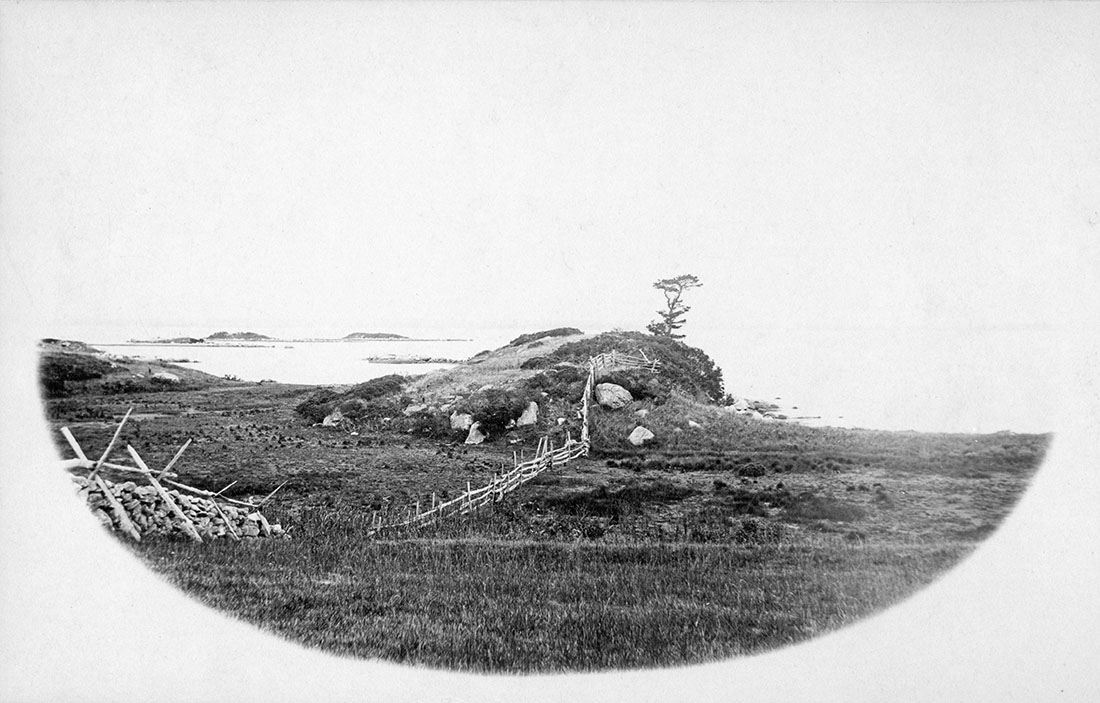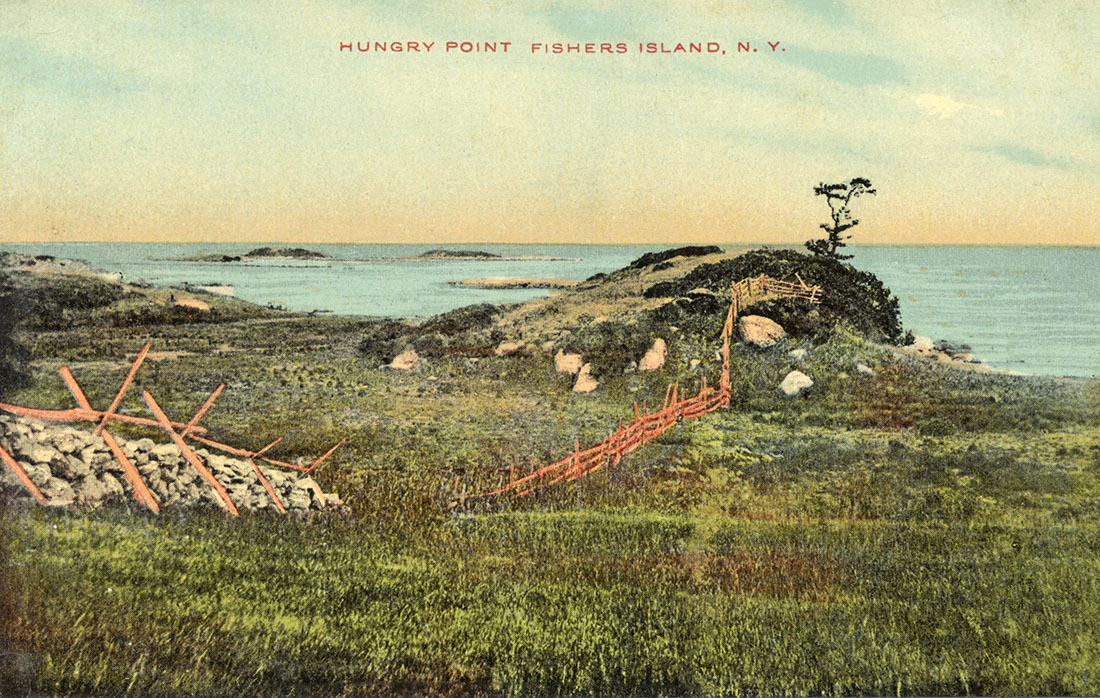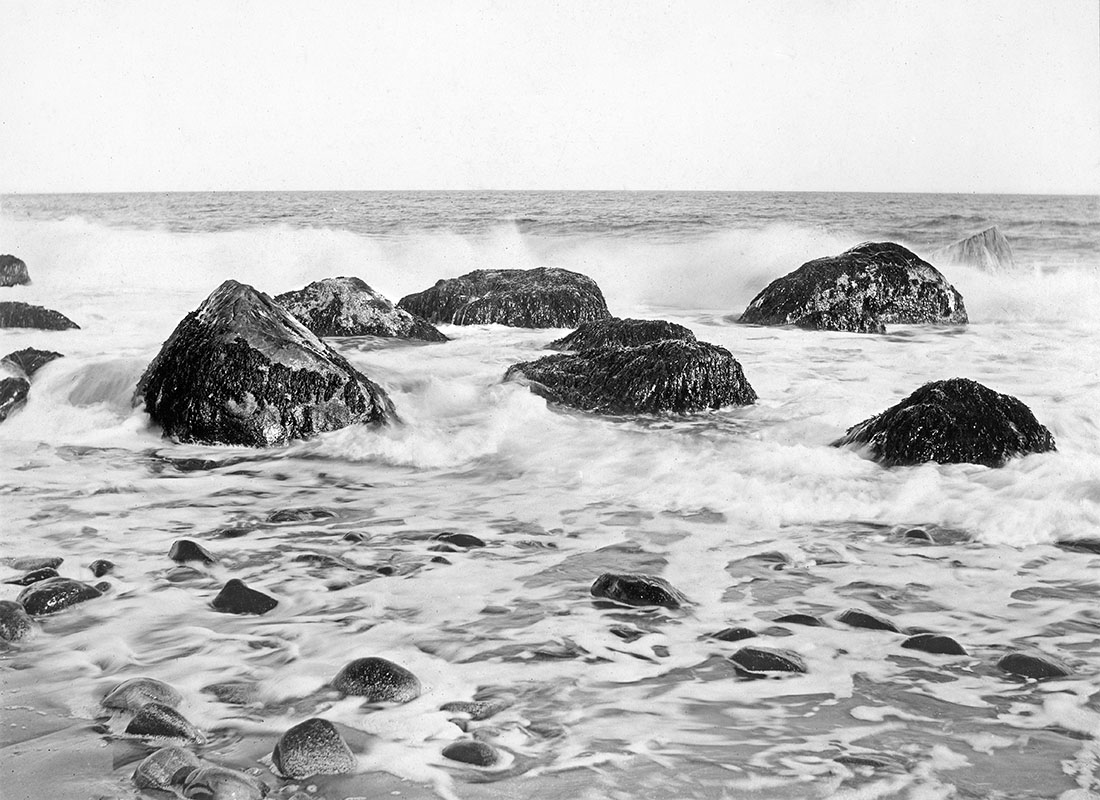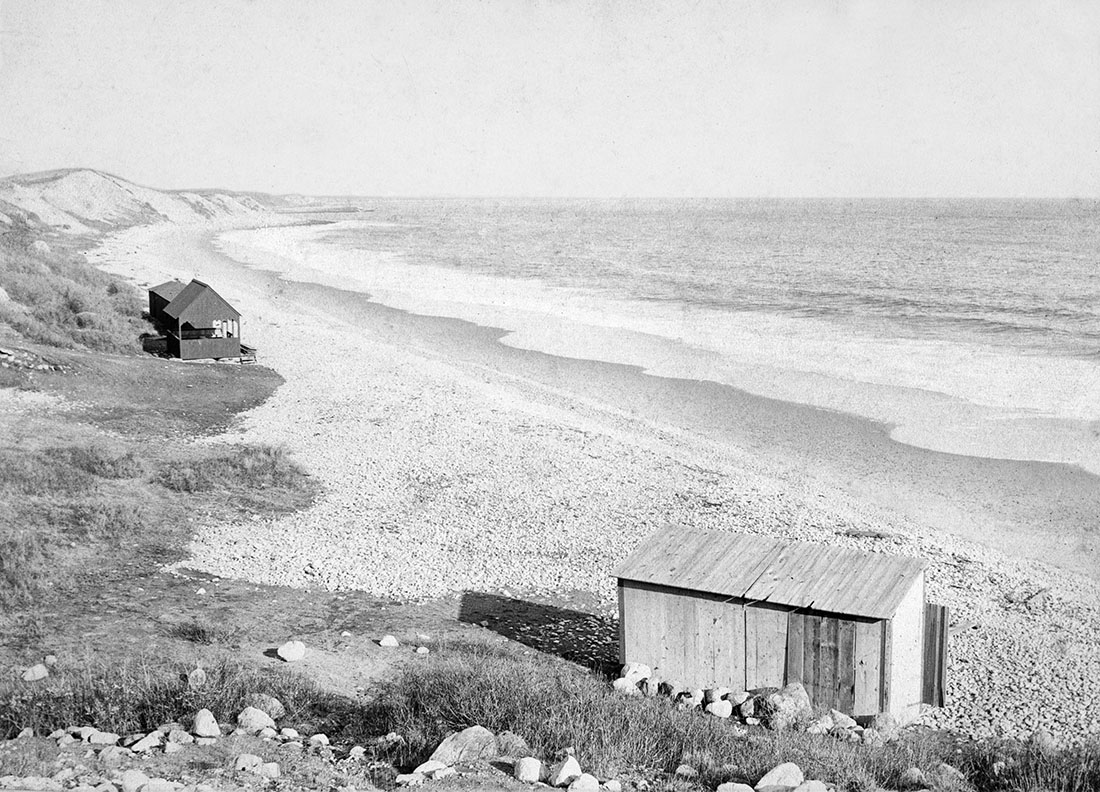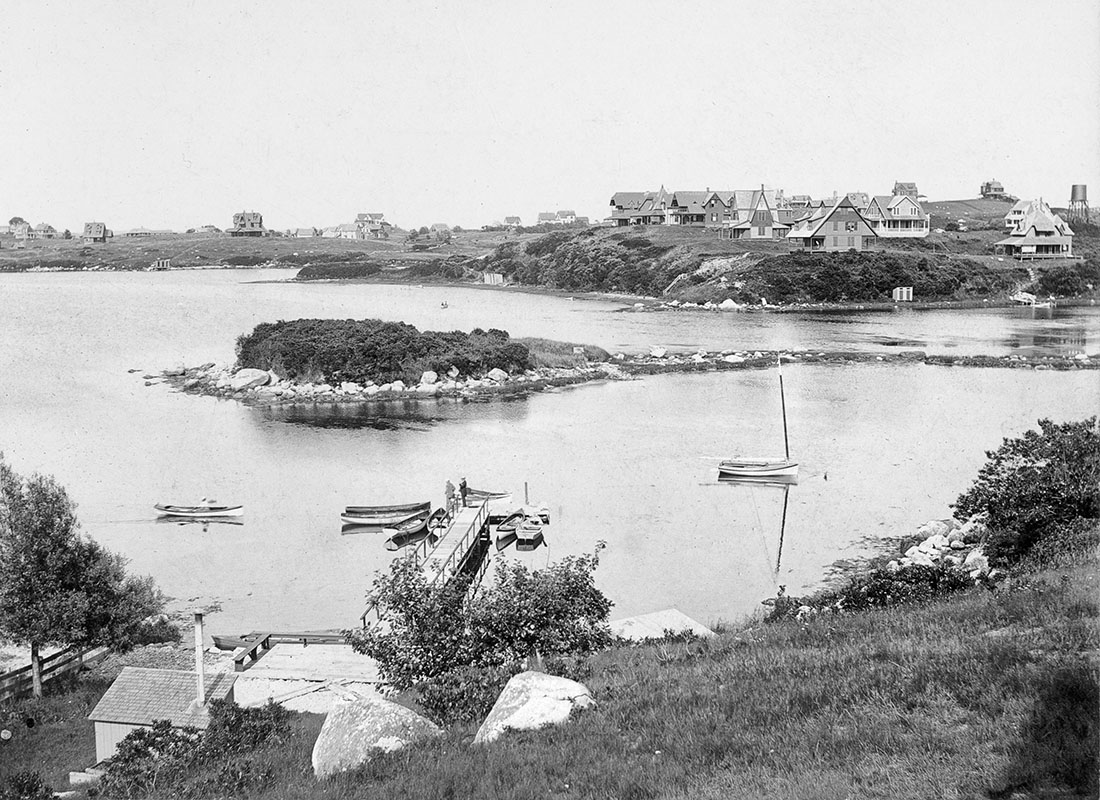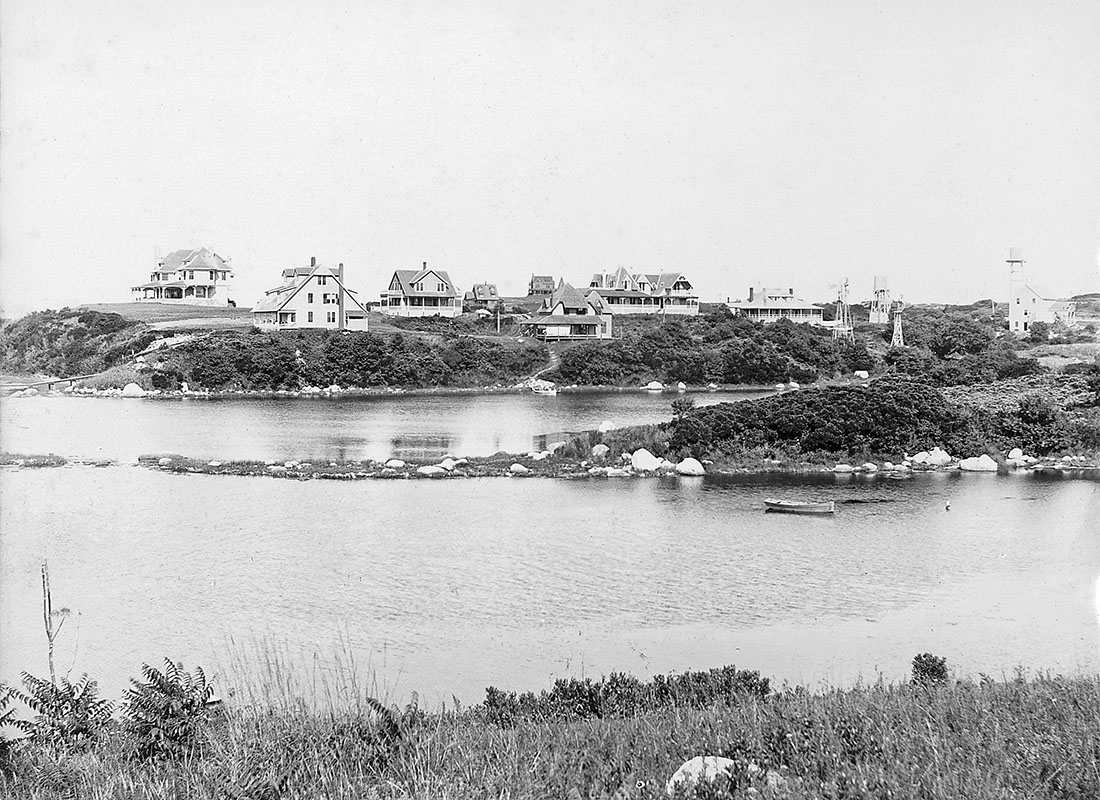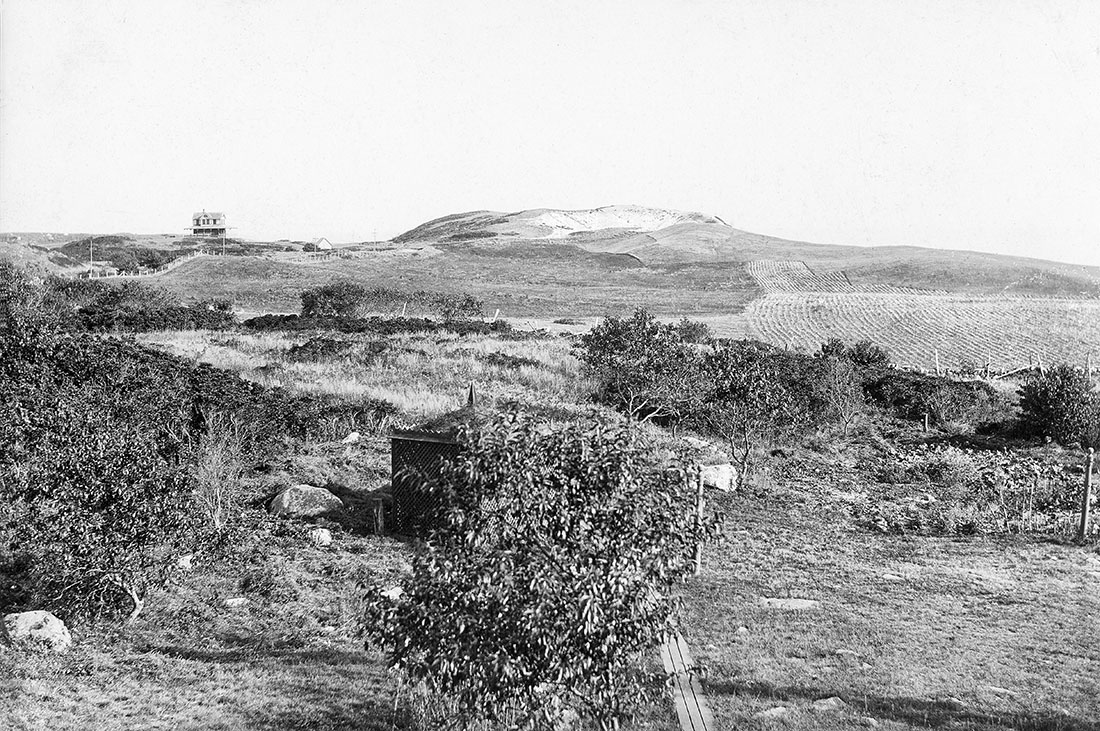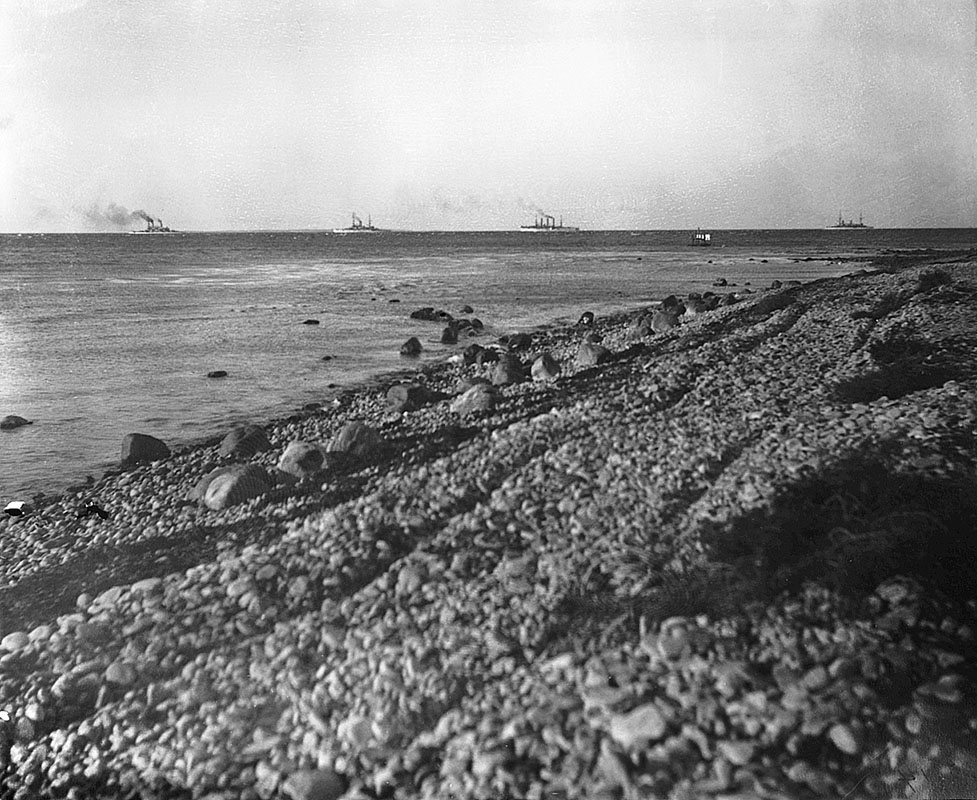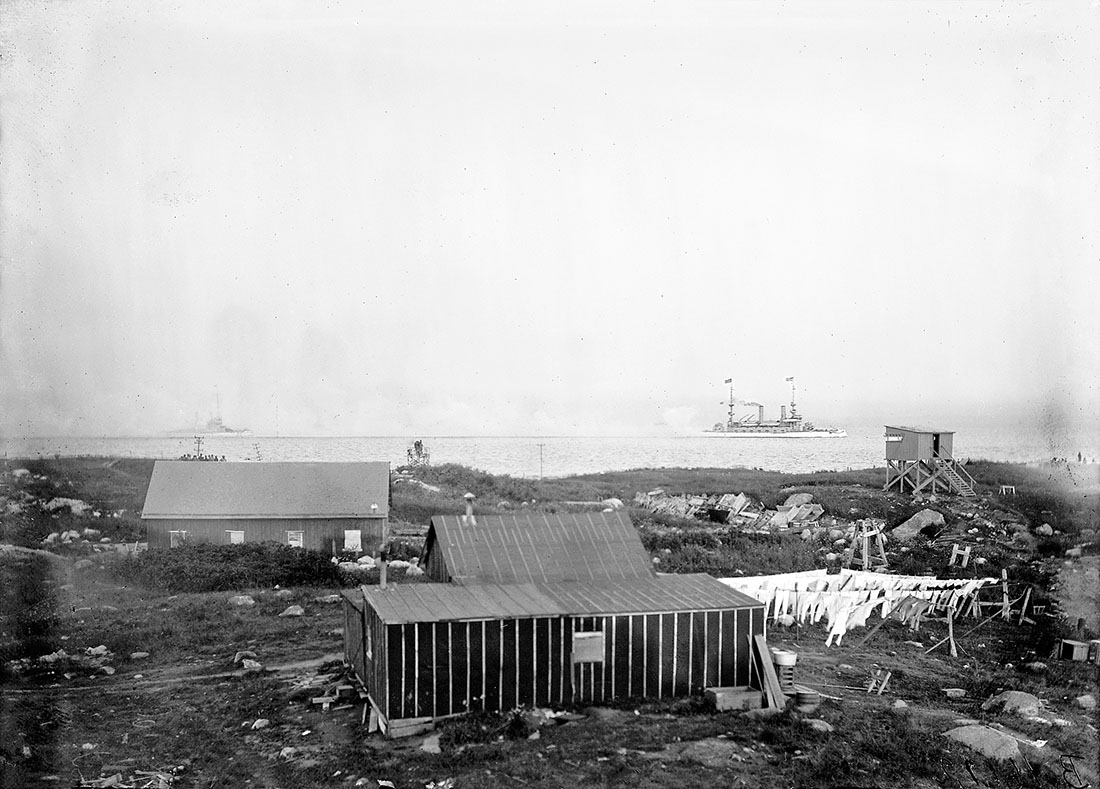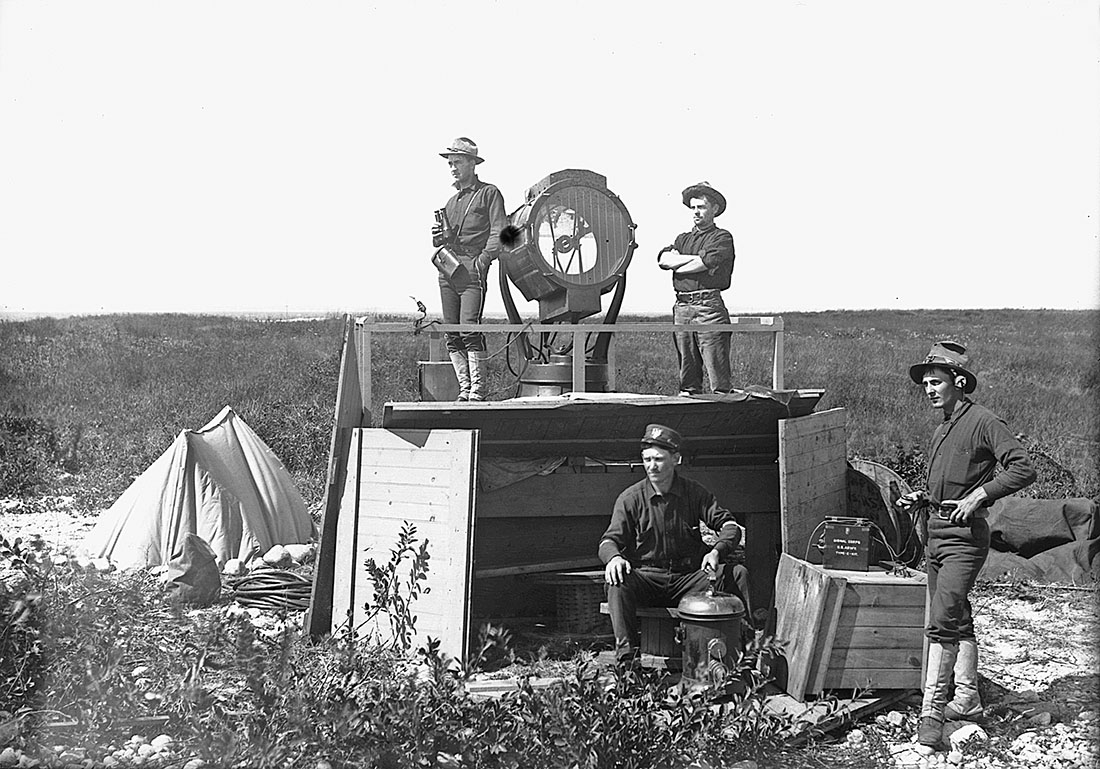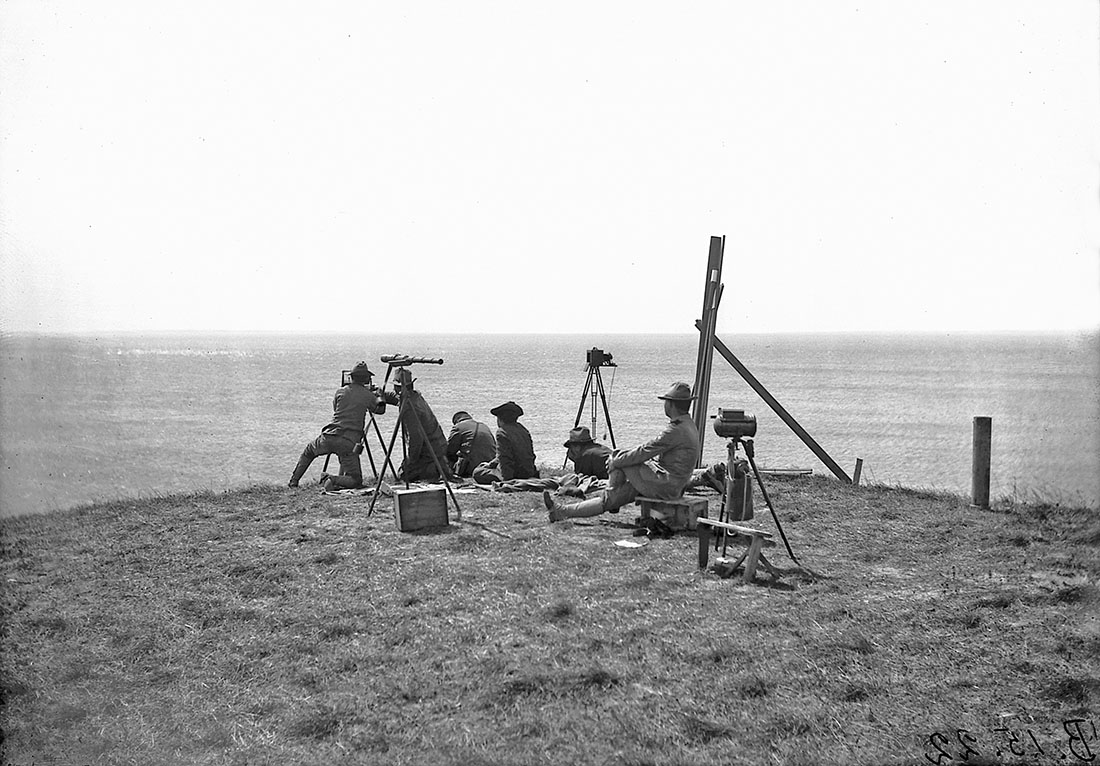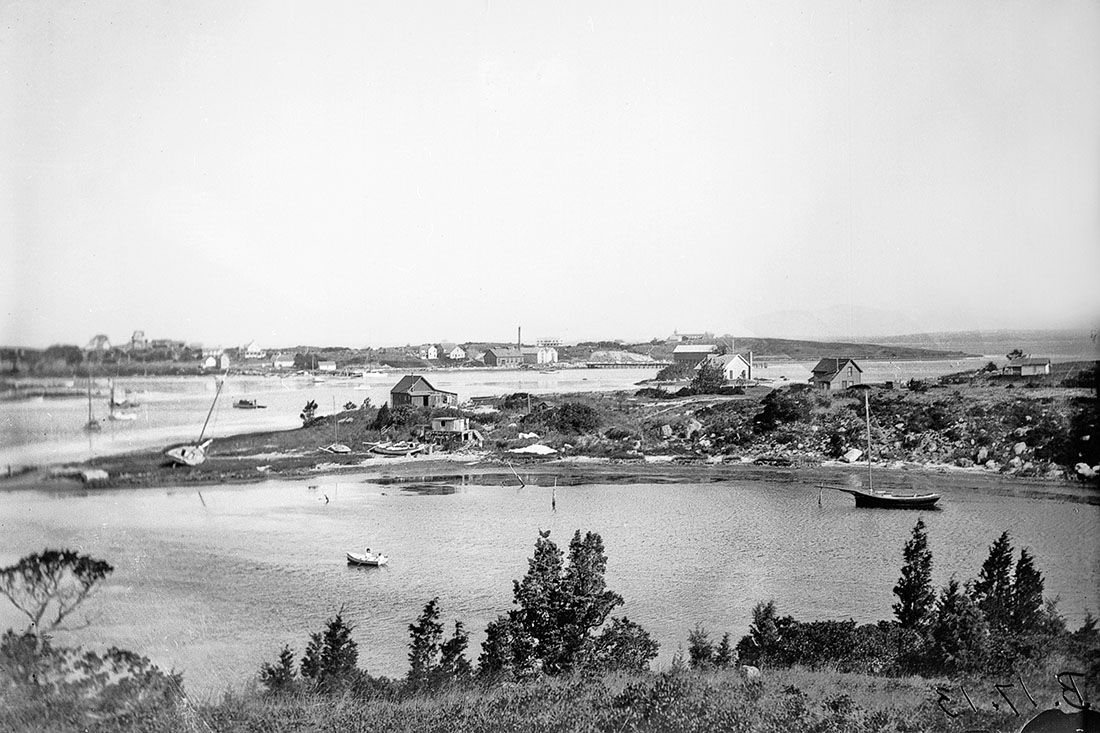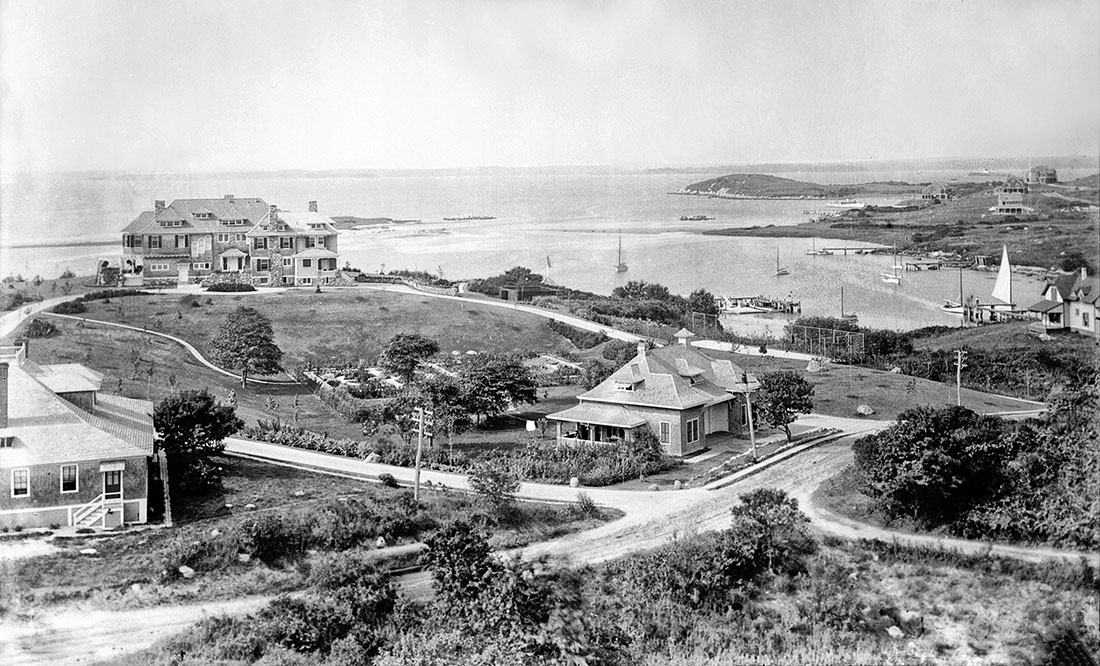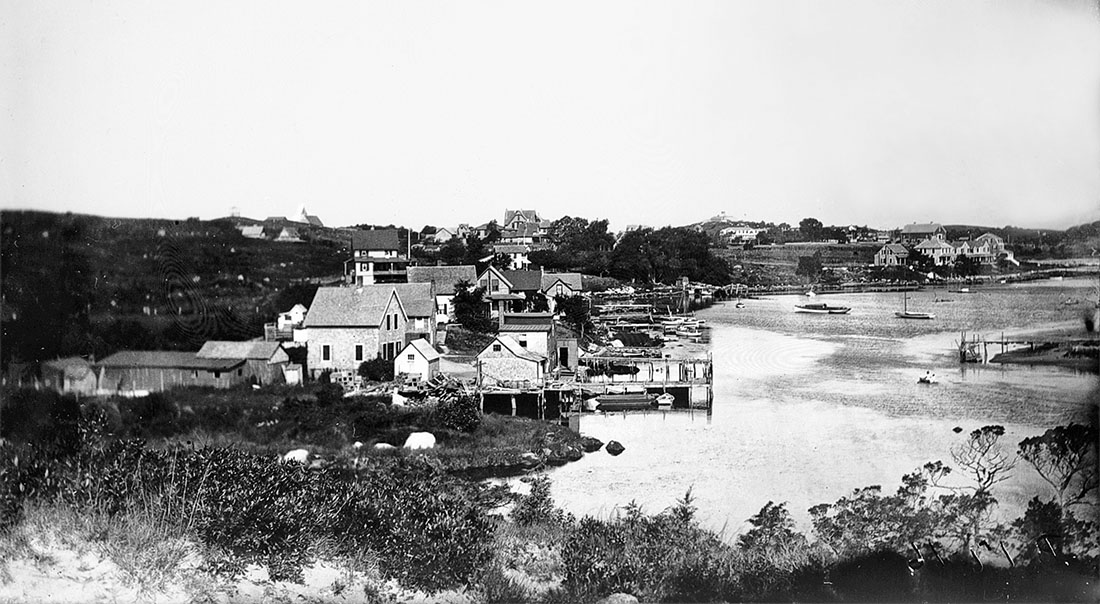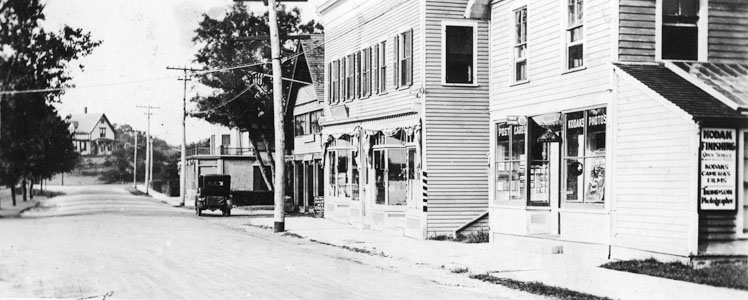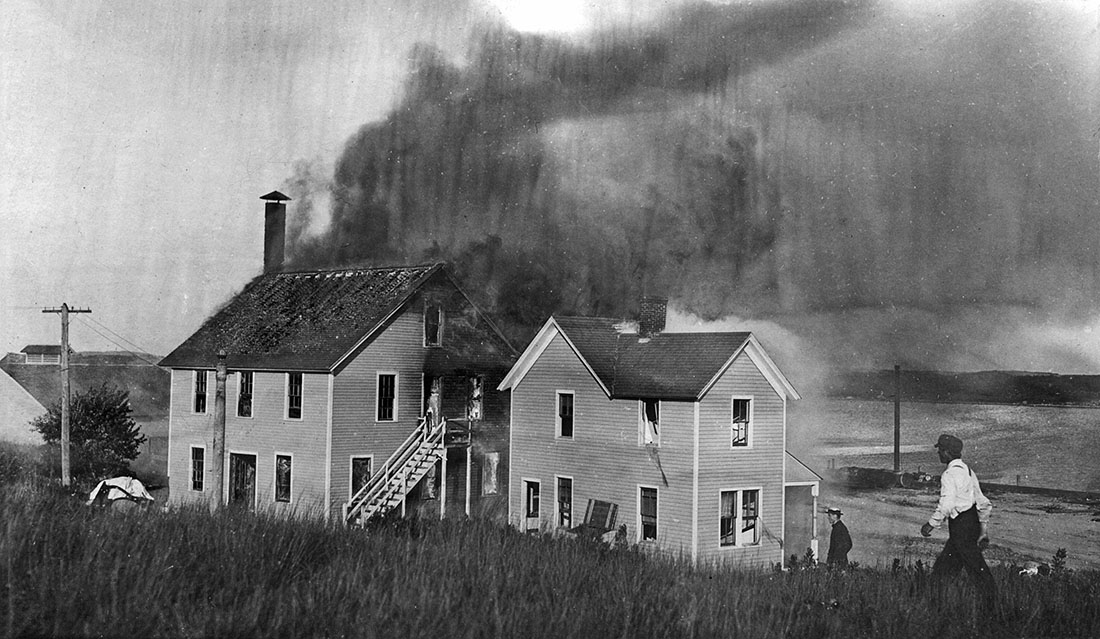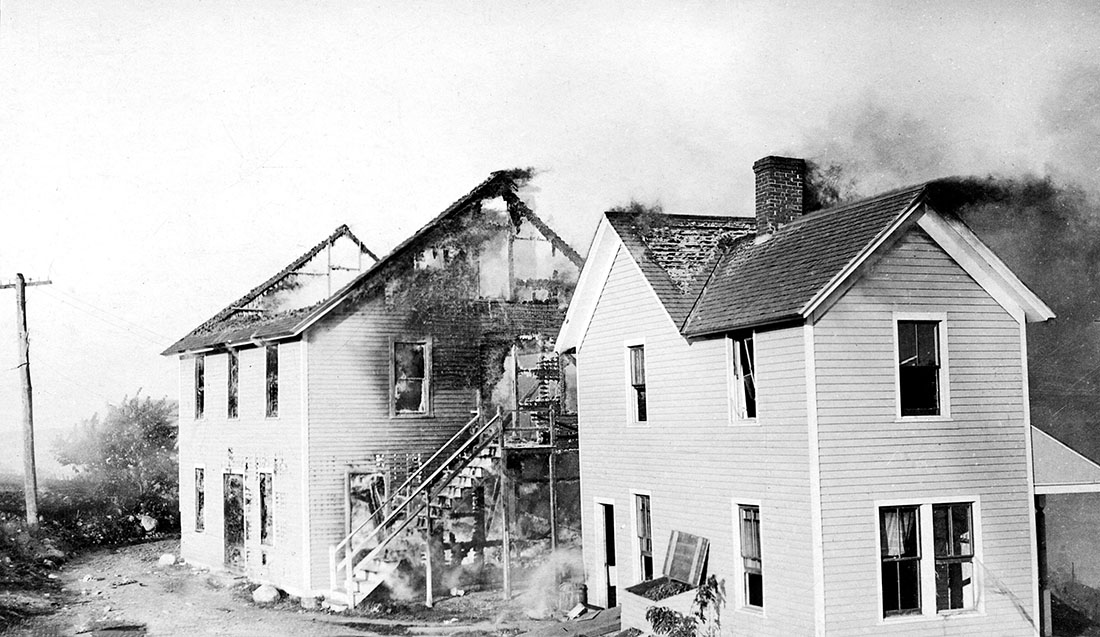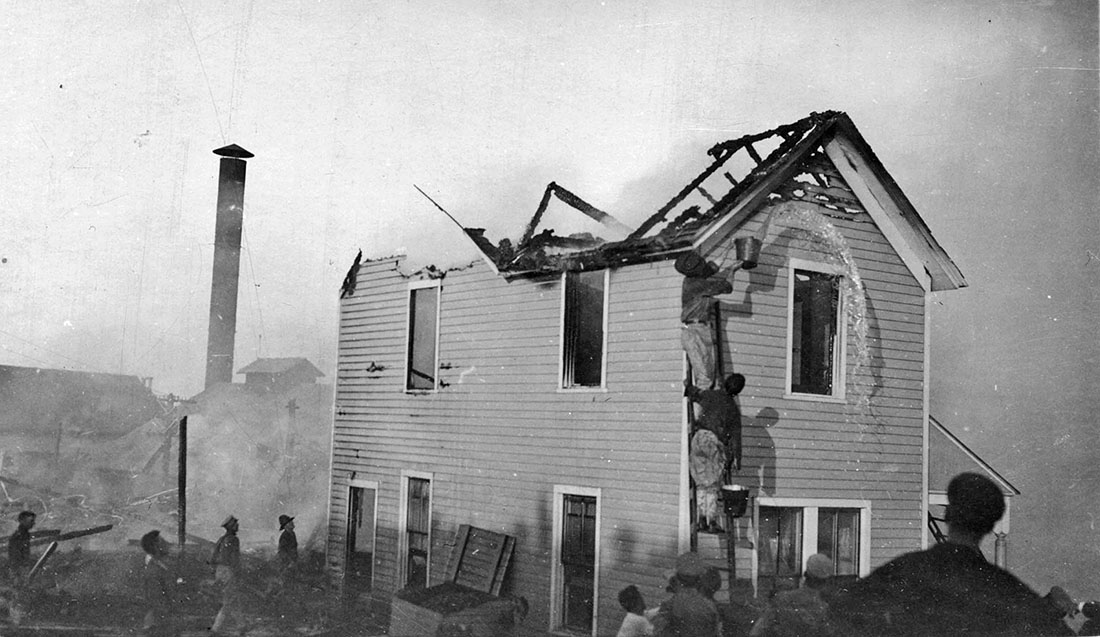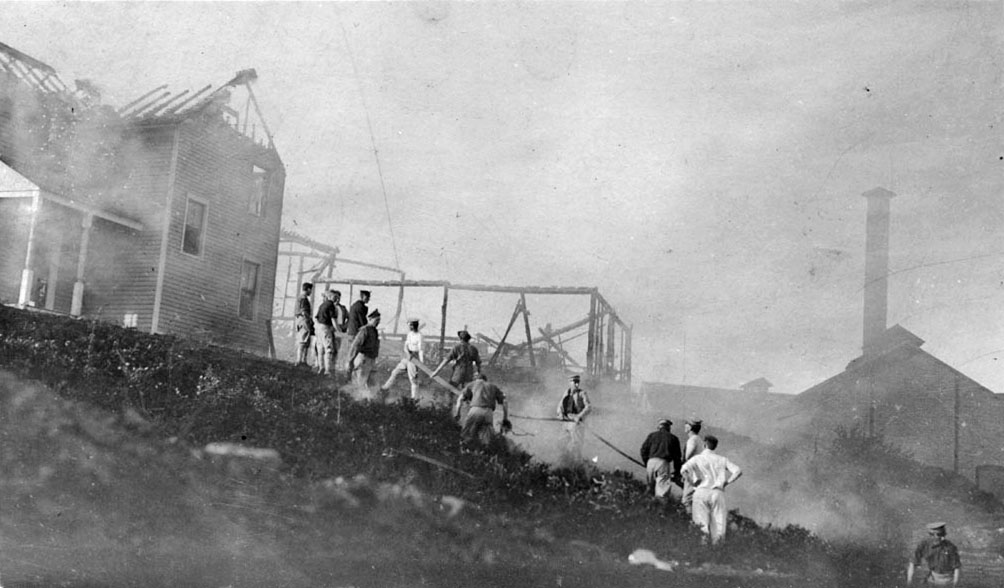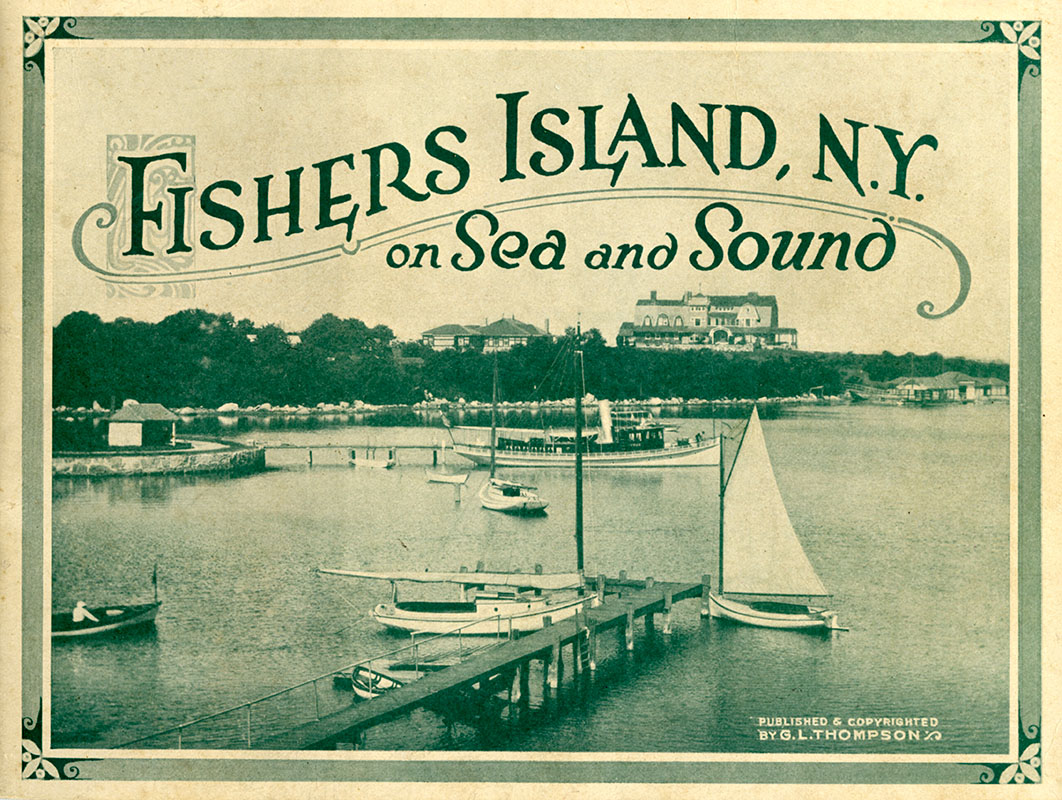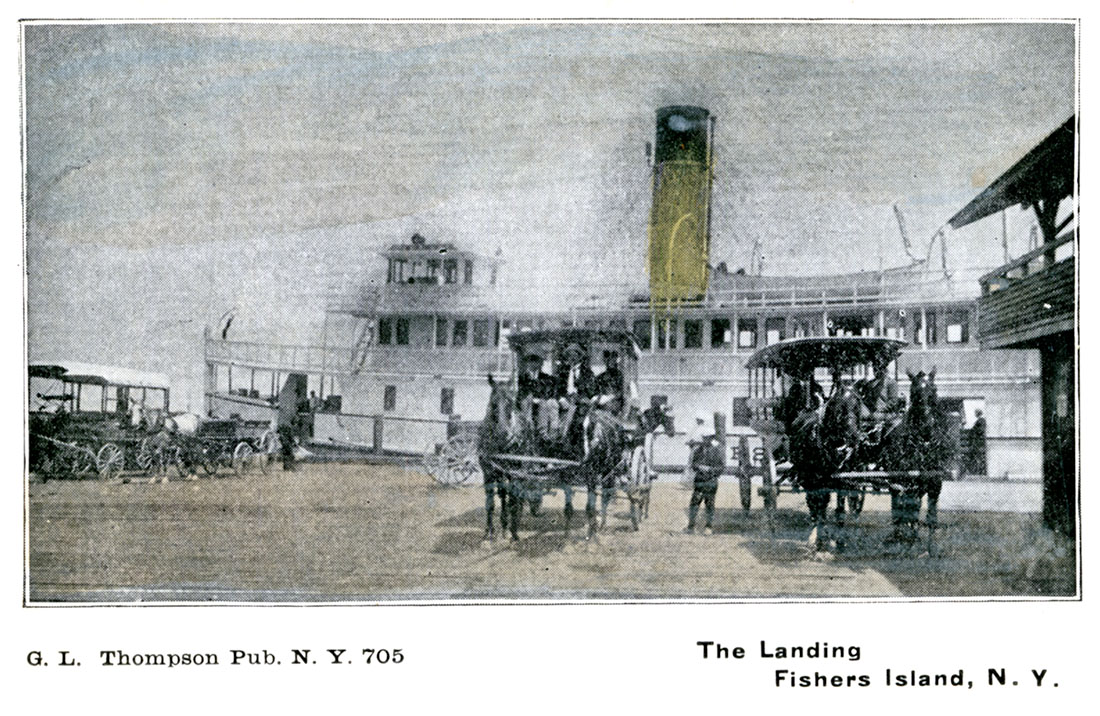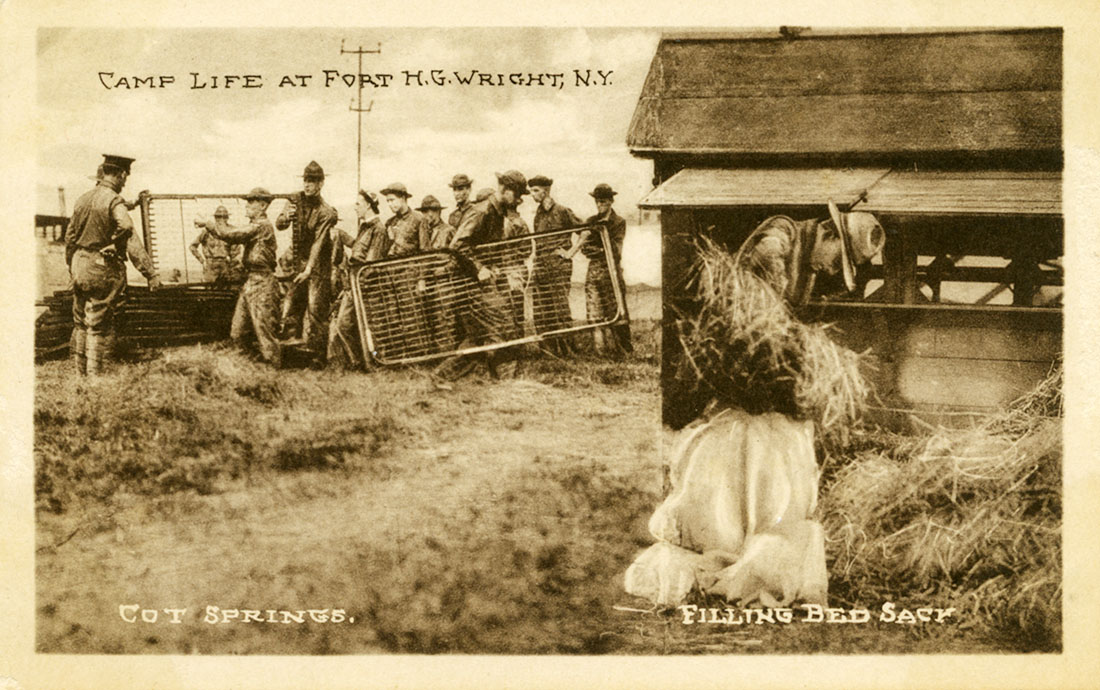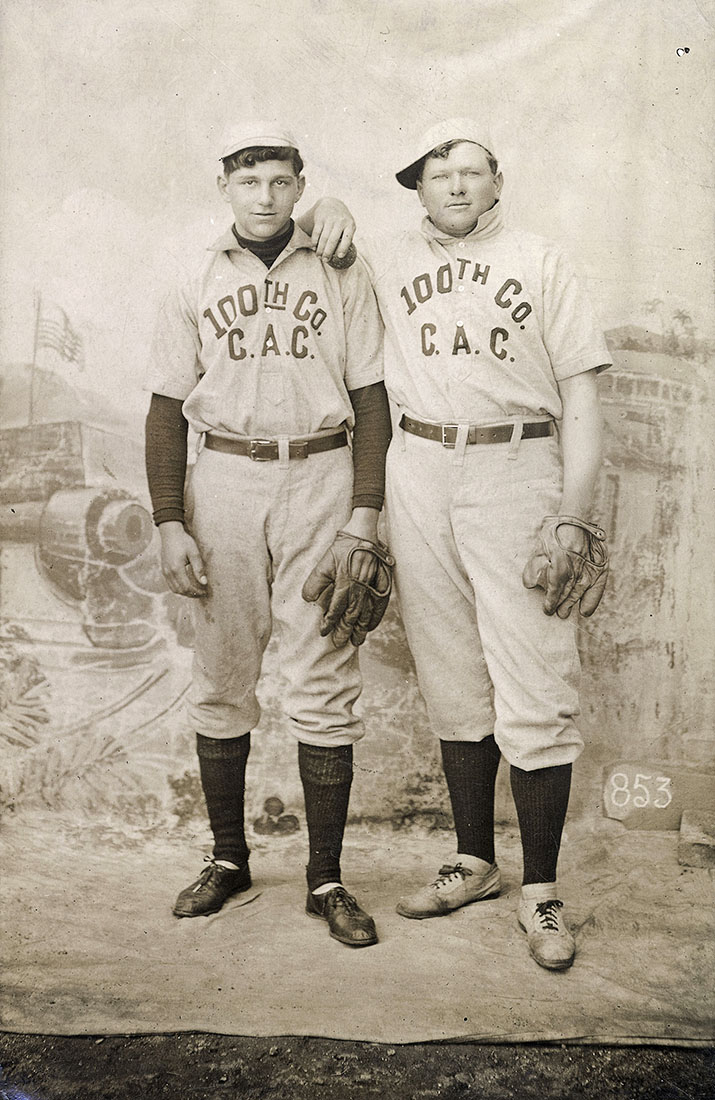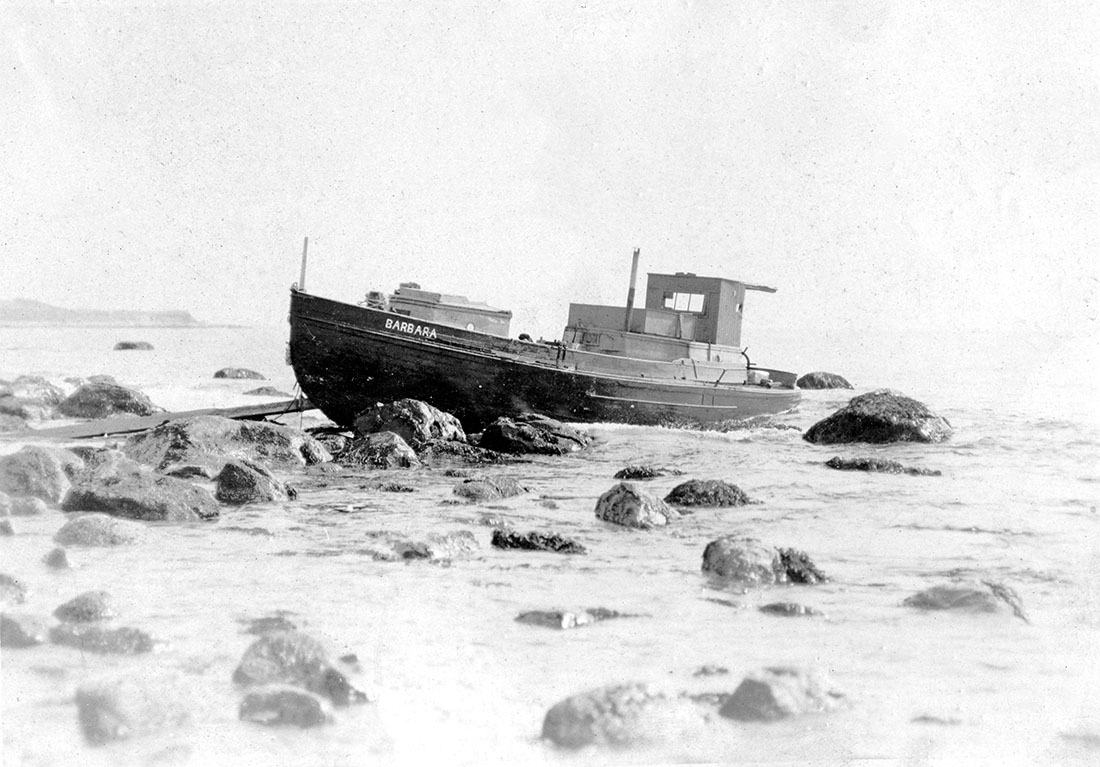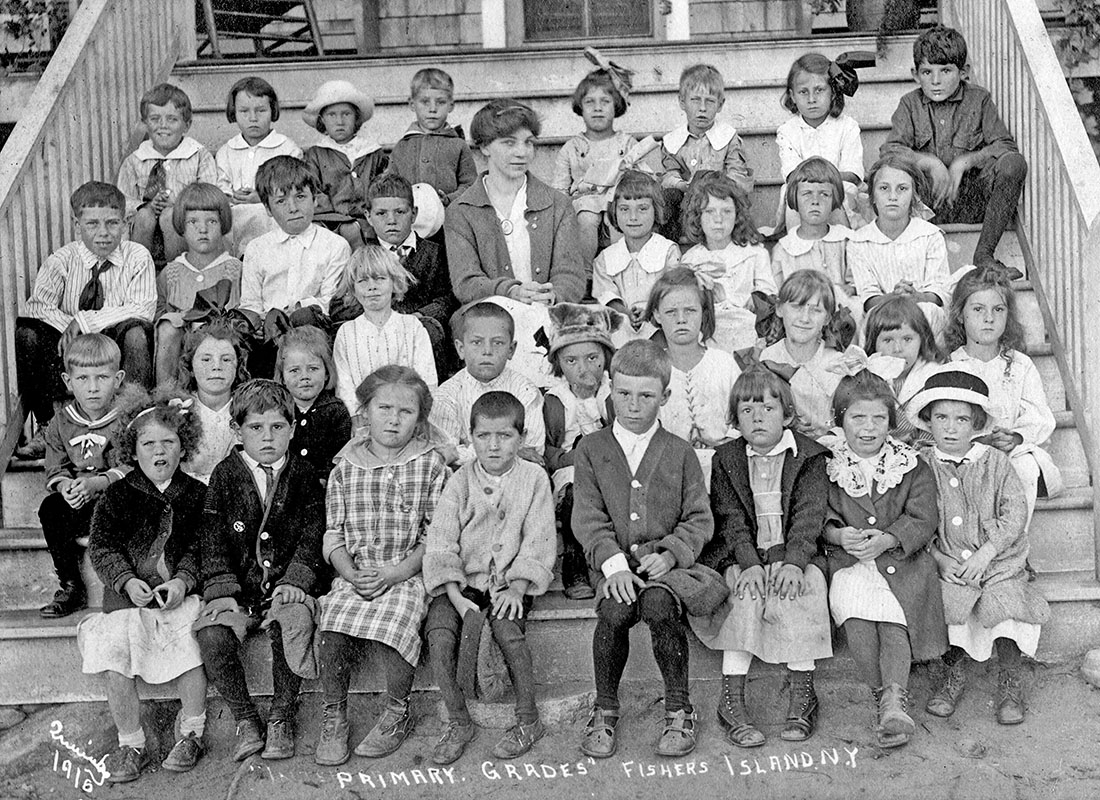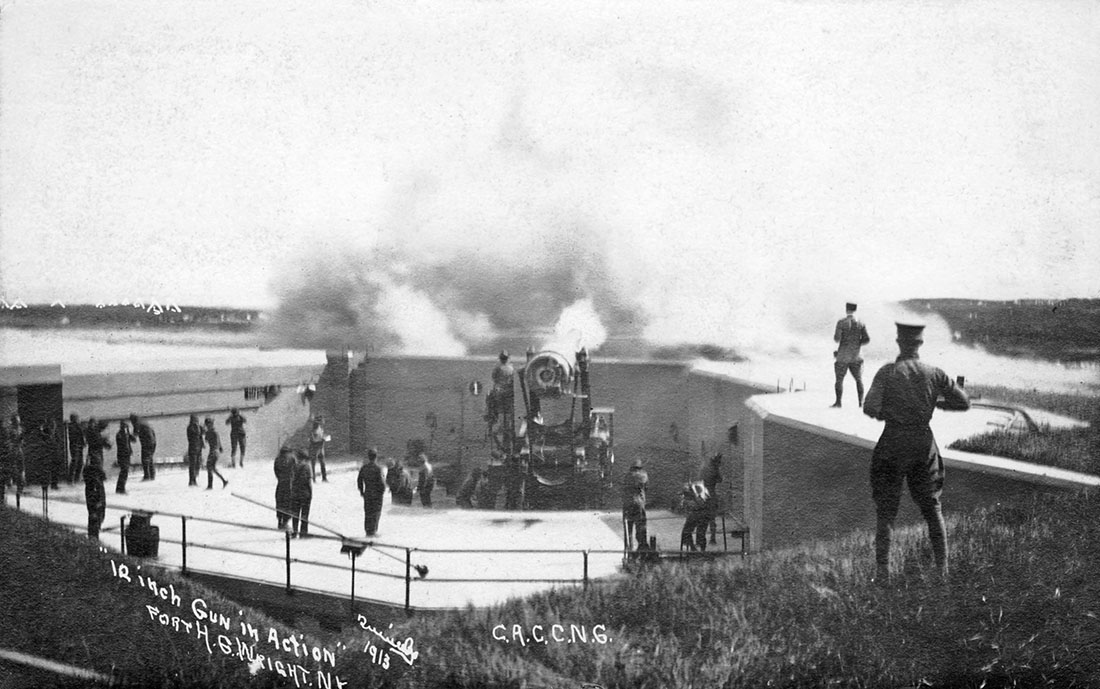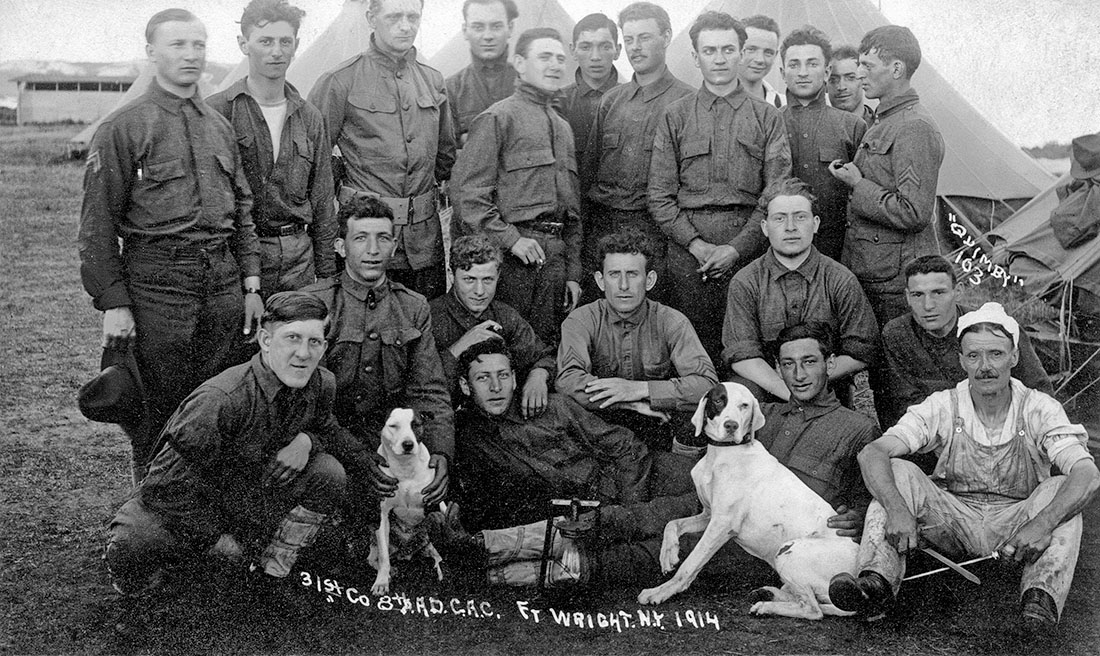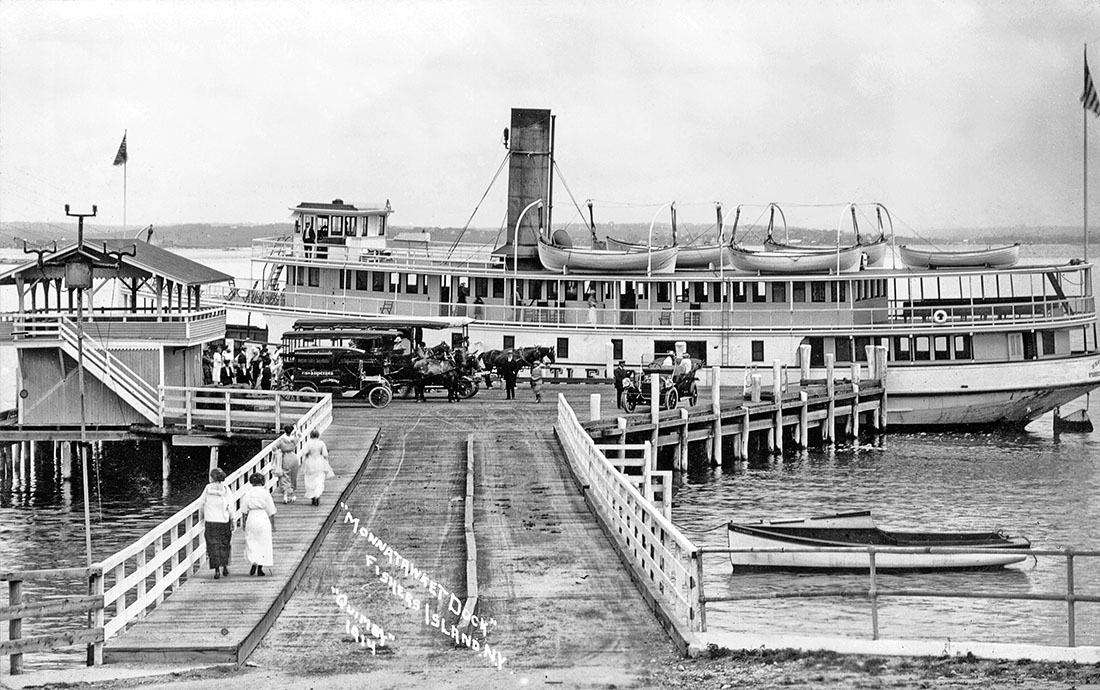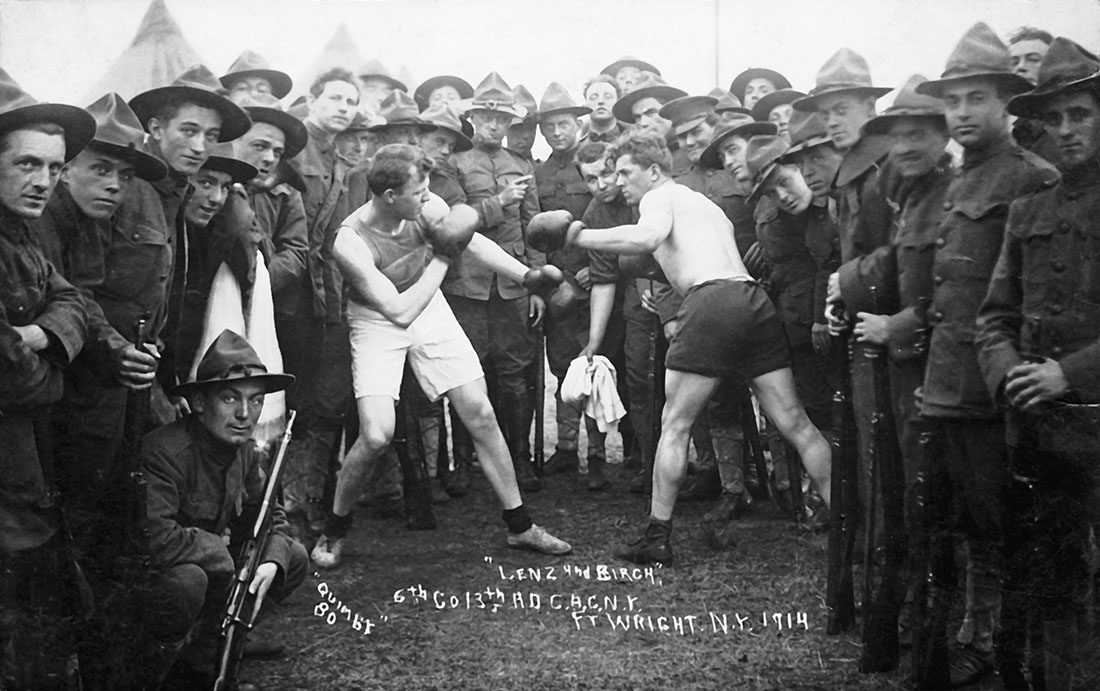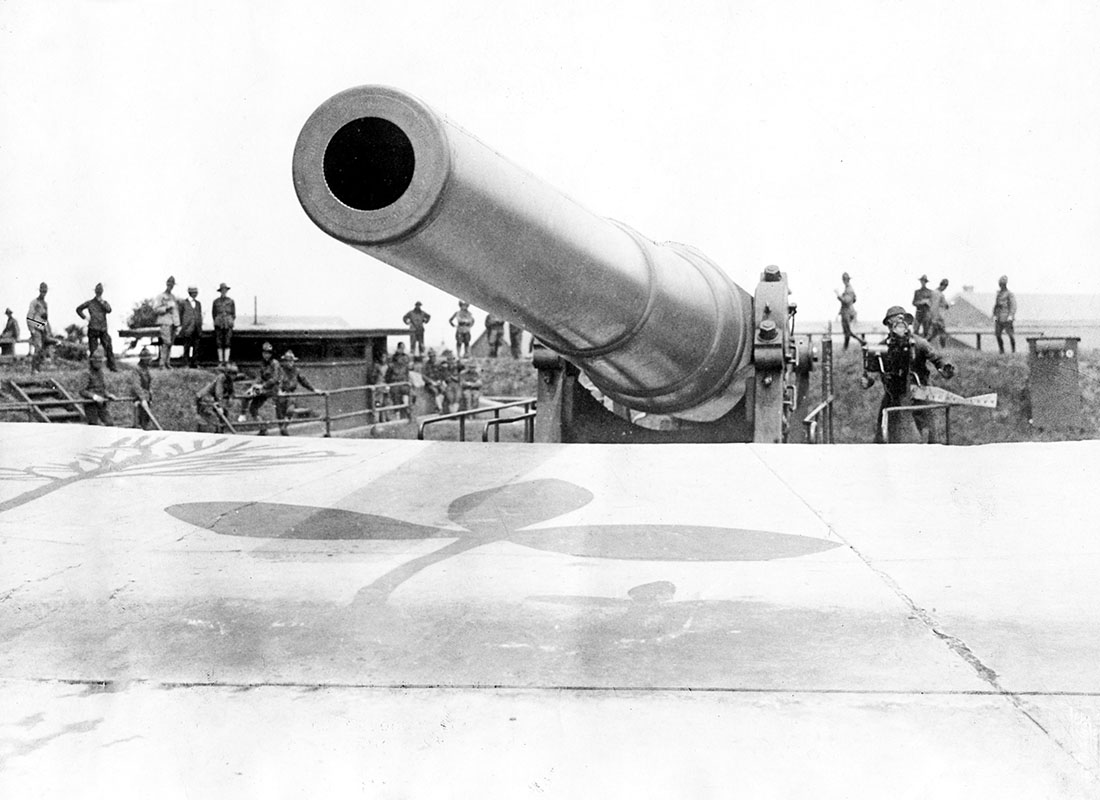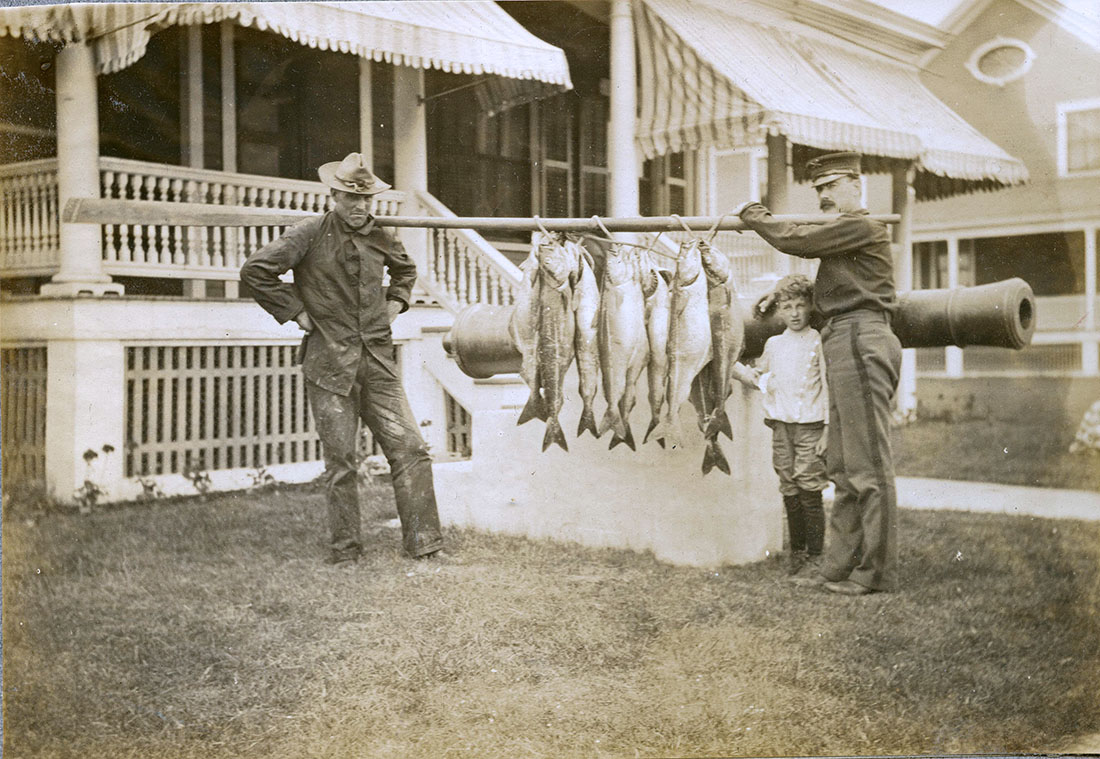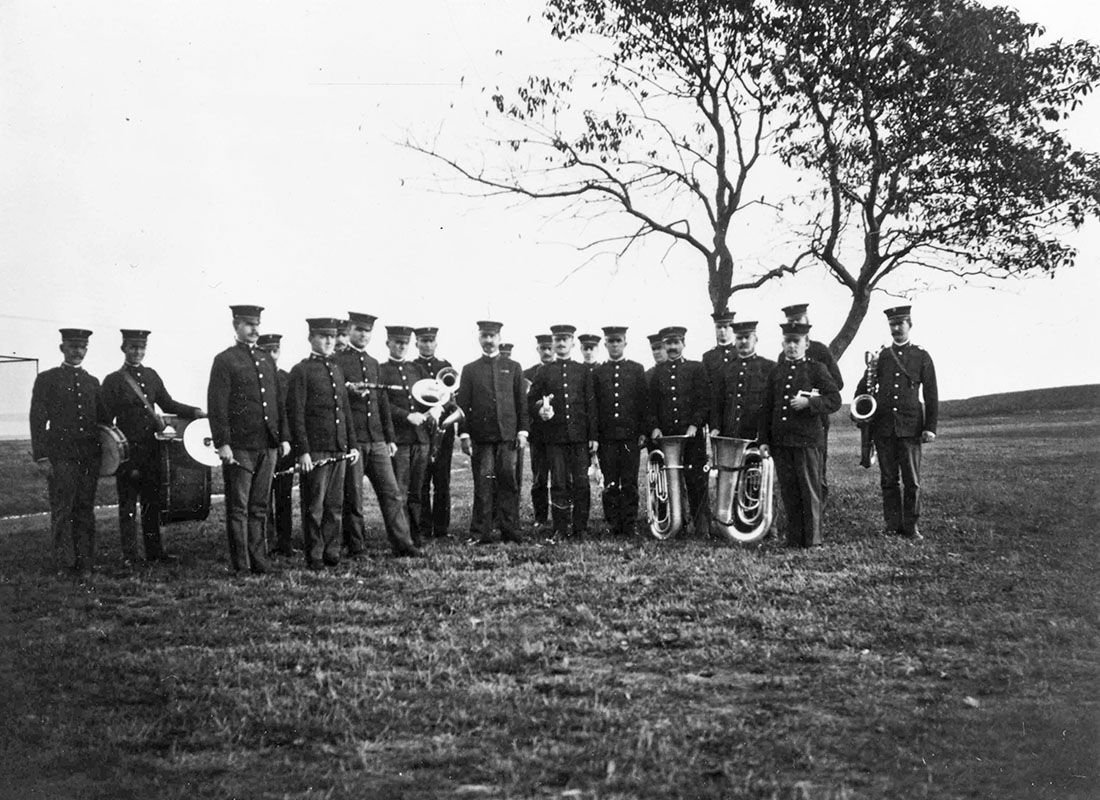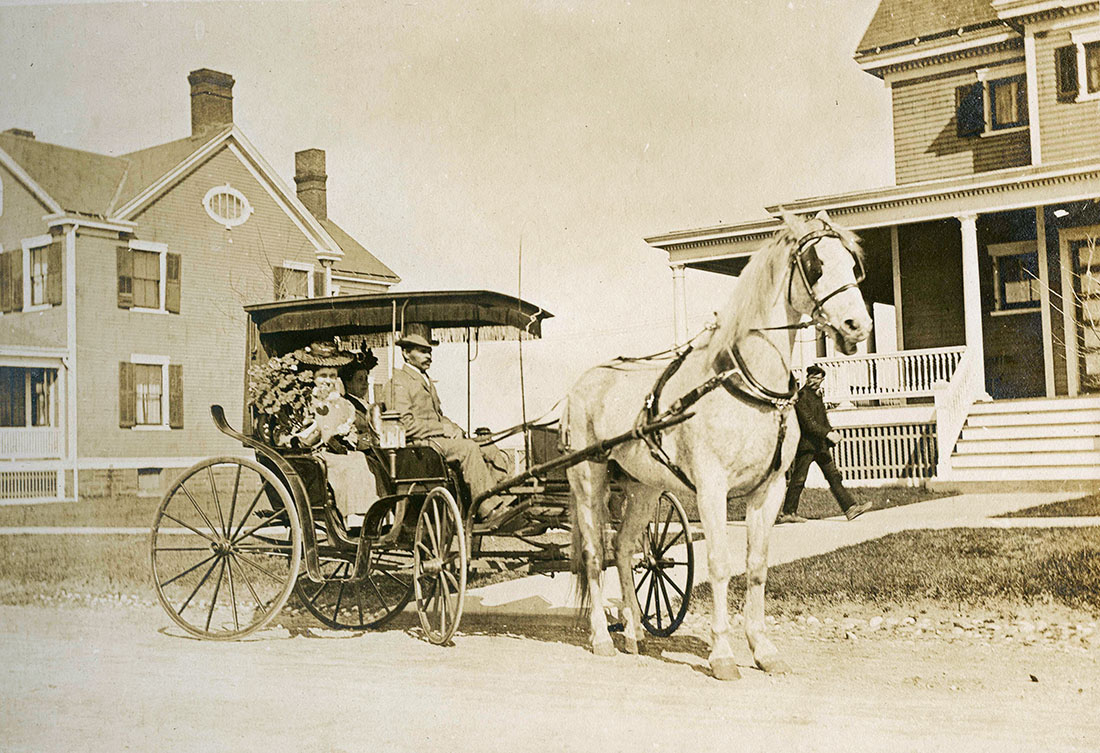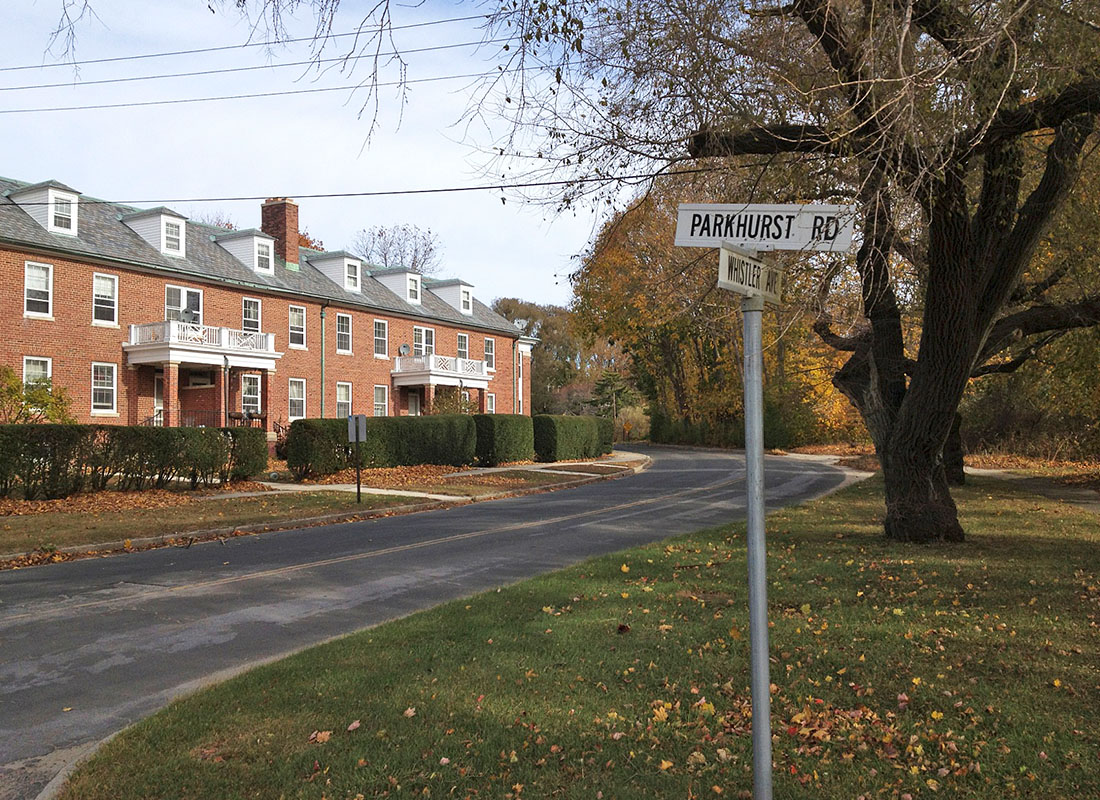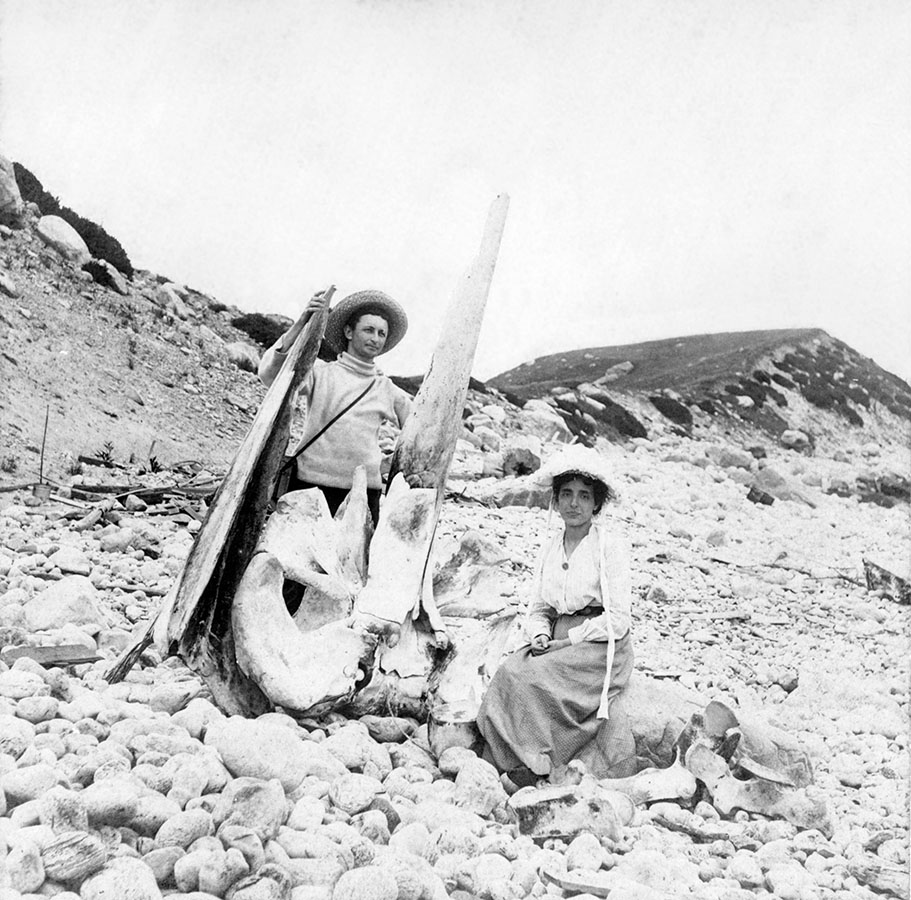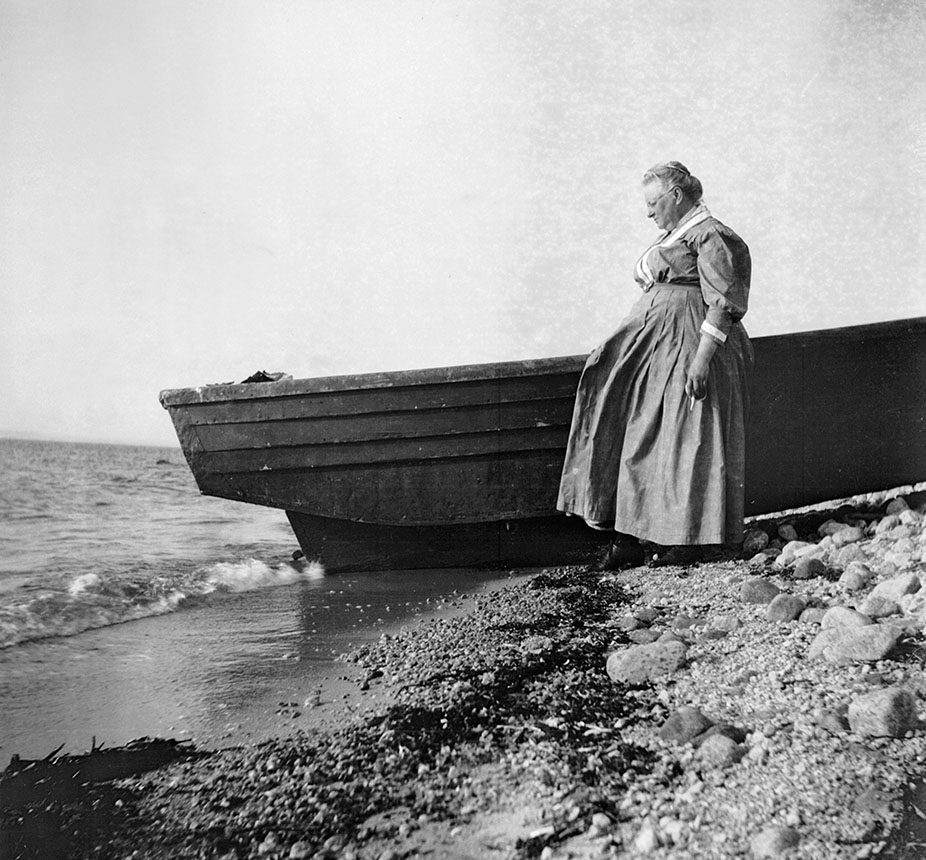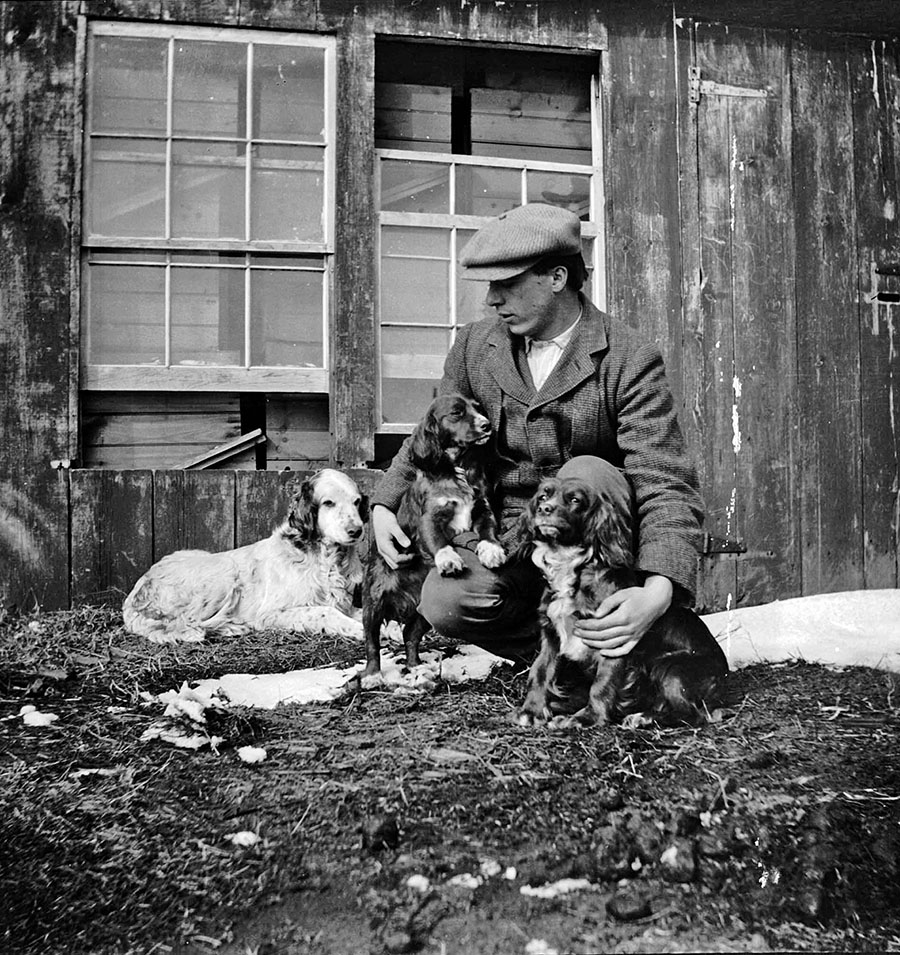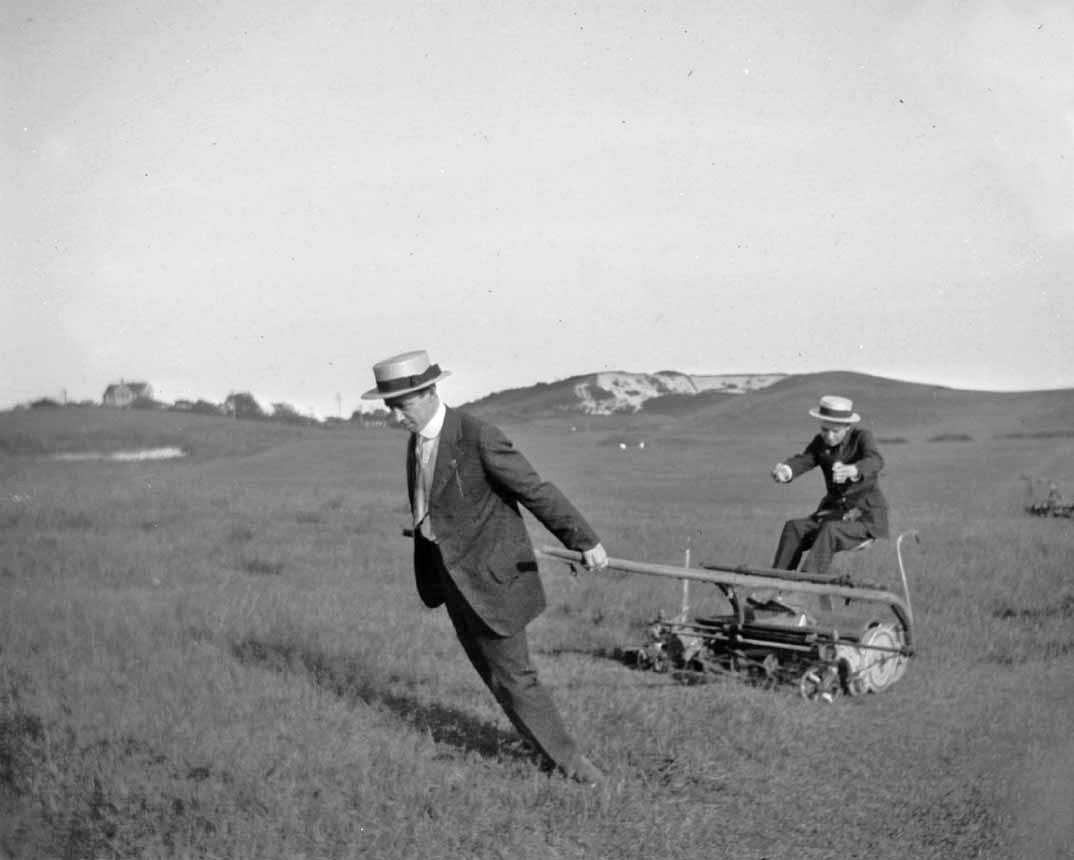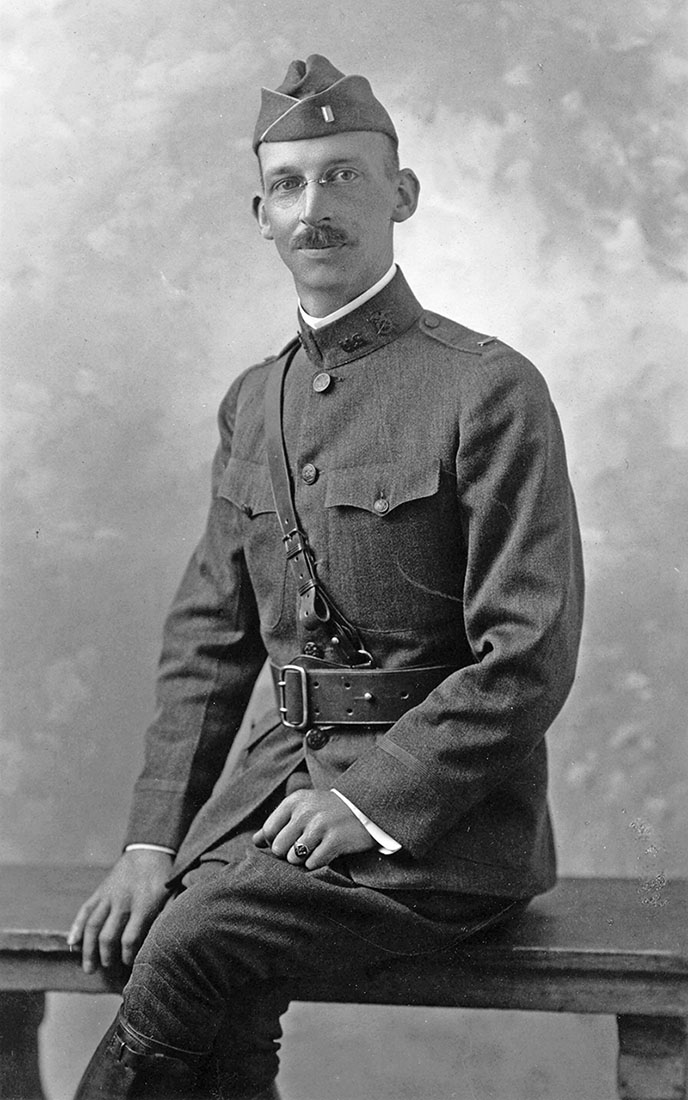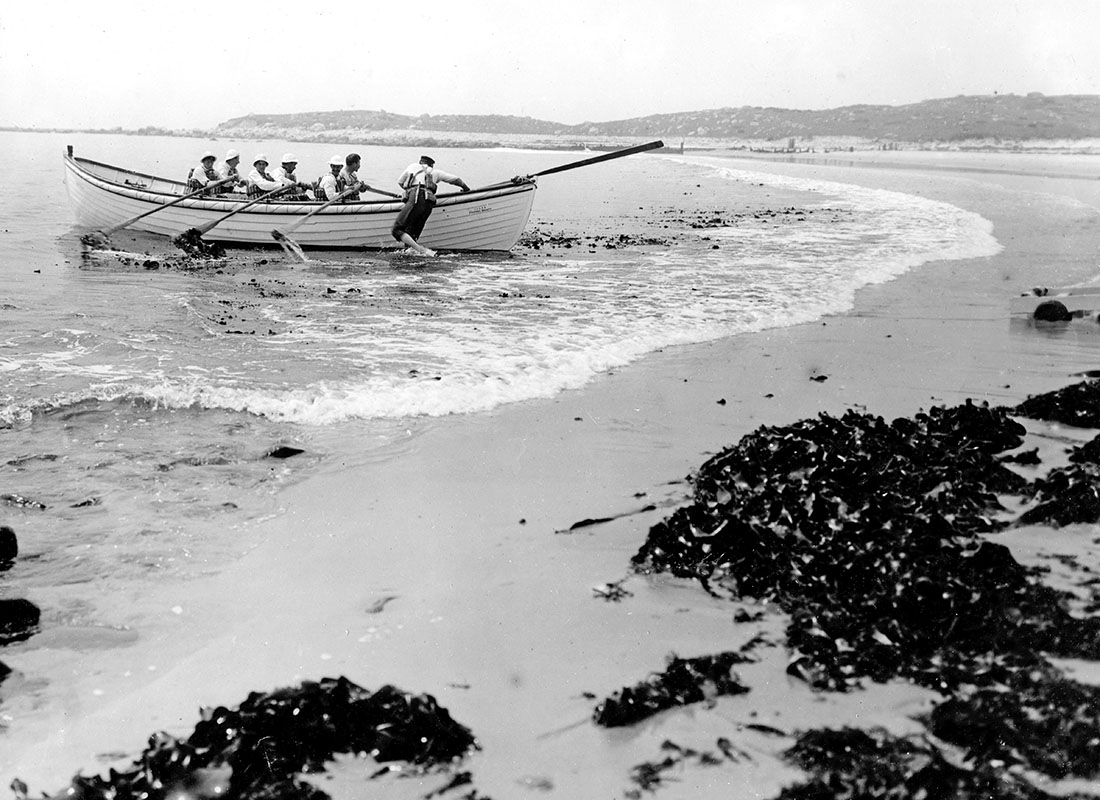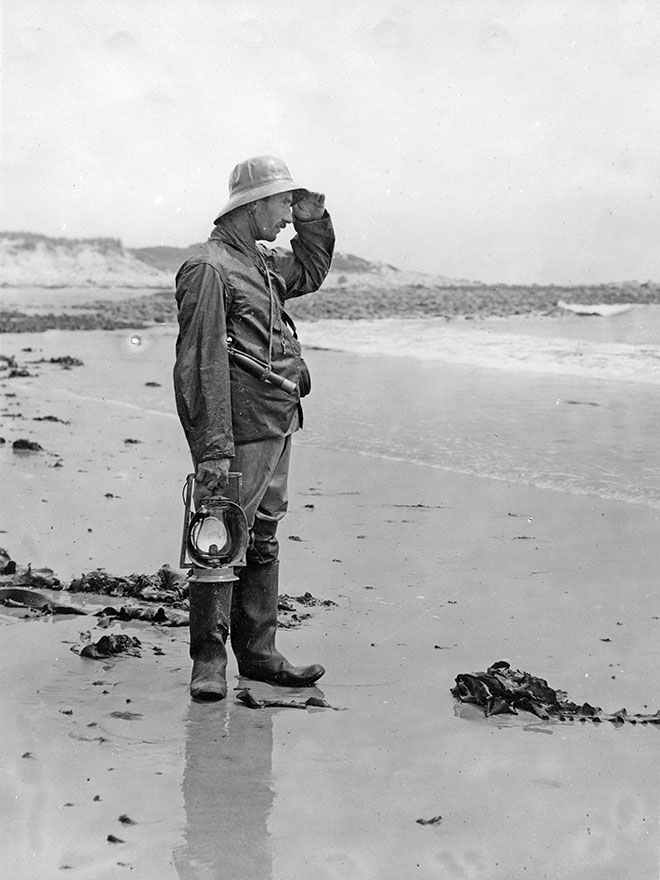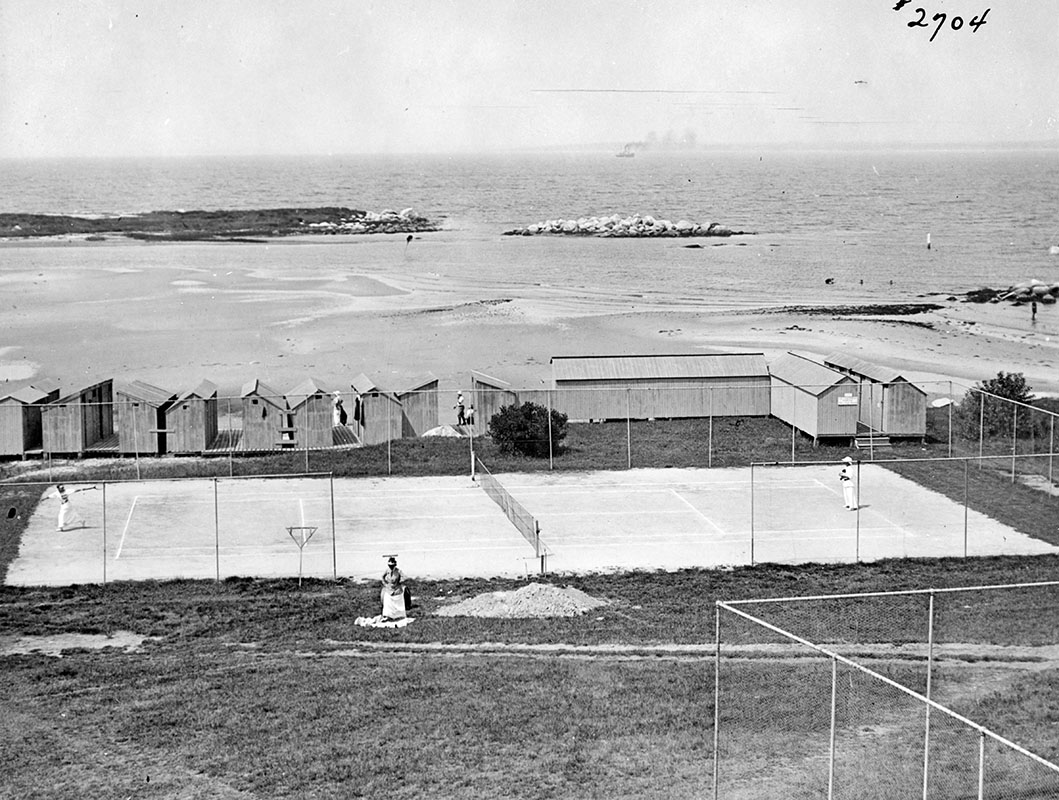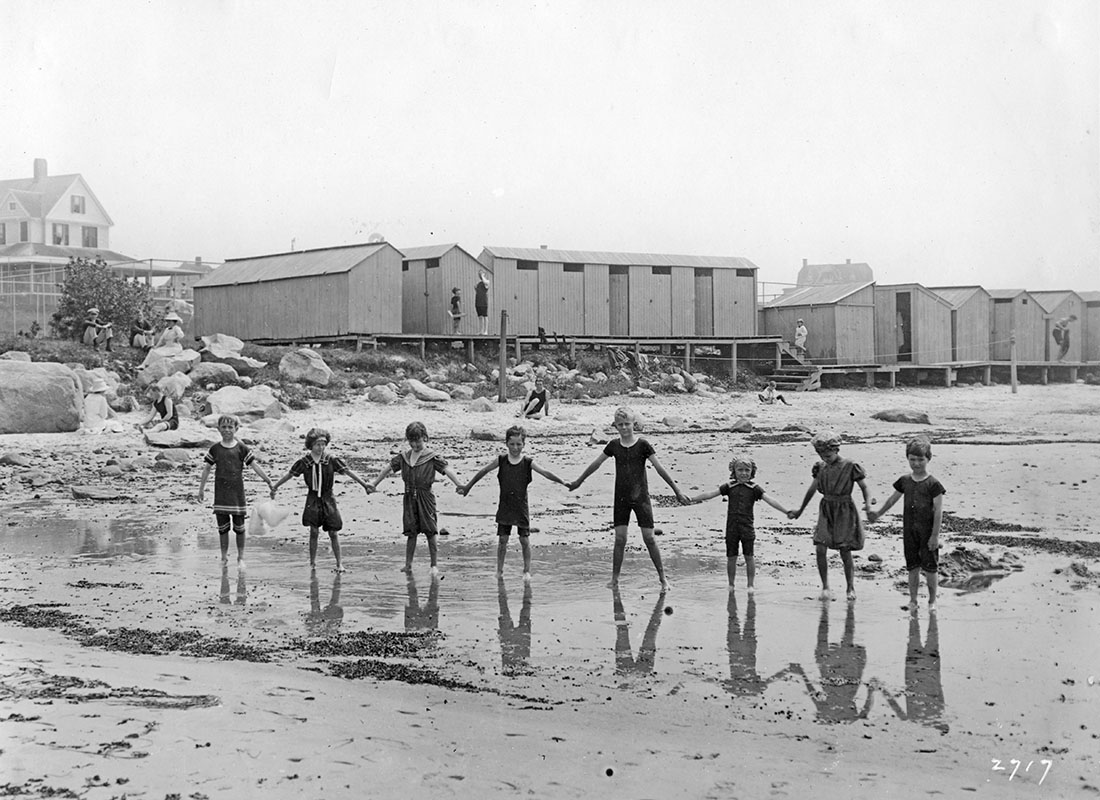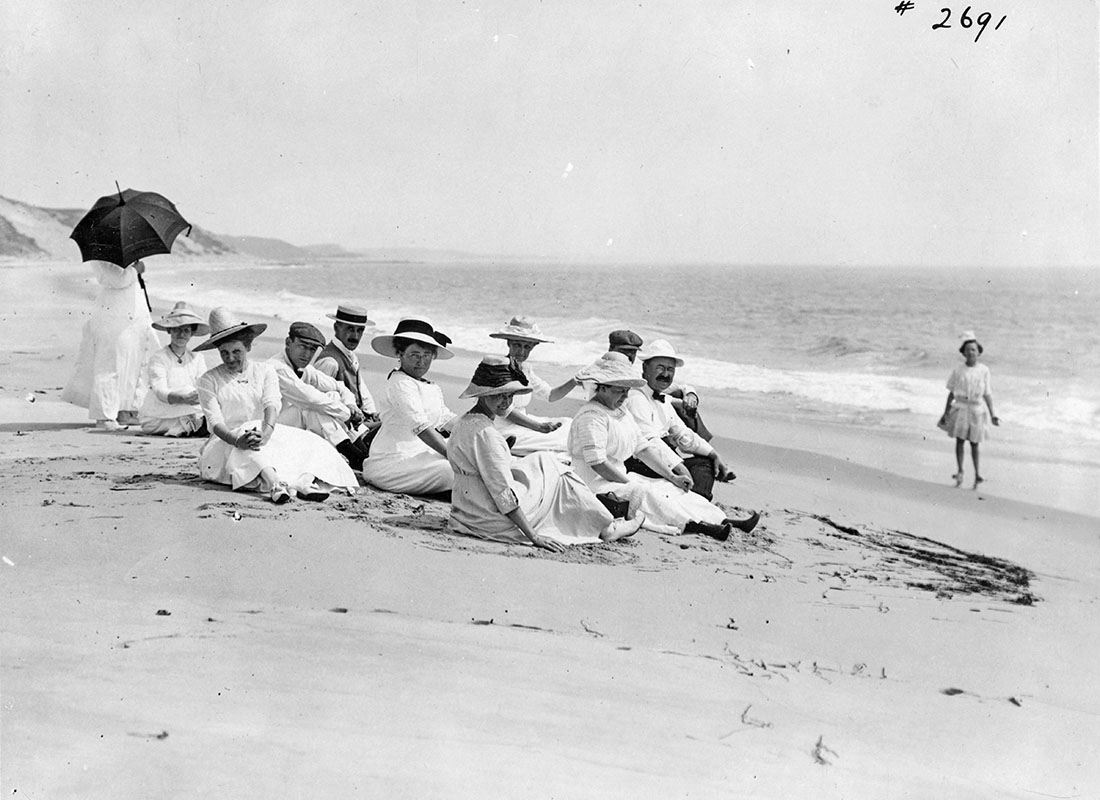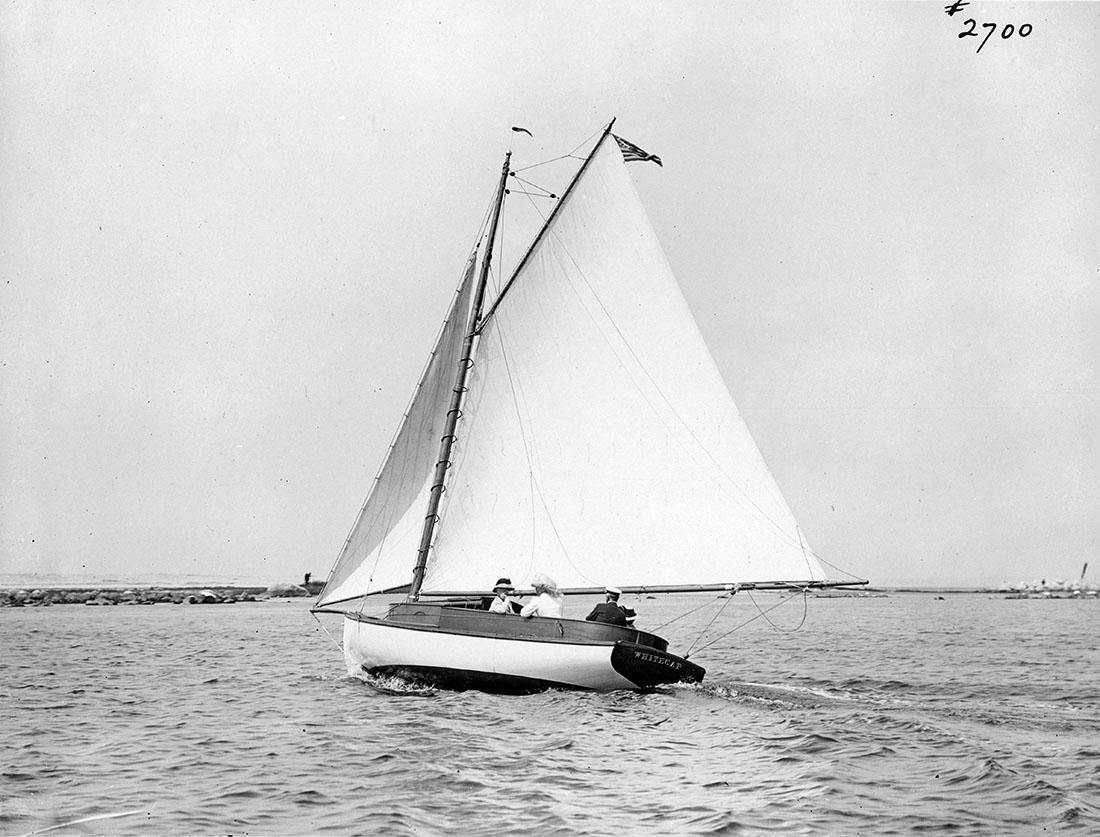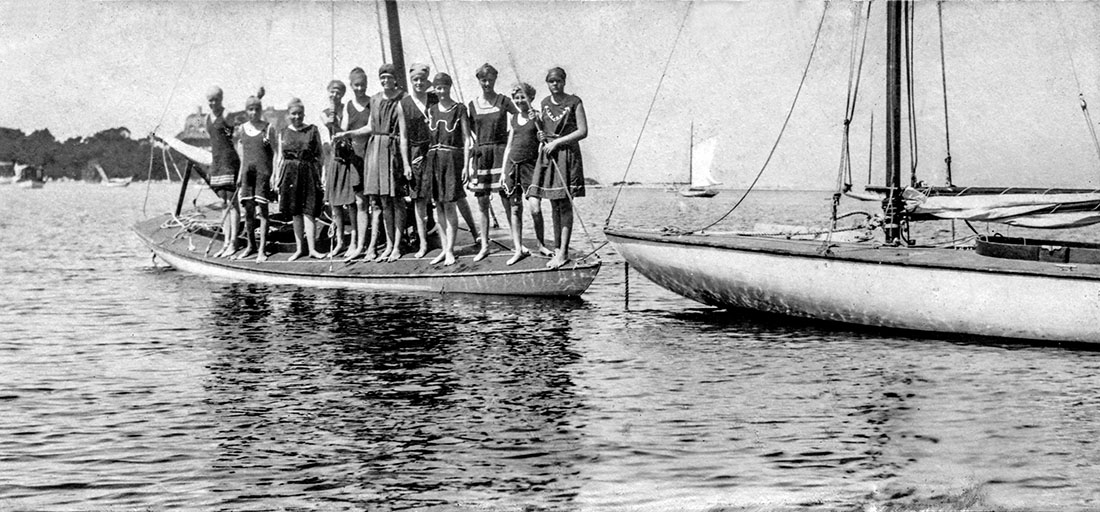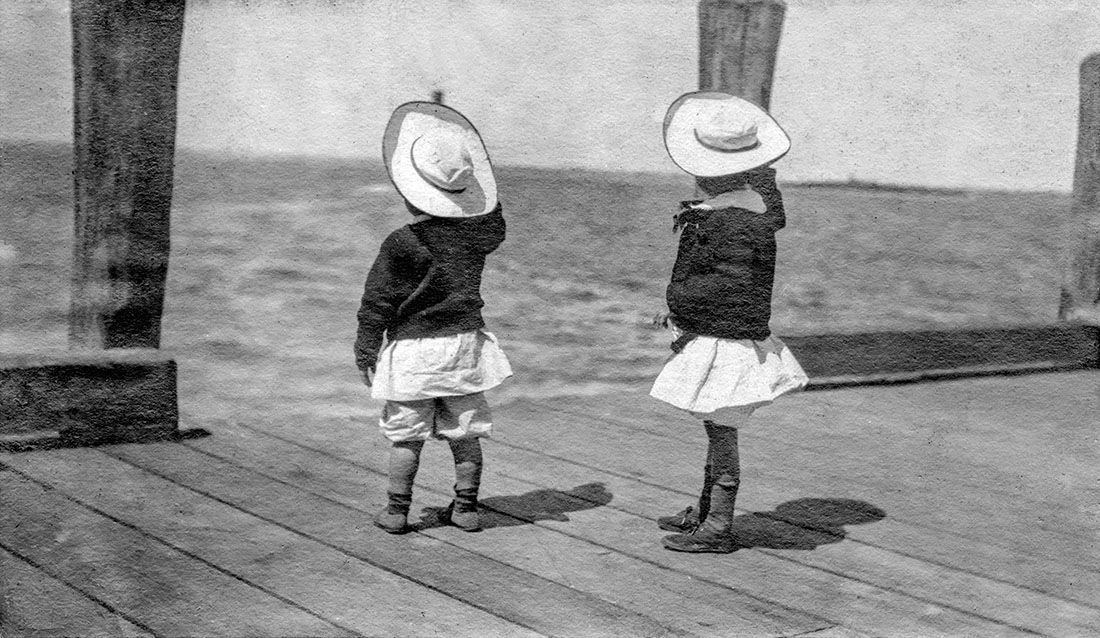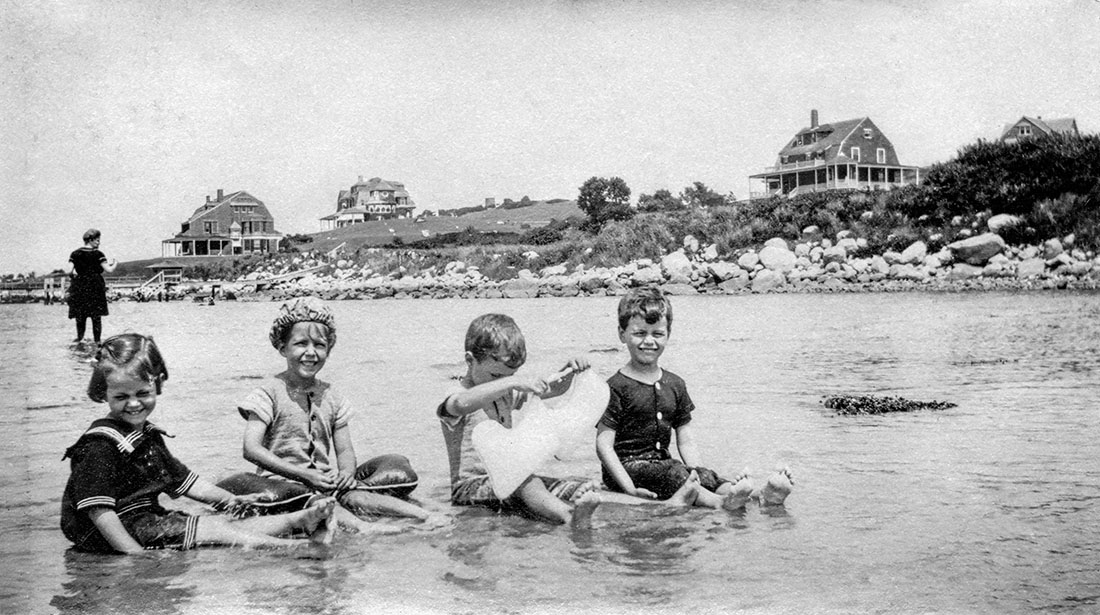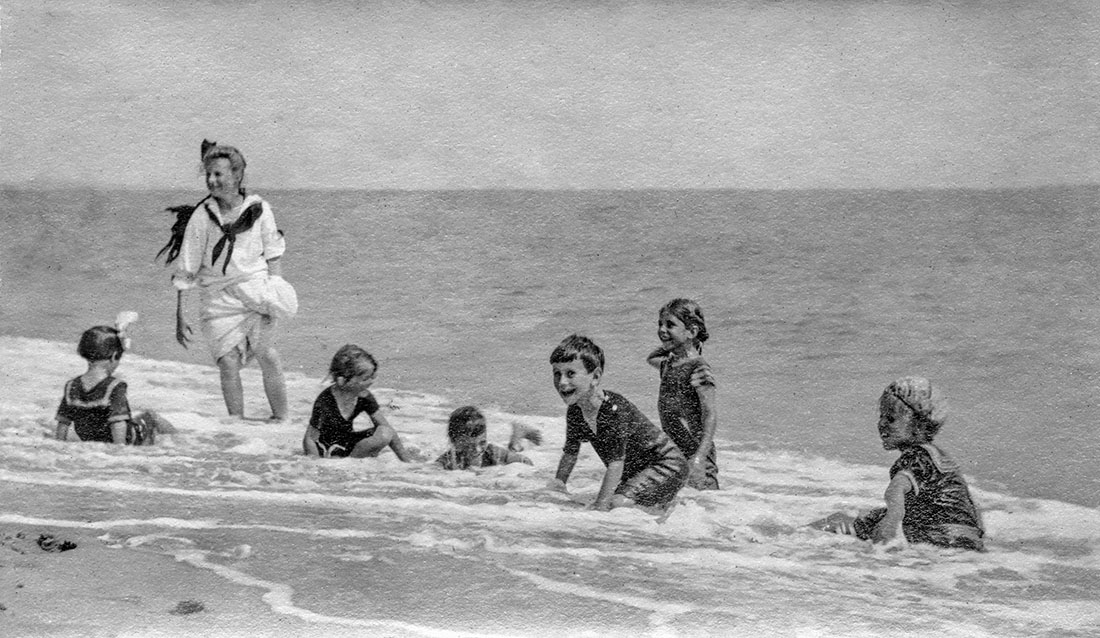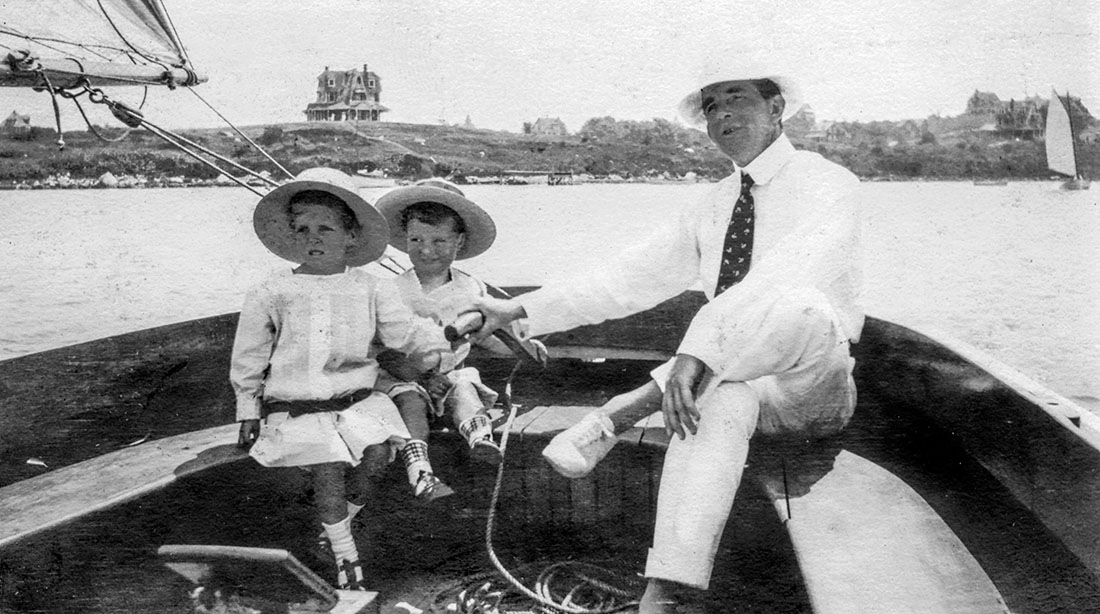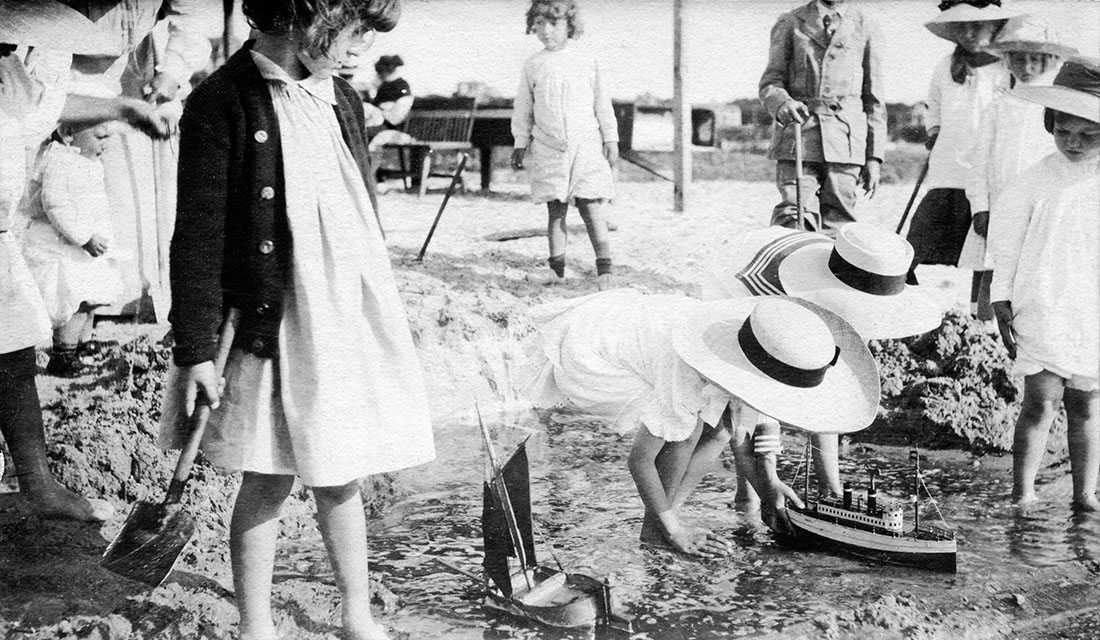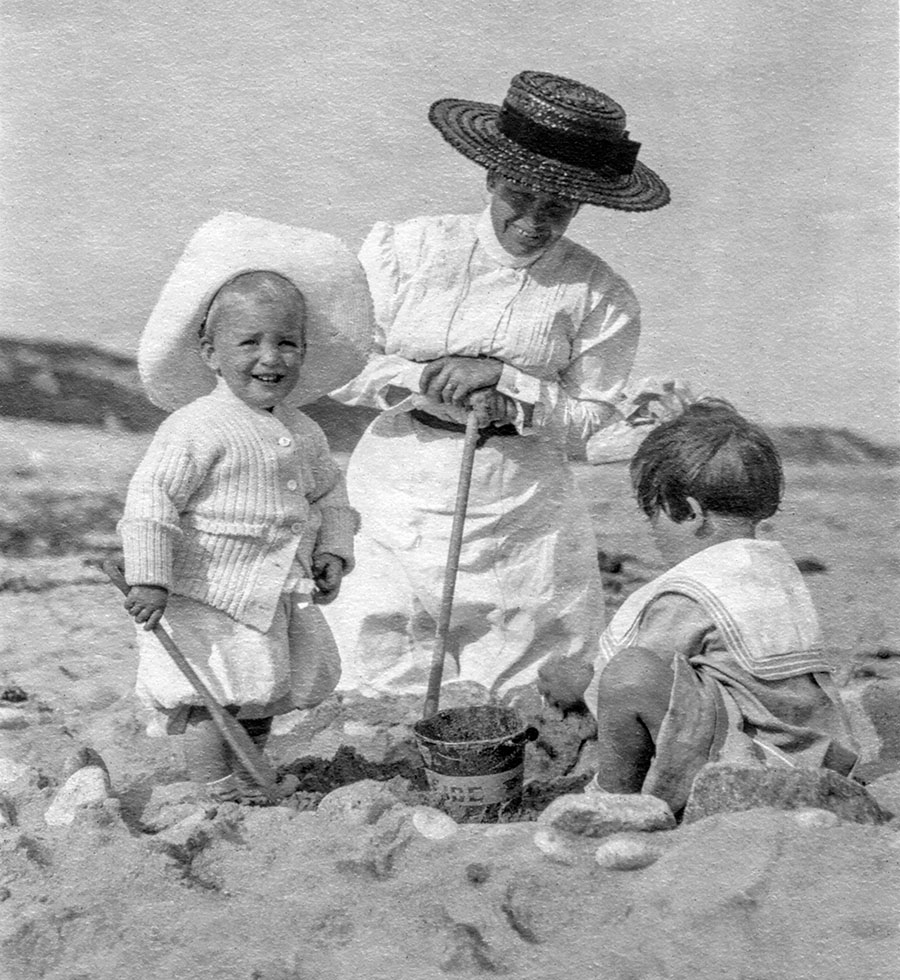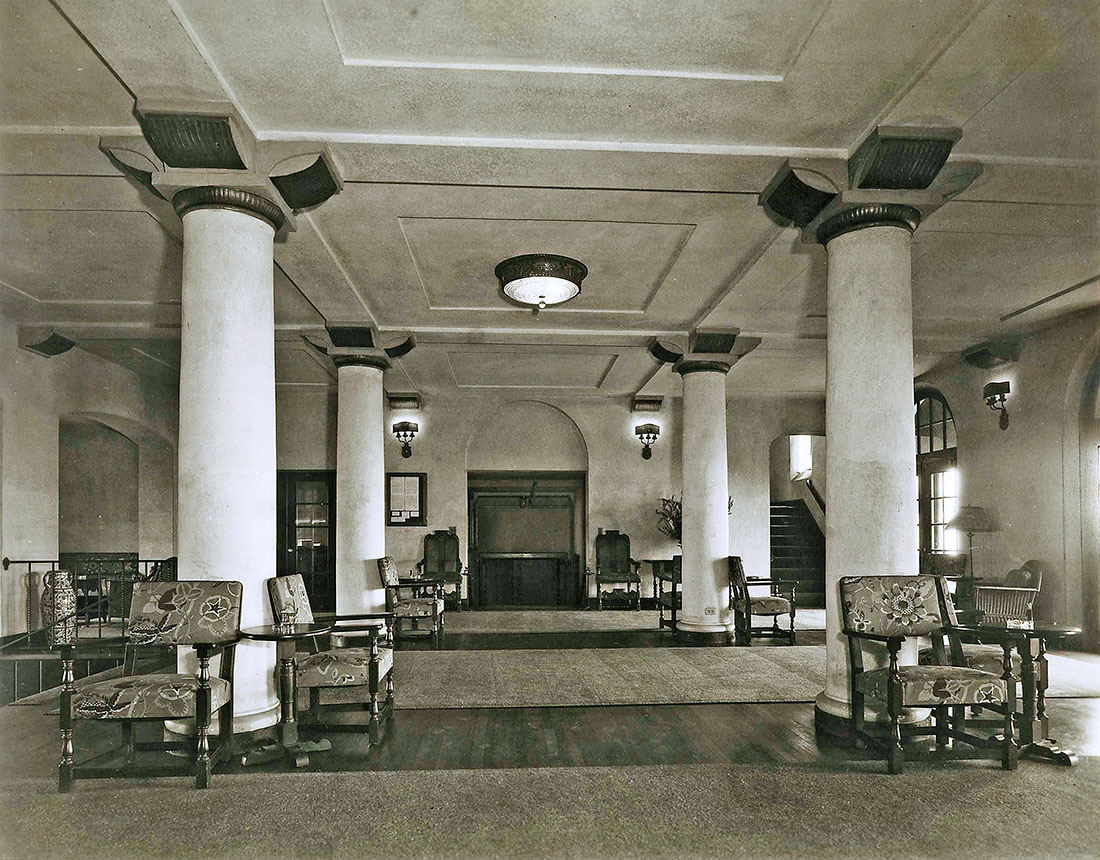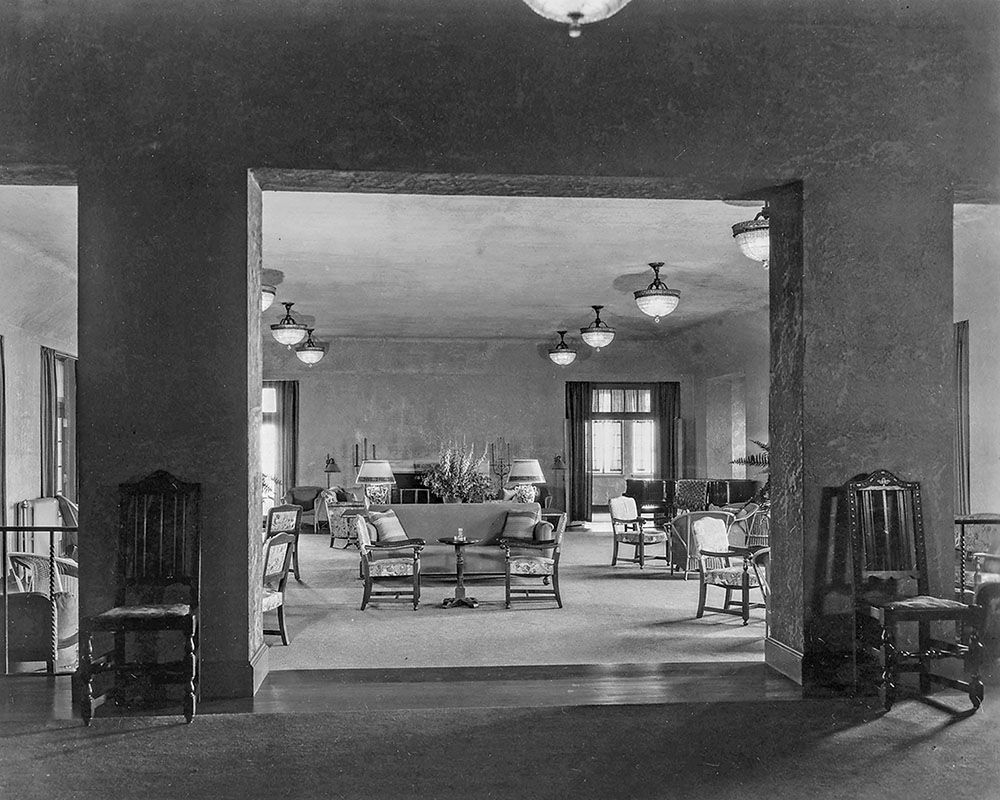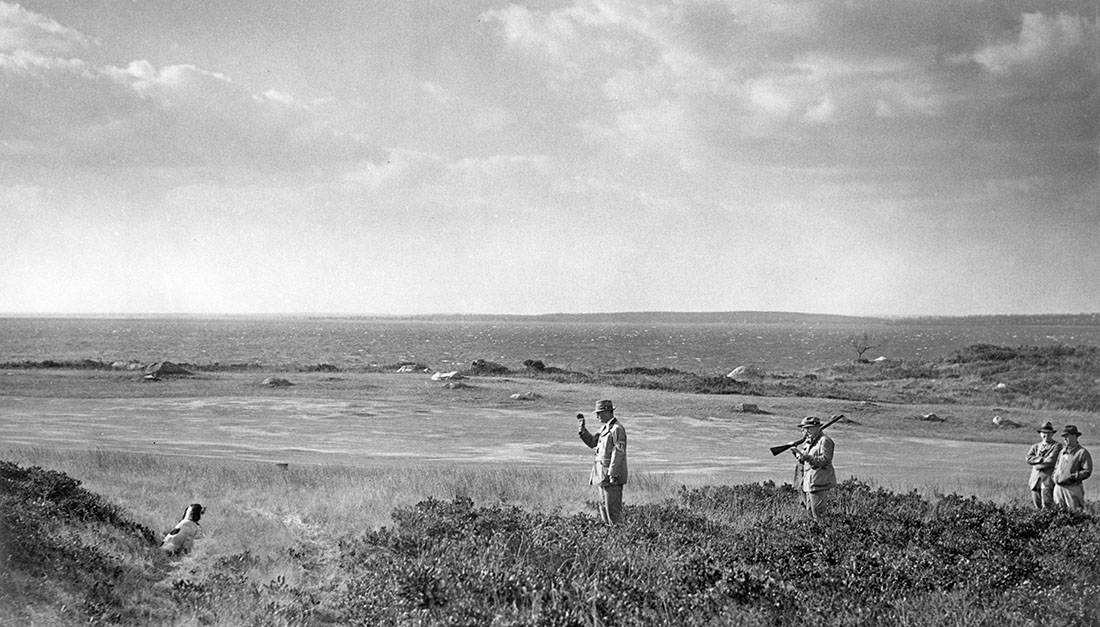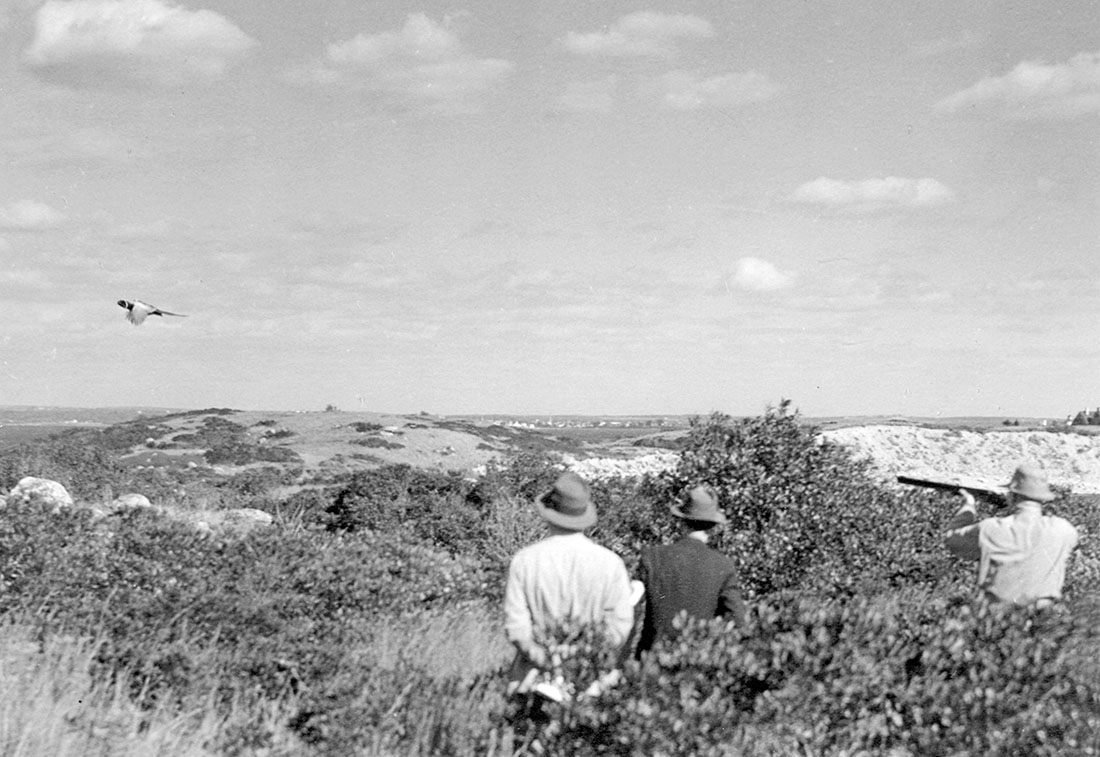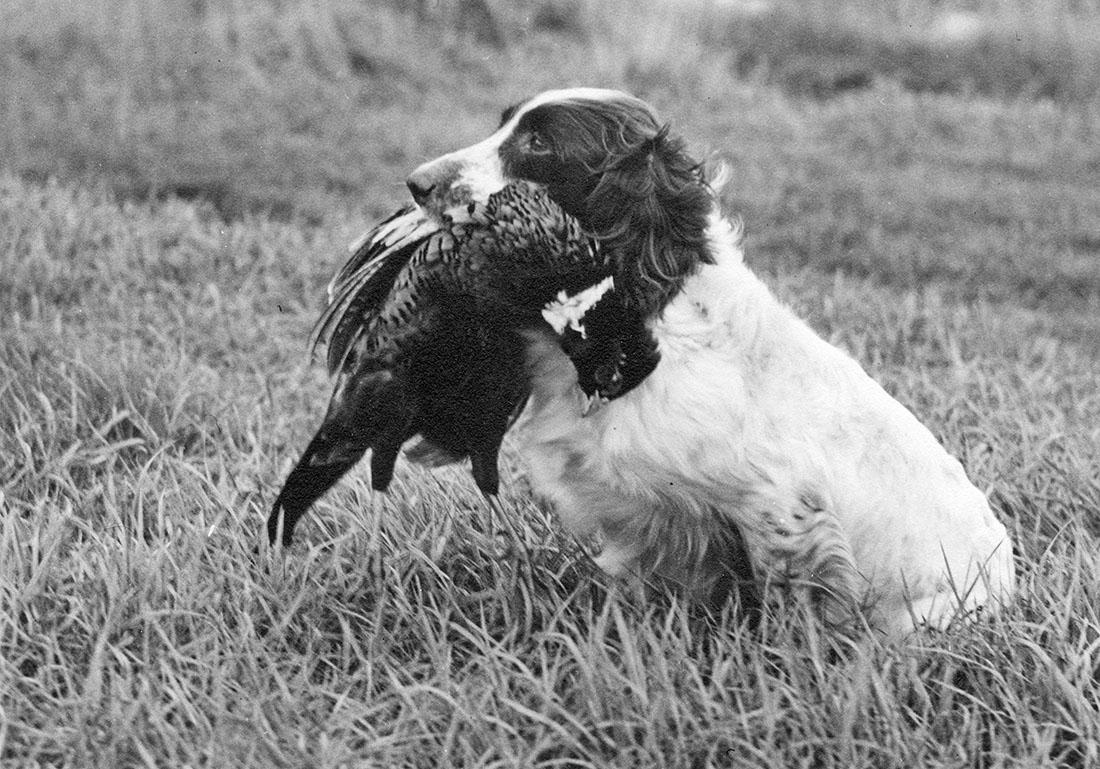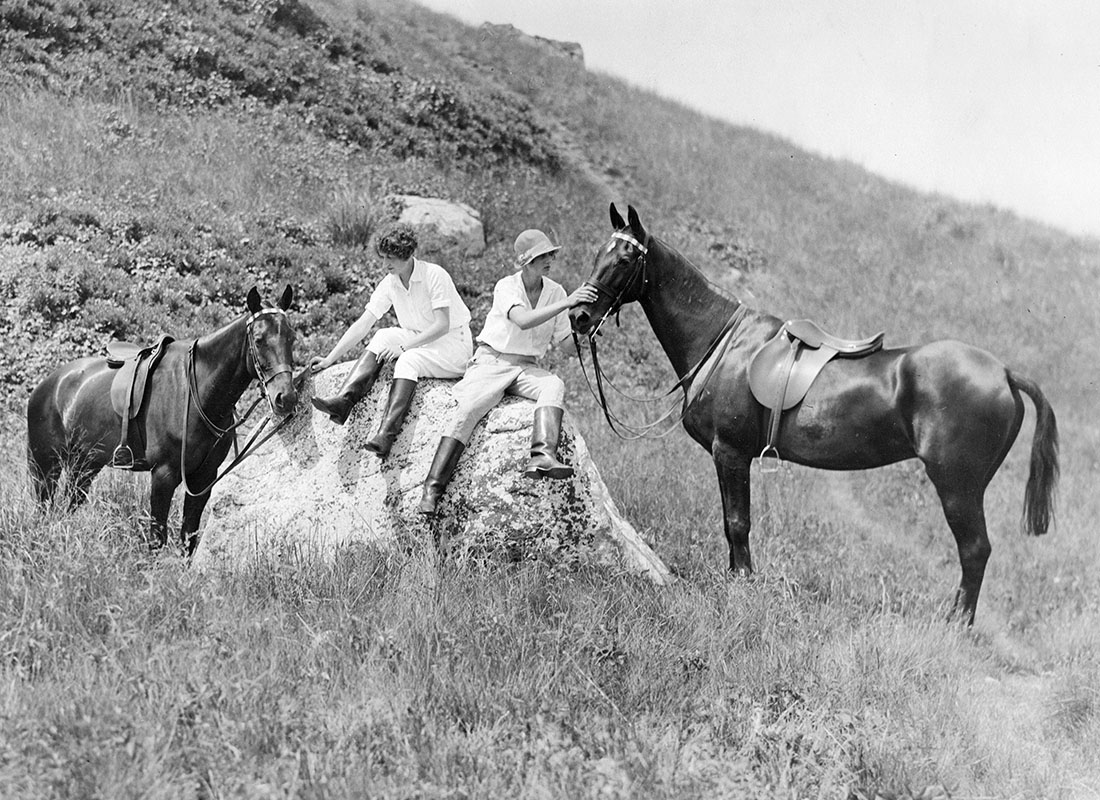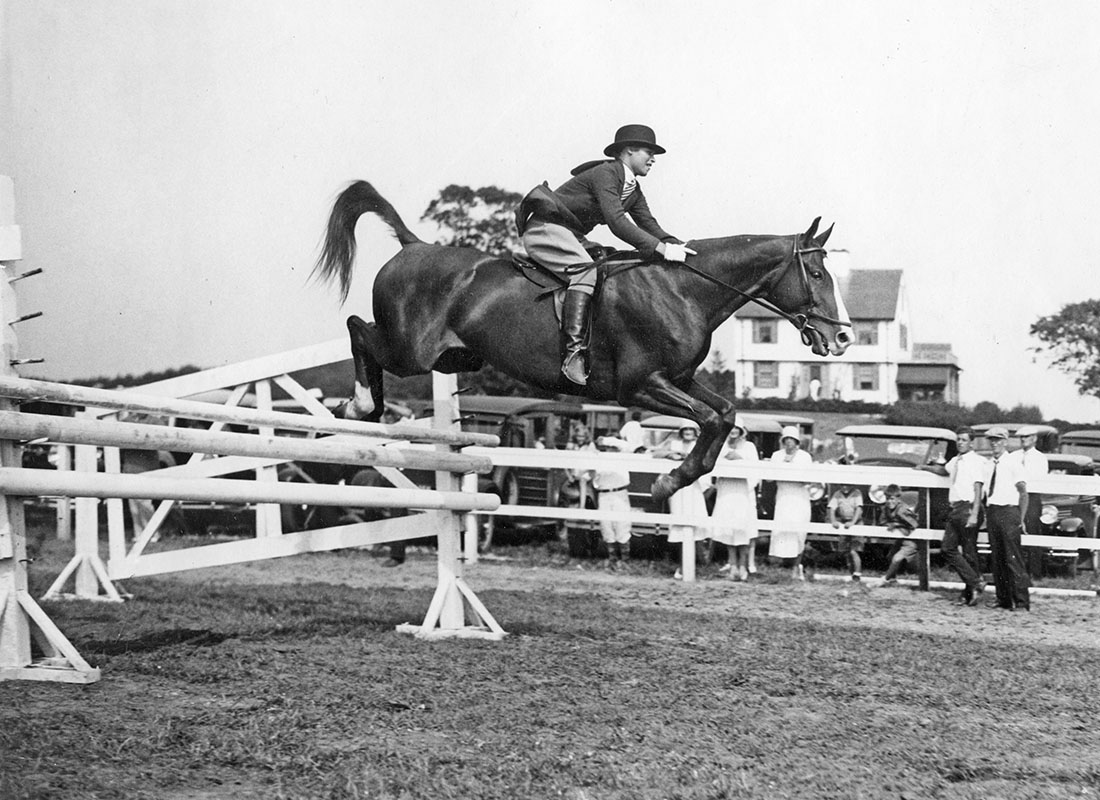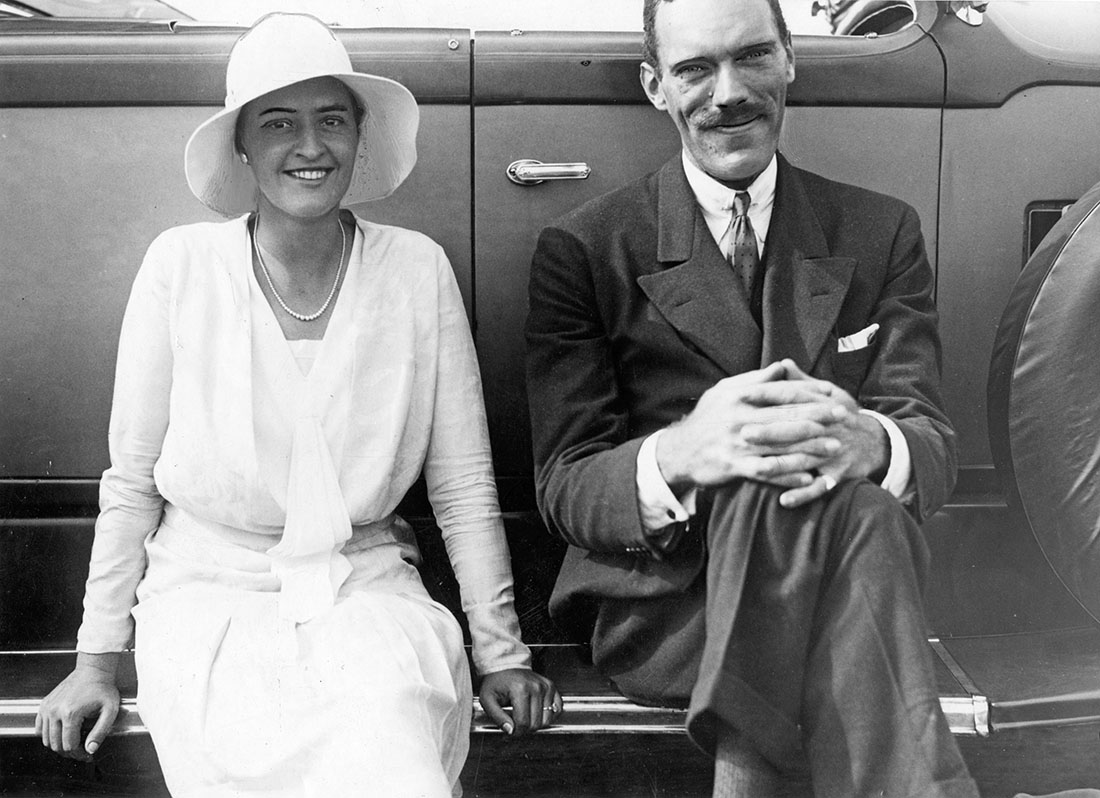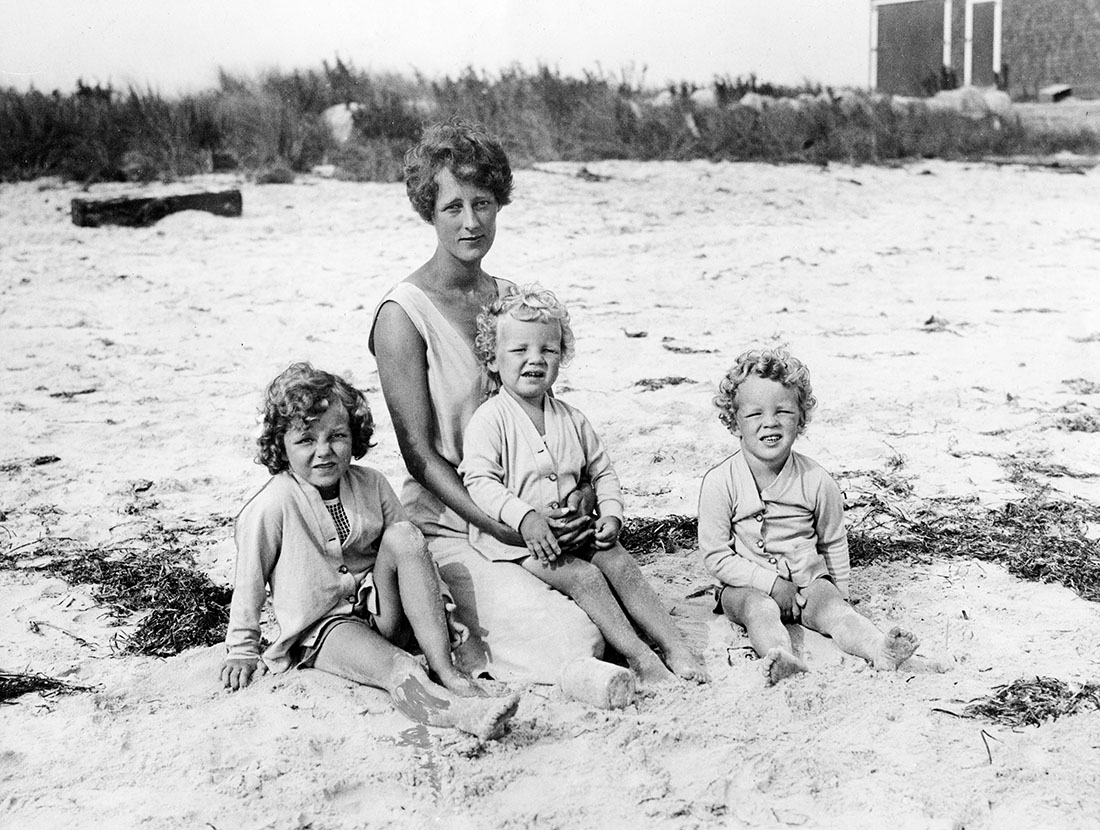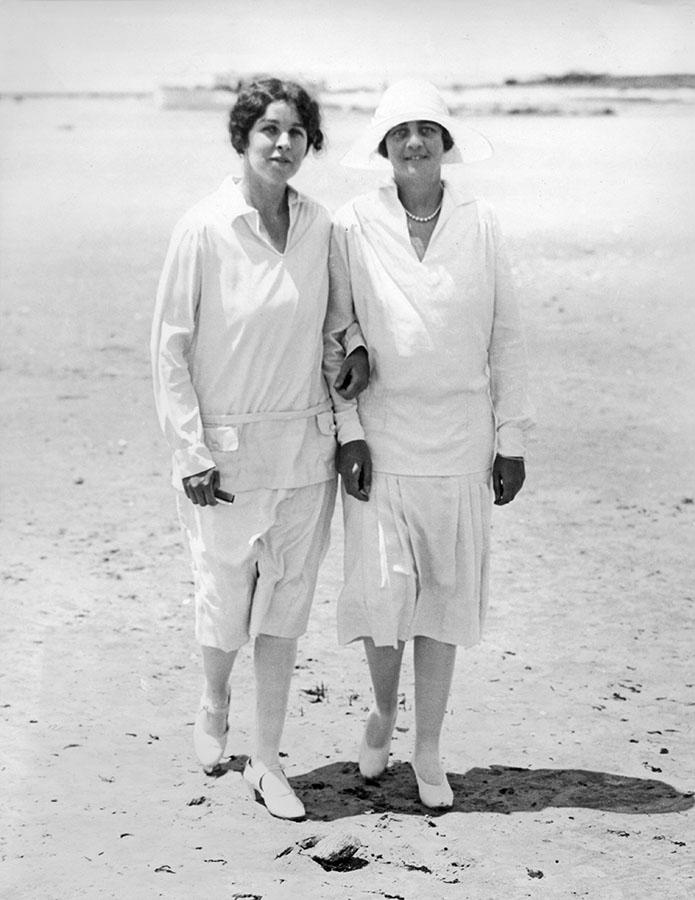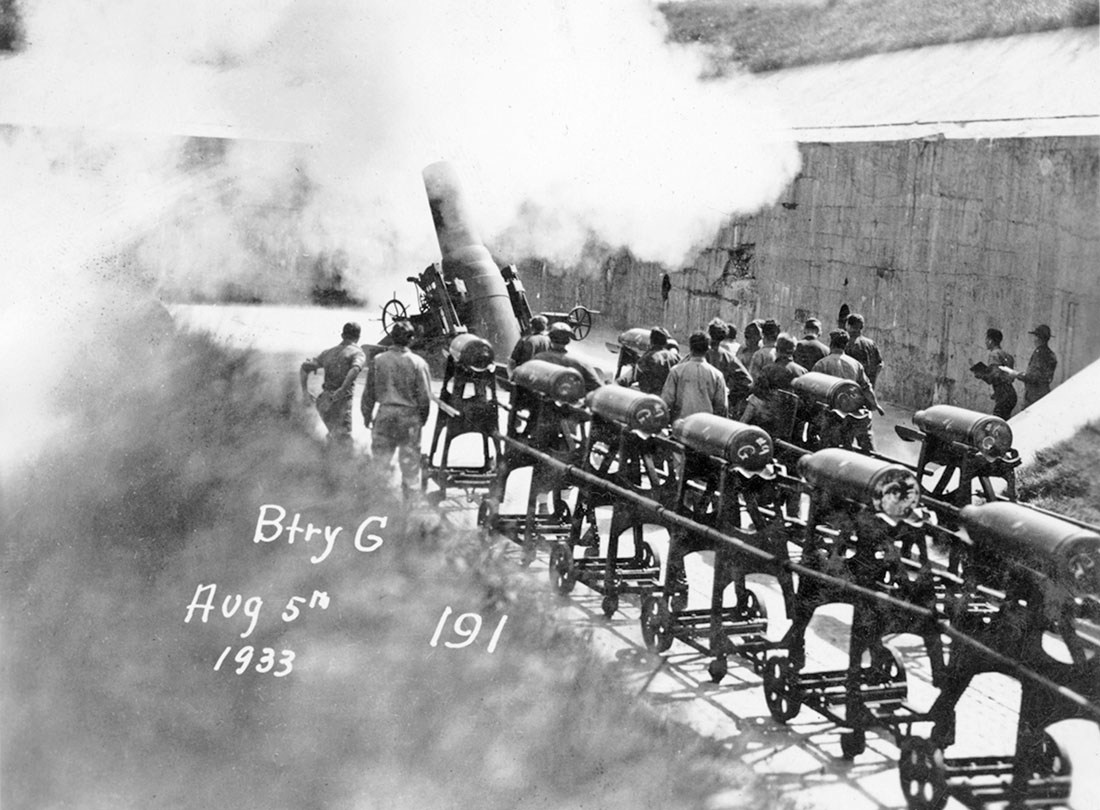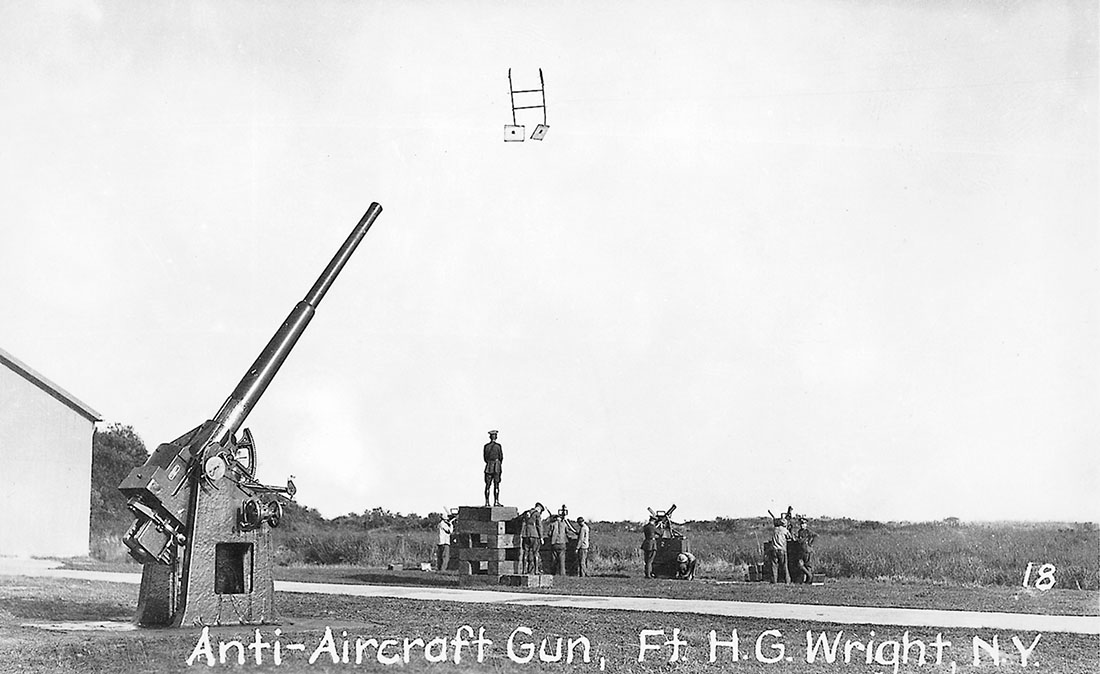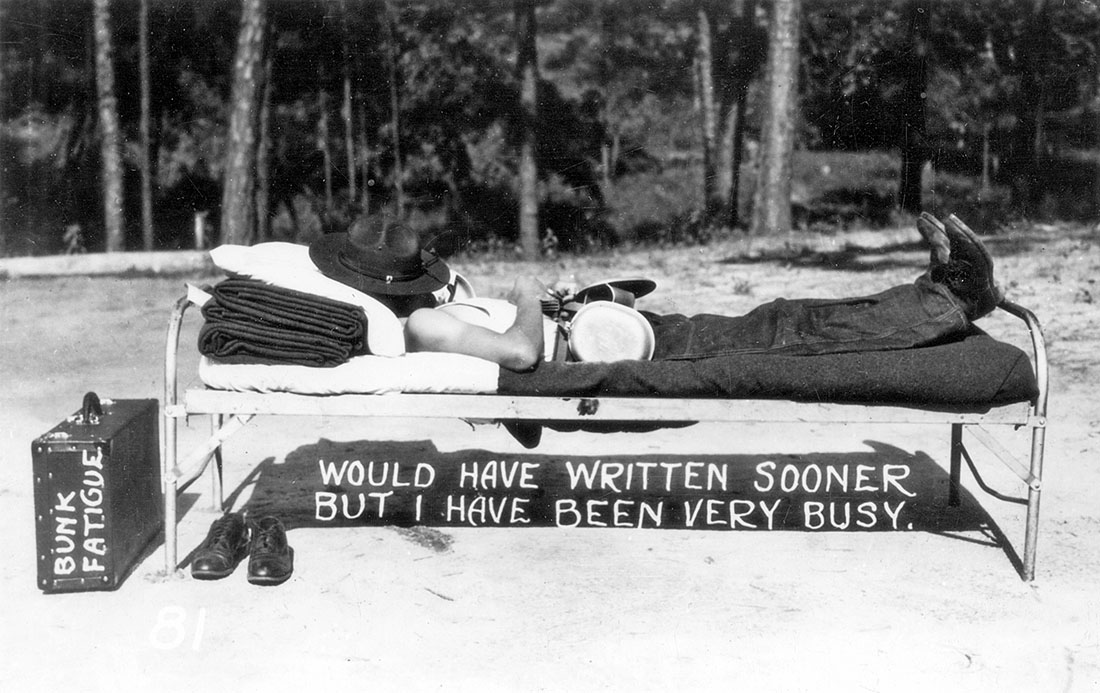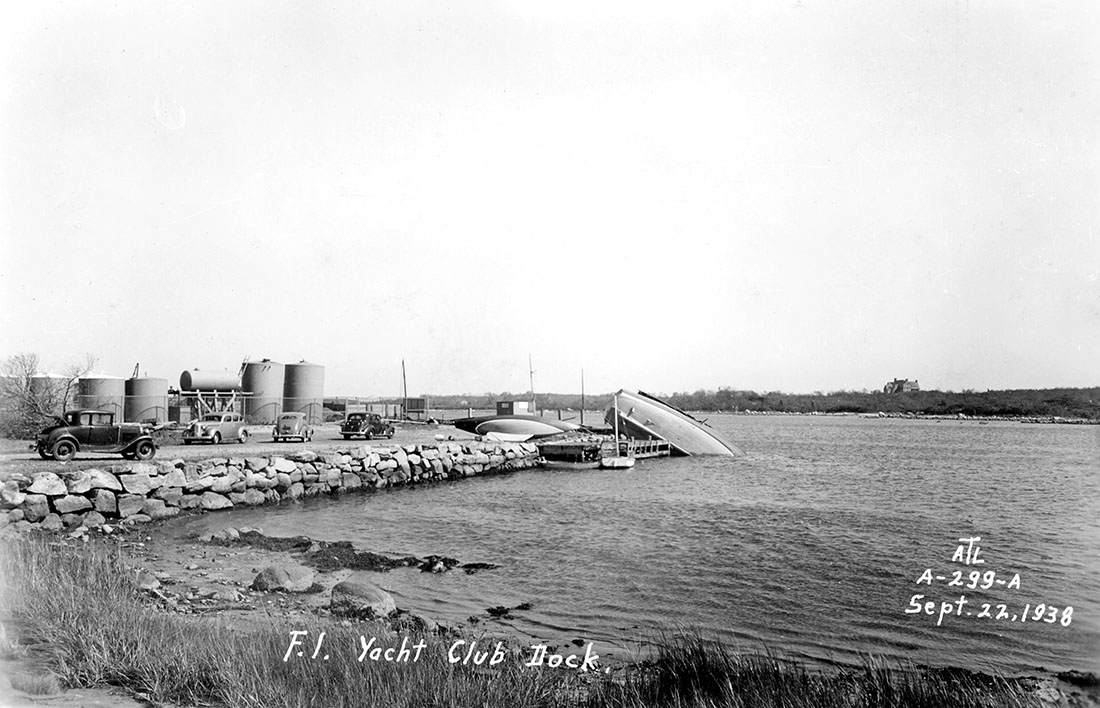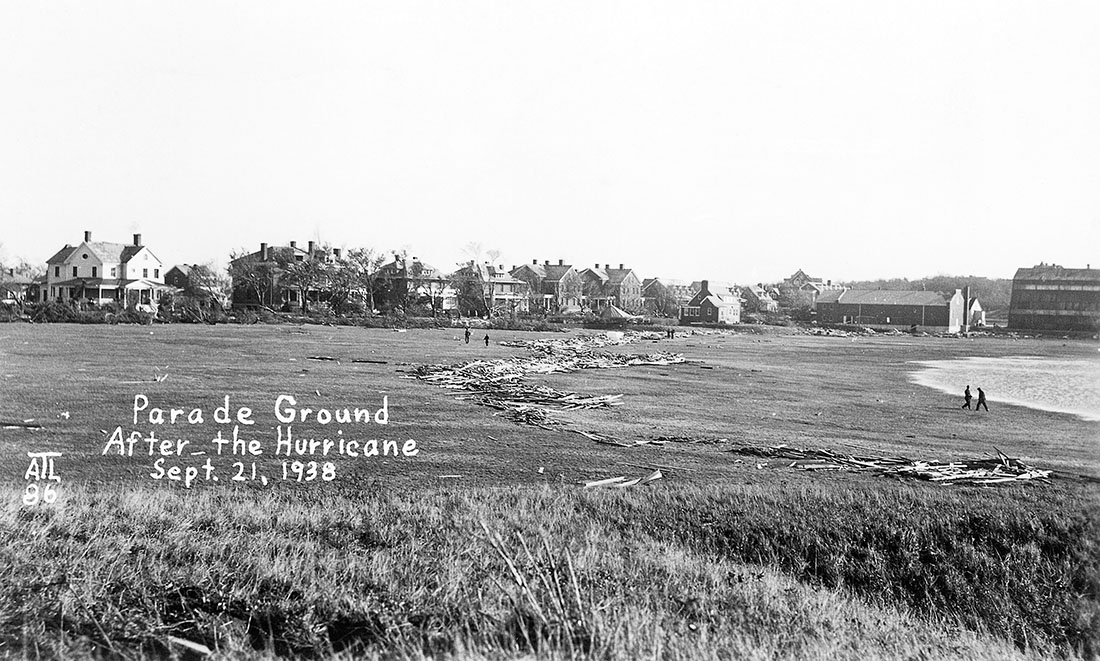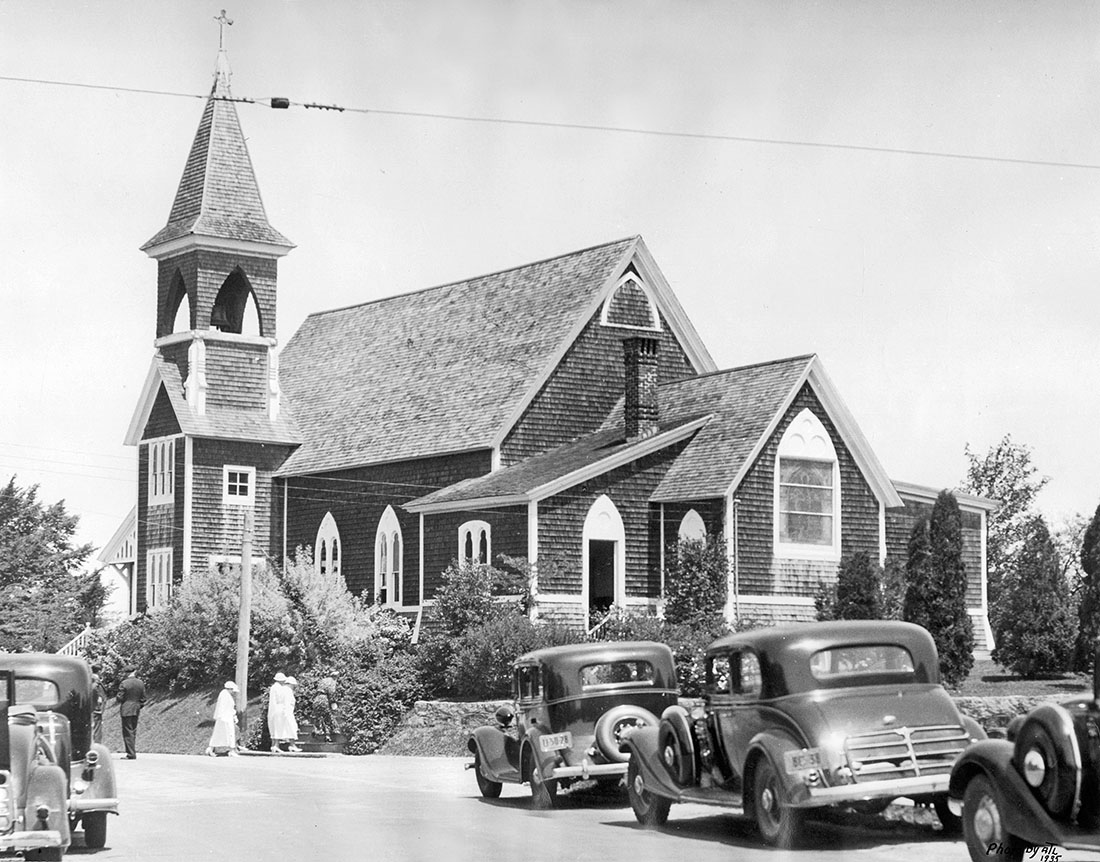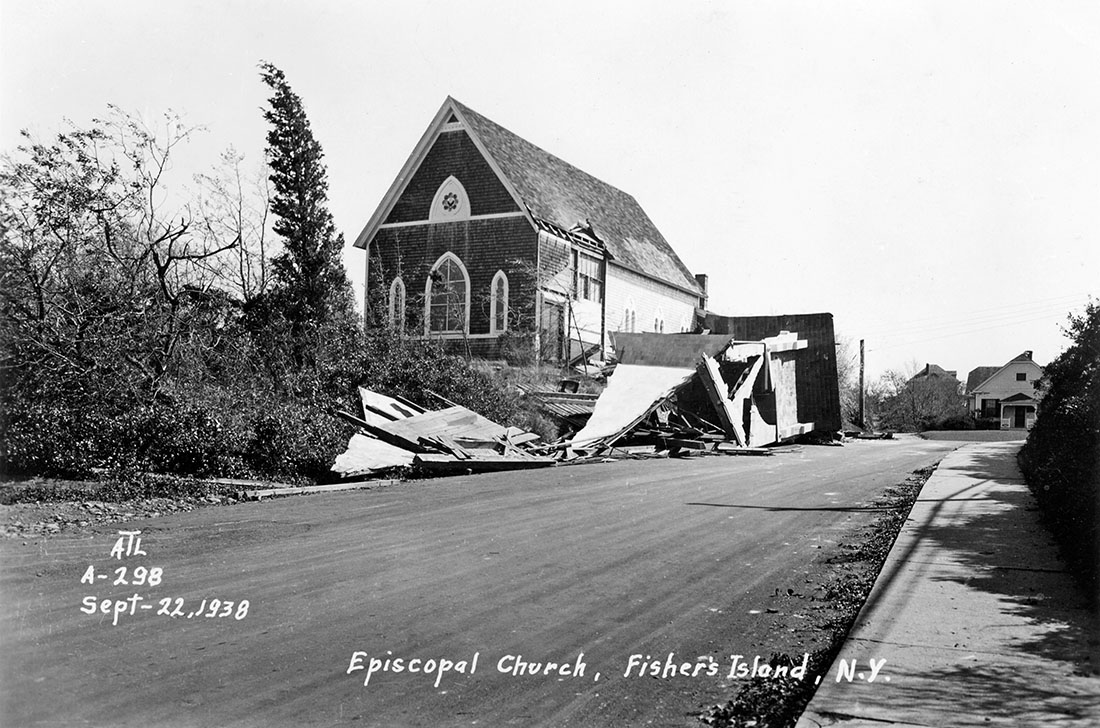ANNUAL EXHIBITION 2017
Photographers Of Fishers Island, Part One
Curated by HLFM director Pierce Rafferty
The 2017 exhibition celebrated the first photographers of Fishers Island. Some were professionals, some amateurs, but together they provide a multifaceted portrait of island life and a clear reflection of yesteryear’s landscapes, beachscapes and architecture.
Woman photographing dog on barrel, South Beach, Fishers Island, N.Y.
c.1913. Photograph by Brown & Dawson, Stamford, Conn. Museum Collection. Donated by Harry & Susie Ferguson
The Brown & Dawson studio was hired by the Fergusons, primary owners of Fishers Island, to take many of the photographs used in their promotional brochures in the mid-1910s. Unfortunately, no record exists of the name of the woman photographer pictured at left.
Please note the safety “surf line” in center back-ground that stretched from wooden posts on shore to the shallows to help stabilize bathers as they entered the surf, an amenity that disappeared more than a century ago.
The earliest photographs on display date from the 1880s and 1890s with one exception, an outlier from 1846 that shows the Steamer Atlantic wrecked below North Hill (see below). The relatively late dates for almost all of our “early” photographs are not surprising when you consider that Fishers Island was a private working farm until the mid-1870s. Photographers would have had a difficult time gaining access.
Drawing copied from daguerreotype showing wreck of the Steamer Atlantic, North Hill, Fishers Island, N.Y.
Originally published in the New York Herald December 10, 1846
Republished in The Lookout, September 1927 issue by the Seamen’s Church Institute of New York.
Museum Collection. Donated by Harry & Susie Ferguson
This reproduction reveals the existence of an outlier photograph that precedes by more that three
decades the next known photograph taken on Fishers Island. Unfortunately, the original daguerreotype that was taken by E. Williams Pratt has not been located despite sustained research efforts.
Mr. Pratt, whose studio was on Bank Street in New London, advertised that his view of the wrecked Atlantic was “taken at Fisher’s Island, the real scene, and not from a painted picture. It is therefore more accurate than any sketch can be.” Given his stated aversion to artistic renditions, it is quite ironic that a sketch drawn from his “real scene” daguerreotype is all that is known to exist of his Atlantic image today.
Everything changed when land sales opened up Fishers Island to the outside world in the late 1870s. One of the many mainlanders who bought a land lot and built a house here was James S. Casey of Voluntown, Conn. By the mid- to late-1880s, he was working as the island’s first resident photographer. He arrived at the beginning of a dynamic and transformative period on Fishers Island; the year-round community was establishing itself along the shores of Great Hay Harbor (today’s West Harbor) and a nascent summer colony was doing the same along Little Hay Harbor (today’s Hay Harbor). Using a large-format camera with glass plate negatives, Mr. Casey photographed people as well as newly-constructed hotels, houses, businesses, roads and docks. He roamed the island meticulously composing and capturing images of the strikingly open vistas that then characterized the island’s landscapes.
James S. Casey
James S. Casey, born in 1835 and died in 1918, was Fishers Island’s first resident photographer. He lived in and worked out of this cottage from the late 1870s to the late 1910s. His cottage still stands at the base of the hill known as “Scrappy Hill” across from the former Grebe/Stern house, now Shillo.
Lynch Cottage (formerly Casey)
June 2010
Museum Collection. Photograph by Pierce Rafferty
The Casey cottage, built circa 1877, was one of the first houses built on Fishers Island after land sales began in December 1876. Today it is owned by Patricia Lynch and her brother Kevin.
In an interview in The Day published on July 17, 1914, Mr. Casey estimated that he had “a half ton of negatives of different views of the island and vicinity in his cellar, and many in the attic of his home.” Tragically, none of these large format glass negatives has ever been located. Only a sampling of Casey’s photographic work survives as positive prints mounted on board. Optimistically speaking, there is always a chance that many more of Casey’s photographs will surface in the decades to come.
James S. Casey’s photographic stamp
c.1890s
Museum Collection
Mr. Casey’s photographs were typically mounted on tan board until circa 1900 and grey/black board after that date. They almost always have his photographer’s stamp on the reverse side. Should you locate a Casey photograph in your private collection, please contact the Museum as we are unabashedly seeking all examples of his work.
Looking past boulders to a bare North Hill, Fishers Island, N.Y.
c.1892
Photograph by James S. Casey
Museum Collection. Donated by Mary Jean Pelham
Mr. Casey’s photographs from the late 19th century provide the best surviving visual record of a mostly treeless island with vistas that are strikingly open and uninterrupted compared to today’s truncated views.
The photographer was standing near the future site of the Walton Ferguson residence (later Ridgway, today Warden). By the 1890s, Fishers Island had been largely stripped of trees and vegetation, both from centuries of cropping by sheep and cattle, and from the shipping of wood to market.
Walton Ferguson House (later Ridgway), Fishers Island, N.Y.
c.1895
Photograph by James S. Casey
Museum Collection. Donated by Katherine Arnold
In addition to his extensive work photographing the island’s landscapes and beachscapes, Mr. Casey also documented many of the new buildings and residences that were cropping up in the 1880s and 1890s as Fishers Island was first developing as a resort.
Fones House overlooking Fones Pond, Fishers Island, N.Y.
c.1890
Photograph by James S. Casey
Museum Collection. Donated by Harry & Susie Ferguson
Today this house belongs to Richard and Lowri Foyle. The pond was filled in by E.M. & W. Ferguson circa 1898 prior to the building of their Administration Building, today’s Post Office and Fishers Island Utility Co. building.
St. John’s Hill, Fishers Island, N.Y.
c.1888
Photograph attributed to James S. Casey
Museum Collection. Donated by Katherine Arnold
This photograph was taken from the edge of what is today Town Green looking southeast on Oriental Avenue. The horse and buggy is standing in front of the Christian Hansen residence, with St. John’s Episcopal Church in center background, and the Fishers Island School (today’s Library) in far background.
Wilbur’s General Store overlooking Fones Pond, Fishers Island, N.Y.
c.1890
Photograph by James S. Casey
Museum Collection. Donated by Harry & Susie Ferguson
In the 1880s, William G. Wilbur, a grocer from Noank, Conn., established what was likely Fishers Island’s first general store and grocery.
Wilbur’s Store currently houses Topper’s Ice Cream, Shutters ‘n Sails, and the Drink ‘n Vessel liquor store. Fones Pond, seen in foreground, covered part of what is today the Town Green.
Abandoned Life-Saving Station, Race Point, Fishers Island, N.Y.
1894
Photograph by James S. Casey
Museum Collection. Donated by Polly Edmonds
In response to disasters like the wreck of the Steamer Atlantic, the U.S. government funded the construction in 1849 of a chain of life-saving stations along the coast of New Jersey and Long Island, including one at Race Point. These simple structures were typically equipped with lanterns, a lifeboat, a metallic “life-car” (seen outside door), and mortars to fire lifelines out to distressed ships.
Manned only by volunteers, the “wreck stations” often suffered from neglect and pilferage. Fishers Island’s station was rebuilt in the early 1870s, but quickly deteriorated due to the absence of professional “surfmen.”
Lyles Cottage, Fishers Island, N.Y.
c.1880s
Photograph by James S. Casey
Museum Collection. Donated by Beardsley
Lyles Cottage, built in 1877, is located on the hill across from the Post Office. It is currently owned by Cecil and Linda Lyon. This photograph was taken from the grounds of Murdock Cottage (today’s No Vue). St. John’s steeple is visible at right along with the Lyles cottage stable or barn—today’s Red Barn Gallery. Note that the Red Barn structure used to be on the opposite side of the hill from where it is today. It was likely moved from a spot at the base of the west side of the hill to avoid interfering with a new road named Athol-Crescent.
Mononotto Inn overlooking Hay Harbor, Fishers Island, N.Y.
September 1893
Photograph by James S. Casey
Museum Collection. Donated by Polly Edmonds
The Mononotto Inn opened in 1893 on a bluff overlooking Hay Harbor. At the time of this photo, some construction was still ongoing as workmen are visible at right and the stone wall along the bluff had yet to be built.
Please note the rough and tumble, boulder-strewn peninsula in foreground. It was later rebuilt into a far more manicured “Tennis Raquet Island.” In the early 20th century, its stone-lined handle and head provided the dock approach and landing for the Ferguson’s Steam yacht Vega.
Catboat Penguin sailing into Hay Harbor
c.1893
Photograph by James S. Casey
Museum Collection. Donated by Polly Edmonds
This classic view of George H. Bartlett’s catboat The Penguin entering Hay Harbor was used on the cover of the Fishers Island Yacht Club’s history, “Sailing at Fishers.” Bartlett was the founder of the first yacht club on Fishers Island in 1886.
The houses in background are, from left to right: a Bowers Cottage (later Willard, then Furse), a second Bowers Cottage (destroyed by fire in 1918), and a third Bowers Cottage that was expanded circa 1910 into the Gaillard’s “Weltevreden,” and razed in 1972.
Bathhouses and Bathing Pavilion on South Beach
c.1895
Photograph by James S. Casey
Museum Collection. Donated by Polly Edmonds
The number of bathhouses and the substantive Bathing Pavilion reveal how popular South Beach was during the pre-automobile era. It was the social beach. At the time, the island’s east end beaches were very difficult to reach by horse and buggy over rutted dirt roads.
Munnatawket Hotel dock, Fishers Island, N.Y.
c.1898
Photograph by James S. Casey
Museum Collection. Donated by Mary Jean Pelham
Please note the passenger ferry S.S. Munnatawket partially visible at end of dock. Built in 1890, it was the first of three Ferguson commissioned passenger ferries.
Note also the two-story waiting pavilion at right that doubled as a freight building on its lower level. When the Munnatawket Dock was torn down in the mid-1920s, this building was moved to the Mansion House wharf where it continued to serve as a freight shed. When the Mansion House wharf was torn down in 1959, the building was moved once again, this time to shore. After considerable remodeling, it became the Gordon Ahman residence that still stands overlooking West Harbor just south of Madeline Ave.
Munnatawket Dock Scene, Fishers Island, N.Y.
Color postcard published by W.G. Wilbur, Fishers Island, N.Y., c.1910
Reprinted from photograph by James S. Casey, c.1898
Museum Collection. Donated by Pierce Rafferty
Many of Mr. Casey’s most iconic images of Fishers Island were reprinted in the 1910s and 1920s as postcards with color added during the printing process. William G. Wilbur sold cards that he published at his General Store.
Looking southwest over Island Pond (today’s Oyster Pond) with stone wall in foreground
1893
Photograph by James S. Casey
Museum Collection. Donated by Harry and Susie Ferguson
This photograph was taken from the hill just east of today’s Filtration Plant, looking toward the future site of the Hardy/ Mallory/ O’Keefe house. It reveals an expanse of undeveloped, close-cropped pastureland that characterized the east end of Fishers Island before the the Olmsted Plan development in the mid-1920s.
Although many credit the 1938 Hurricane with blowing in seed that reforested Fishers Island and spread invasives, the primary cause of the unruly vegetative growth seen on island today was the cessation of farming on Fishers Island, specifically the removal of sheep in the mid-1910s and cows in the mid-1920s in advance of the planned residential colony.
Island Lake, Fishers Island, N.Y.
Color postcard published by W.G. Wilbur, Fishers Island, N.Y., c.1910
Reprinted from photograph by James S. Casey, c.1893
Museum Collection. Donated by Polly Edmonds
The ruins of the depicted stone wall are still visible today beneath the Recreation Path at the base of the hill as you head east past the Filtration Plant. The gated wall was one of a series of controls for cattle and sheep built when stock farming was the dominant business on the island.
Please note the photographer’s cane and boater hat in left foreground.
Hungry Point, Fishers Island, N.Y.
1893
Photograph by James S. Casey
Museum Collection. Donated by Sandy Esser
This much-reproduced Casey photograph features wooden fencing leading to a scenic hillock known as “Hungry Point” that overlooks East Harbor. The whys and wherefores of the name are long forgotten.
In the late-1920s, this location became the site of the H. Arnold Jackson residence that is today owned by Helen Scott Reid. The tree did not survive the transition.
Hungry Point, Fishers Island, N.Y.
Color postcard published by W.G. Wilbur, Fishers Island, N.Y., c.1910
Reprinted from photograph by James S. Casey, 1893
Museum Collection. Museum Acquisition Fund
Note that the island’s farmers used the shoreline as a natural boundary for containing livestock, thus minimizing the amount of fencing and labor needed to operate the stock farm.
Water swirling around rocks, Fishers Island, N.Y.
c.1890s
Photograph by James S. Casey
Museum Collection. Donated by Harry & Susie Ferguson
On the reverse of one original Casey print of this photograph there is a handwritten note identifying the location: “Dark rocks at Isabella.” However, this image was also reproduced in the early 1900s as an aluminum postcard with the title: “South Beach Scene.” Whatever the location, it is certainly one of James S. Casey’s most arresting beachscapes.
Isabella Beach with bathhouses and a Bathing Pavilion
c.1890s
Photograph by James S. Casey
Museum Collection. Unknown donor
Although horse and buggy trips to Isabella Beach in the 1890s demanded a considerable allotment of time, enough beachgoers made the journey that E.M. & W. Ferguson considerately erected a few bathhouses and a Bathing Pavilion just above the beach’s rockline.
Bartlett Cottages before construction of Garrett B. Linderman residence, Fishers Island, N.Y.
c.1896
Photograph by James S. Casey
Museum Collection. Donated by Sandy Esser
Between 1878 and 1888, George H. Bartlett built twelve rental cottages that were located on land overlooking Hay Harbor and along an adjacent stretch of Equestrian Ave. They were organized as a cottage colony with a central dining room.
After prominent banker and industrialist Garrett B. Linderman of Bethlehem, Penn., expressed a desire to build a mansion on land occupied by at least five of these cottages, the cluster was significantly broken up. Please see the photograph below that shows the arrangement of the Bartlett Cottages after the completion of the G.B. Linderman mansion (later owned by Zimabalist/Gluck, today by the Baccile family).
Bartlett Cottages after construction of Garrett B. Linderman Residence
c.1902
Photograph by James S. Casey
Museum Collection. Donated by Polly Edmonds
Please compare this view to the one depicted in the “before construction” photograph posted above. Note how the houses along the ridge line closest to Hay Harbor have been totally cleared out to make room for the Garrett B. Linderman residence, seen at far left of this photo. Built in 1898-1899, it is today owned by the Baccile family. The only house along the water not cleared out was the triangular-shaped Anchorage in left foreground that still stands today.
Note also that two of the displaced Bartlett Cottages were moved and joined together to form the residence “Seven Gables.” The merged structure can be seen at right center two houses to the left of the windmills. The other three Bartlett Cottages at the edge of the harbor were razed.
View Looking East, Prospect Hill, Fishers Island, N.Y.
c.1895
Photograph by James S. Casey
Museum Collection. Donated by Harry & Susie Ferguson
This rare view depicts Durfee Meadow, future site of the Hay Harbor golf course, when it was still under cultivation as part of the West End Farm. The Southwick residence (today Sinclair) is prominent in left background. Note that only the western portion of the meadow appears to be planted. Records reveal that oats were sown at this location just before a “golfing ground” displaced farming activities.
Golf was introduced to Durfee Meadow in 1897 when the Fergusons created what was likely a 5-hole course. A new Golf Club—backed by investors from the community, and by Ferguson and Linderman family members—built a nine hole course over Durfee Meadow in 1901. That club and its golf course formally merged with the Hay Harbor Club in 1910.
By the early 1900s, Casey was joined by and faced competition from newly arrived photographers who were using new-fangled roll film. Their ranks included itinerant photographers who seasonally traveled to the island with a targeted clientele in mind (photographing soldiers at Fort Wright, for example). A carefully-considered sampling of work from each of these Fishers Island photographers was the organizing principle for this exhibition.
“Part One” ends with the 1938 Hurricane. We hope that you enjoy the show!
U.S. Army Corps Of Engineers
The U.S. Government sent a team of photographers with large format cameras to document Army-Navy mock warfare maneuvers that had been designed to test the region’s coast defenses. The assigned photographers provided invaluable documentation of both the ‘attack’ and the full array of shore-based defenses.
In addition to documenting the Army-Navy maneuvers, the Corps of Engineers team was also assigned to photograph areas of Fishers Island that were of strategic interest to the military. Several civilian land parcels were being considered for possible Government acquisition by purchase or by condemnation. The photographs generated by this ancillary mission provide an invaluable record of Fishers Island at the turn of the last century.
Battleships of the North Atlantic Squadron ‘bombarding’ Fishers Island, N.Y.
September 1902
Photograph by U.S. Army Corps of Engineers
Museum Collection. Courtesy of National Archives Donated by Pierce Rafferty
Sixteen warships repeatedly ‘attacked’ the Long Island Sound forts, including Fort H.G. Wright, as seen here.
U.S.S. Kearsarge and an unidentified battleship ‘attacking’ Fort H.G. Wright, Fishers Island, N.Y.
September 1902
Photograph by U.S. Army Corps of Engineers
Museum Collection. Courtesy of National Archives. Donated by Pierce Rafferty
The shacks under attack in foreground are believed to have been occupied by construction workers building the Fort.
Signal Station on Mount Prospect, Fishers Island, N.Y., during Army-Navy maneuvers
September 1902
Photograph by U.S. Army Corps of Engineers
Museum Collection. Courtesy of National Archives. Donated by Pierce Rafferty
During the mock war, soldiers of the Signal Corps atop Mount Prospect kept watch for any sign of the ‘enemy’ fleet. They maintained contact with forts of neighboring islands with an array of signalling equipment, including heliographs and rocket flares.
Gun crew and six-inch disappearing gun at Battery Dutton, Fort H.G. Wright, Fishers Island, N.Y.
September 1902
Photograph by U.S. Army Corps of Engineers
Museum Collection. Courtesy of National Archives. Donated by Pierce Rafferty
Completed in 1901, Battery Dutton was located just to the west of today’s airport terminal. It was one of the new emplacements with disappearing guns that formed the core of the Fort’s defenses. It was filled in with rubble decades ago and is only partially visible.
The Peninsula, Fishers Island, N.Y.
September 1902
Photograph by U.S. Army Corps of Engineers
Museum Collection. Courtesy of National Archives. Donated by Pierce Rafferty
The house at left center (to the right of the stranded boat) is the oldest house that still stands on the Peninsula. It dates to at least 1882, possible to the late 1870s, and is today the home of Madge Rosenberg. The white house at center (with tall chimney) and the brown house to its right were built circa the 1890s. They were later owned by the Hubbards, the Hurlburts, the Farleys, Isis Bartels, Kinlin and Rutherfurd, and currently the Siegelsons. The house at far right was the Dan Brown cottage. It no longer stands.
Garrett B. Linderman property, Fishers Island, N.Y.
September 1902
Photograph by U.S. Army Corps of Engineers
Museum Collection. Courtesy of National Archives. Donated by Pierce Rafferty
G.B. Linderman of Bethlehem, Penn., built a prominent mansion (today Baccile) facing his brother Robert’s equally substantive cottage (today Macleod) across Hay Harbor. The G.B. Linderman residence was sold in 1918 to opera star Alma Gluck and her master violinist husband Efrem Zimabalist Sr. Note the structure at lower right that was Mr. Linderman’s caretaker cottage. It was later moved north just off the Linderman property and is now owned by the von Stade family.
The Winter Settlement
September 1902
Photograph by U.S. Army Corps of Engineers
Museum Collection. Courtesy of National Archives. Donated by Pierce Rafferty
When land sales began on Fishers Island in the late 1870s, a small year round community established itself on the shores of Great Hay Harbor (today’s West Harbor). The houses were anchored by Henry Eldredge’s grocery store and fish market, seen in foreground, located at the site of today’s Island Hardware & BD Remodeling.
The Photographer’s Store was owned in the 1910s and 1920s by George L. Thompson, a commercial photographer based during the season on Fishers Island and during the offseason on 125th Street in New York City. He succeeded James S. Casey as the predominant commercial photographer working on Fishers Island in the early 20th century. Most of his on-island photographic work was done in the 1910s, a decade during which Mr. Casey was semi-retired.
George L. Thompson
Main Street, Fishers Island, N.Y. featuring Photographer’s Building, at right
c.1920 Published by and attributed to G.L. Thompson. Museum Collection. Donated by Polly Edmonds
This image shows from right foreground to left background: The Photographer’s Store, later Gold ‘n Silver [currently Island Outfitters], built in 1908; the Pharmacy, built 1902, destroyed by fire in 1947; and the Meat Market, built in 1896, later the first firehouse, currently The Beach Plum. Wilbur’s Store and Perry Cottage (later Sperry/Harvey) can be seen in far background.
Note the signs and racks promoting the sale of postcards and photos in the windows of his Photographer’s Building.
Mansion House Steam Laundry Fire, Fishers Island, N.Y.
August 16, 1911
Real photo postcards by G.L. Thompson
Museum Collection. Donated by Polly Edmonds
The Laundry, which sat atop the hill on the south side of the Power Plant on West Harbor, was a total loss. Also destroyed was the neighboring cottage, used as sleeping quarters for the employees of the Laundry. The fire fighting was primarily done by soldiers from Fort H.G. Wright as the Fishers Island Fire Dept. had yet to be established.
“The scene was picturesque. Soldiers seemed to have been let loose from everywhere and were running in singles with axes and red fire buckets. Only those doing guard duty were left at the fort to watch things there. Quote from The Day, August 17, 1911.
Cover of Fishers Island, N.Y. on Sea and Sound
1922
Published by G.L. Thompson
Museum Collection
G.L. Thompson published a charming pictorial booklet in 1922 with numerous photographs of Fishers Island, including views of landscapes, residences, hotels, sports, and military life.
Surviving documents reveal that after Mr. Casey died in 1918, Thompson bought all his photographic equipment and his original negatives. Thompson republished many of Casey’s images, including several in this booklet, but also others as individual postcards and printed photographs.
c.1905
Photograph by G.L. Thompson
Museum Collection. Donated by Pierce Rafferty
c.1905
Photograph by G.L. Thompson
Museum Collection. Donated by Pierce Rafferty
For pictorialist atmosphere, it is hard to top “The Landing” by G.L. Thompson. This image was published as part of a series of numbered views that featured white borders on the image side. The photographs were printed halftone in black and white and then sometimes hand colored after printing, as seen here.
Camp Life at Fort H.G. Wright, N.Y.
Camp Life at Fort H.G. Wright, N.Y.
Lithographic postcard published by G.L. Thompson
c.1915
Courtesy of Mary Pankiewicz
Mr. Thompson specialized in photographing and publishing images of the coastal fortifications protecting New York City. He was likely initially drawn to Fishers Island by Fort H.G. Wright.
Studio view of two soldiers in baseball uniforms posing in front of backdrop, Fishers Island, N.Y.
c.1905
Photograph by G.L. Thompson
Courtesy of Jeff and Catherine Edwards
This rare studio view of baseball players from the 100th Company of the Coast Artillery Corps may have been taken within Thompson’s Photographer’s Building on Equestrian Ave., or possibly at Fort Wright using a portable backdrop.
Rumrunner Barbara aground on Fishers Island, N.Y.
March 1925
Photograph by G.L. Thompson
Museum Collection. Donated by Paul Bates
It was scotch on the rocks (450 cases worth) when the rumrunner Barbara went hard aground on Fishers Island on March 19, 1925. The location was just west of Barley Field Cove.
In the mid-1910s, Edward W. Quimby, a Connecticut based photographer, traveled to Fishers Island during the spring and summer where his portrait subjects included groups of students from the school and soldiers from the National Guard encampment located south of the Parade Grounds.
In addition to his portraits of people, Mr. Quimby published real photo postcards of locations that were of general interest to Fishers Islanders.
South Beach, Prospect Hill, Fishers Island, N.Y.
1914
Real photo postcard by Edward W. Quimby
Museum Collection. Donated by Pierce Rafferty
In this real photo postcard, beachgoers at South Beach were likely Mr. Quimby’s target clientele. Note the Bathing Pavilion at far left center that functioned as a “sun shade.”
In July 1909, the Golf Club, a precursor club to the Hay Harbor Club, opened its new clubhouse near the bathhouses and pavilion at South Beach. In late 1914, after suffering damage in storms, the clubhouse, seen here at center, was moved inland to the site that the Hay Harbor Club’s golf clubhouse occupies today.
“12 inch Gun in action” Fort H.G. Wright, N.Y. C.A.C. C.N.G.
1913
Real photo postcard by Edward W. Quimby
Museum Collection. Donated by Pierce Rafferty
This action photograph shows a Coast Artillery Corps gun crew from the Connecticut National Guard firing a12-inch disappearing gun at Battery Butterfield. Each year National Guard companies, primarily from New York, Connecticut, Massachusetts and Rhode Island, traveled to Fort Wright to train on the “big guns.” Cadets from West Point were also frequent visitors. The Fort, founded in April 1900, was both within easy reach of neighboring urban centers and isolated enough to permit the firing of artillery shells at tow targets moving on the water up to 10.5 miles distant.
Battery Butterfield is today the southern-most gun emplacement utilized by the Fishers Island Waste Management’s Composting Station. It held the most powerful armament on Fishers Island until World War II’s 16-inch gun on Wilderness Point.
Coast Artillery Corps soldiers posing with their mascots, Fort H.G. Wright, Fishers Island, N.Y.
1914
Real photo postcard by Edward W. Quimby
Museum Collection. Museum Acquisition Fund
Edward Quimby took countless group portraits of National Guard soldiers encamped at Fort Wright during their annual training. Group portraits provided him the opportunity of selling multiple copies of a single photograph. These “actual photo” postcards are referred to as “real photo postcards” by sellers and collectors.
Tug Pulling Schooner from Rocks Isabella Beach, Fishers Island, NY
August 21, 1914
Real photo postcard by Edward W. Quimby
Museum Collection. Donated by Pierce Rafferty
Not one to miss an opportune calamity, Mr. Quimby was ready with camera in hand after the Schooner Flora Condon drifted onto rocks at Isabella Beach in a thick fog. She was stranded with no hope of getting off with the tide. The 109-foot T.A. Scott wrecking steamer Tasco pulled the schooner afloat and took her under tow to New London. The charge for the pull and tow was $300.00.
Steamer Restless at the Munnatawket Hotel Dock, Fishers Island, N.Y.
1914
Real photo postcard by Edward W. Quimby
Museum Collection. Donated by Pierce Rafferty
The Munnatawket Dock, rebuilt in 1911, was the primary portal for all steamers arriving and departing from Fishers in the 1910s. It was 344 feet long and irregular in width: 22 feet wide at abatement end and 100 feet wide at pier end.
The steamer in background is the Steamer Restless, the second passenger ferry commissioned by the Fergusons’ for their Fishers Island Navigation Co. Built by Robert Palmer & Son of Noank, Conn., she came on line for the summer season of 1904. S.S. Restless was 140-feet in length, 30.5 in breadth with a draft of 12.5 feet. She could legally carry 719 passengers. The Restless was replaced by the Fergusons’ third and final commissioned ferry, the S.S. Fishers Island, in 1926.
“Lenz and Birch” 13th H.D. C.A.C. N.Y., Fort H.G. Wright, N.Y.
1914
Photograph by Edward W. Quimby
Museum Collection. Donated by Pierce Rafferty
In addition to boxing matches, the Fort’s regular garrison and the visiting National Guard had a full schedule of baseball and football games, as well as track meets held on Field Days. The competitions included “away games” at the surrounding island forts.
Who Says Uncle Sam is Not Ready for The Enemy?
Released August 13, 1915
Photograph by Underwood & Underwood
Courtesy of Jeff and Catherine Edwards
News agencies also covered activities at Fort H.G. Wright. This image promoted Uncle Sam’s formidable array of coast defenses that were protecting the Atlantic and Pacific seacoasts during the period just before America’s entry into World War I.
Pictured is a 12-inch disappearing gun at Fort Wright with added emplacement camouflage: “On the concrete wall there may be seen in outline what appears to be a shadow of a tree. This shadow has been painted on the wall in order to make it appear like a real tree to any approaching enemy.” Quote from Underwood & Underwood caption.
Col. C.D. Parkhurst, West Point class of 1872, was a veteran of numerous expeditions and combats during the Indian Wars of the 1870s. Later, while fighting in Cuba during the Spanish American War, he was wounded twice and recommended for Brevet Major, U.S.A., for gallantry in battle. During the final years of his distinguished career, Col. C.D. Parkhurst served as Commander of Post at Fort H.G. Wright, from August 1906 to March 10, 1909.
What is not mentioned in his official military biography is that he was an avid and talented amateur photographer. As such he documented daily life on his post with a refreshing informality rarely reflected in photographs of Fort Wright taken by professionals.
Parkhurst Road sign, Fishers Island, N.Y.
May 2017
Photograph by Pierce Rafferty, Museum Collection
Colonel Parkhurst became a resident of New London after retiring as commander of the post at Fort Wright in 1909. At the time of his retirement he had served in the military for more than forty years. In addition to his photographic legacy, Col. Parkhurst lives on within the boundaries of the former military reservation in one other tenuous way. The road off Whistler Ave. near the Fishers Island movie theater was named in his honor. The sign still stands, but the street name was left off the official street listing for Fishers Island produced in the wake of the 9/11 attacks.
For the first decade and a half of the 20th century Lawrence Goodell, purser on the Steamer Restless, was one of the most prolific photographers living on Fishers Island. He took dozens of portraits of island residents, friends and family at various sites around the island.
Two young men goofing with power mower on Hay Harbor golf course, Fishers Island, N.Y.
c.1915
Photograph by Lawrence D. Goodell
Museum Collection. Donated by Pierce Rafferty
The days of being horse-drawn were not so far removed when this photograph was taken. This power mower was likely seen as a new-fangled marvel by the two men.
Lieutenant Lawrence D. Goodell
c.1916
Unknown photographer
Museum Collection. Donated by Pierce Rafferty
The photographer and purser Lawrence D. Goodell volunteered for service in World War I through Fort H. G. Wright. Tragically, Lieut. Goodell was killed while traveling to serve in France when his troop ship collided with another Allied vessel and sank. Both vessels were running without lights to avoid German U-boats. Lieut. Lawrence D. Goodell’s name can be found on the World War I memorial rock on Town Green.
Following his death, Amy Goodell, his younger sister, saved and meticulously stored his collection of negatives and photographic prints, the majority of which were taken on Fishers. After Amy died circa the late 1990s, the collection of Mr. Goodell’s photographs was purchased by Pierce Rafferty from an eBay seller who had bought it from a ministorage “picker.”
Photographer and motion picture cameraman Albert K. Dawson founded the photographic studio Brown & Dawson in 1912. Shortly after its founding, E.M & W. Ferguson hired the studio to take photographs and to create thematic photo essays for use in brochures that promoted their hotels, the Hay Harbor Club and the overall resort on Fishers Island. Many of the images were also released as real photo postcards by Brown & Dawson.
Surfman on shore patrol, Fishers Island, N.Y.
c.1913
Photograph by Brown & Dawson, Stamford, Conn.
Museum Collection. Donated by Harry & Susie Ferguson
At night and in bad weather, the surfmen of the Life-Saving Station patrolled assigned sections of the north and south shores of Fishers Island carrying a patrol clock. At the end of the route there was a post with a clock key attached. By turning the key in his patrol clock, a surfman was able to prove that he had covered his assigned territory within a specific timeframe.
This surfman is carrying a Costan signal around his neck. Similar to flares, they were used to signal stranded or wrecked vessels and to warn ships from straying too close to shore.
Bathhouses and tennis courts, Hay Harbor Club, Fishers Island, N.Y.
c.1913
Photograph by Brown & Dawson, Stamford, Conn.
Museum Collection. Donated by Harry & Susie Ferguson
The most detailed visual record of the early years of the Hay Harbor Club was generated by the photographers of the Brown & Dawson studio. Almost every angle of every corner of the property was covered as were all types of sports activity.
“Children at Play on Fishers Island”
Photographs by Mrs. William D. Gaillard, Sr.
Circa 1909 to 1914
Exhibited in the Museum’s Foyer, 2017
Mrs. William D. Gaillard, Sr.
Norah Butler supervising sand castle construction.
Circa 1909 to 1914
Photograph by Mrs. William D. Gaillard, Sr.
Beginning in the mid-1920s, various hired architectural photographers generated an almost encyclopedic body of work documenting the new club structures and residences built as part of the east end’s Olmsted Plan.
For example, hundreds of photographs were taken that chronicled the “Big Club” from the very beginning of construction to the very end.
Parsons & Wait, Architects
Fishers Island Club, Fishers Island, N.Y.
c.1927
Parsons & Wait, Architects, Boston, Mass.
Photograph by Arthur C. Haskell, Architectural Photographer, Marblehead, Mass.
Museum Collection. Donated by Fishers Island Club
This view shows the clubhouse shortly after completion.
Each October from 1924 until the late 1940s (with the exception of the war years), Fishers Island hosted the annual trials of the English Springer Spaniel Field Trial Association. Three of Walton Ferguson Sr.’s sons — Walton Jr., Henry L., and Alfred L. — were instrumental in founding the association, which is the AKC-recognized parent club for the breed.
Each year sports photographers—including those who specialized in dog photography like Rudolf Tauskey and Percy T. Jones, Jr.—traveled to Fishers Island to cover the trials. Unfortunately, not all the images in the Museum’s collection are signed or stamped with the individual photographer’s name.
Springer Spaniel Field Trials
“There is something about the Fishers Island trials that cannot be duplicated anywhere else. The natural conditions under which the dogs work, the beauty of the setting, the quality of fine sportsmanship that always surrounds the meeting, and possibly the feeling that this is a shrine for field trial followers, the place where spaniel trials were born, all contribute to putting these trials in a class apart.”
~ Quote from Arthur Roland reporting for the New York Sun, October 28, 1939.
English Springer Spaniel Field Trial, Fishers Island, NY
c.1935
Photographer unknown
Museum Collection. Donated by Charles B. Ferguson
Field Trial Champion Fleet of Falcon Hill
October 1939
Photograph by Percy T. Jones
Museum Collection. Donated by Charles B. Ferguson
At seven years of age, H.L. Ferguson’s Fleet won the Springer open all-age stake at the sixteenth annual Springer Field Trials held on Fishers Island, beating out 31 competitors. A legendary three-time Field Trial Champion, Fleet’s death in October 1947 generated obituaries in national newspapers of the day.
News service photographers visited Fishers Island from time to time from the mid-1920s through the 1930s. Their pictures brought the hidden world of the private rich to a public eager for behind-the-scenes glimpses.
Acme Newspictures
Society Gathers at Exclusive Fishers Island
Circa September 1926
Photograph by Acme Newspictures
Museum Collection. Museum Acquisition Fund
Young equestriennes resting after a ride on an east end bridle trail:
“Miss Carloyn Buckner (left) and Miss Evelyn Talbot, leaders of the younger set of New York society, go through the woods on their horses at the exclusive summer resort on Fishers Island, N.Y. This is the first time photographs have been made of society disporting themselves at the fashionable resort.” Quote from Acme Newspictures caption.
At Fishers Island Horse Show
September 1, 1930
Photograph by Acme Newspictures
Museum Collection. Museum Acquisition Fund
“Miss Madora Thompson taking the barrier on Shuttlecock at the Horse Show at Fishers Island Horse Show, Fishers Island, N.Y.” Quote from Acme Newspictures caption.
Elaborately staged horse shows with more than 20 classes of competition were held annually at Middle Farms on Fishers Island from 1927 until they stopped abruptly circa 1933—a victim of the Great Depression? However, horseback riding and less formal gymkhanas continued as popular summer activities throughout the 1930s. Riding on Fishers Island was seriously disrupted by the onset of World War II and never came back to any significant degree after the war.
John Nicholas Brown and his fiancée Anne S, Kinsolving at the Fishers Island Horse Show, Fishers Island, N.Y.
1930
Photograph by Acme Newspictures. Distributed by Newspaper Enterprise Association (NEA)
Museum Collection. Museum Acquisition Fund
“This picture is the first for which John Nicholas Brown, said to be the world’s wealthiest bachelor and his fiancée, Miss Anne S. Kinsolving, former Baltimore, Md. newspaper woman have posed together. They were photographed by a cameraman for the Times and NEA Service as they attended a horse show at the exclusive Fishers Island Club, Fishers Island, N.Y.” Quote from caption published in the Laredo Times (Texas), Sept. 7, 1930.
Society Spends Labor Day Holiday at Fishers Island
September 1, 1930
Photograph by Acme Newspictures
Museum Collection. Museum Acquisition Fund
“Mrs. Erard Matthiessen, of New York Society, pictured with her children, (left to right) Mary Seymour, George Carey, and Peter, as they spent the Labor Day holiday at the Fishers Island Club, N.Y., exclusive summer resort.” Quote from Acme Newspictures caption.
Society Gathers at Fishers Island for Summer
c.1930
Photograph by Acme Newspictures
Museum Collection. Museum Acquisition Fund
“Mrs Robert S. Preston of Richmond, Va. (left) and Mrs. Harold R. Talbot of New York City (right) photographed at the Hay Harbor Club built on the fashionable society summer resort, Fishers Island, N.Y.” Quote from Acme Newspictures caption.
Please note, this picture appears to have been taken at the Fishers Island Club’s beach.
Photographer Adelard T. LeGere served in the military at Fort Wright in the 1930s. During this period, he photographed Fishers Island extensively, stamping the reverse of most of his images: “Adelard T. LeGere, Post Photographer.” After leaving military service, he and his wide Imelda lived for many years on Ocean View Ave. in what is today a McCall family house. In addition to his photography work, he started the Fishers Island Apiary in 1948, raising bees and selling honey.
Adelard T. Legere
Post Exchange Staff, Fort H.G. Wright, Fishers Island, N.Y.
c.1935
Photograph by Adelard T. Legere
Courtesy of the late Mrs. Mary Grebe
The woman at center left is Mary Cyr. She moved to Fishers Island in 1934 to work at the Beauty Shop in the Post Exchange. In 1936, the year she met Alfred S. Grebe, she switched locations, managing the Beauty Shop at the Mansion House until it closed in the early 1940s. After a four year courtship, they were married in 1940.
Anti-Aircraft Gun, Ft. H.G. Wright, N.Y.
1930s
Real photo postcard by Adelard T. LeGere
Courtesy of Matthew Edwards
The pictured antiaircraft (A.A.) gun was situated near the turn off for today’s Recycling Center. Please note the .50 caliber A.A. machine guns in background with kite target in the sky.
View of Camp Street, Fort H.G. Wright, N.Y.
c.1930s
Real photo postcard by Adelard T. LeGere
Museum Collection. Donated by Pierce Rafferty
The National Guard Camp south of the Parade Ground was a large tent village complemented by a row of permanent support buildings. The concrete slabs that today dot the fields south of the Parade Ground were platforms for these tents. Many had connections for electric supply.
F.I. Yacht Club Dock
September 22, 1938
Photograph by Adelard T. LeGere
Museum Collection. Donated by Harry & Susie Ferguson
Of all photographers, Adelard T. LeGere provided the most extensive coverage of damage caused by the 1938 Hurricane on Fishers Island. Pictured here is the power yacht Hawk with upended stern lying against the Fuel Dock, West Harbor, the day after the 1939 Hurricane. The Hawk was owned by Alfred L. Ferguson Sr.
Parade Ground After the Hurricane Sept. 21, 1938
Photograph by Adelard T. LeGere
Courtesy of Jeff and Catherine Edwards
It is unclear if this photograph was taken late in the day of the Hurricane, or the day after when the waters pushed ashore had receded somewhat. In any case, the debris line at left center reveals how close the surge came to reaching Officers Row.
Exterior of St. John’s Episcopal Church, Fishers Island, NY
June 14, 1935
Photograph by Adelard T. LeGere
Museum Collection. Donated by Marion Osborn Black
This photograph was taken on the wedding day of Josephine Barclay Pendleton, daughter of Major Alexander Garland Pendleton and Martha Ferguson Pendleton to Henry Chisholm Osborn Jr., son of Mr. and Mrs. Henry Chisholm Osborn Sr. of Cleveland, Ohio.
Note the church’s semi-gothic architecture and the location of its steeple. Both would be significantly changed after intersecting with the 1938 Hurricane.
Episcopal Church, Fisher’s Island, N.Y.
September 22, 1938
Photograph by Adelard T. LeGere
Museum Collection. Donated by Harry and Susie Ferguson
Photographer A.T. LeGere documented the fallen steeple of St. John’s Church the day after the 1938 Hurricane. After temporary repairs, St. John’s managed to hold services within the church during the summer of 1939. However, after receiving an insurance settlement, the church’s Vestry decided to reconfigure the building’s architectural style while restoring its structure over the winter of 1939 -1940:
“The Church was remodeled and transformed from a semi-Gothic, wooden structure of dark shingles with white trim, to a New England Colonial edifice, with a true Colonial vestibule, bell tower and tall spire forming the front end of the building.” Quote from program: Formal Reopening of the Rebuilt Church, Eighth Sunday After Trinity, July 21st, 1940.

